help
collapse
Press one of the expand buttons to see the full text of an article. Later press collapse to revert to the original form. The buttons below expand or collapse all articles.
expand
collapse
Oakville Girls Missing
April 29, 2015 permalink
Two girls are missing in Oakville. It is likely they are runaways from foster care.
expand
collapse
Halton police ask for public help in finding missing Oakville teens

Halton police ask for public help in finding missing Oakville teens
From left, Polinah Ouskova and Abigail Bergman went missing Monday night. Halton police is asking for public's help in locating the teens.
photos courtesy Halton Regional Police ServiceHalton police are asking for help from the public to locate two missing Oakville teenaged girls.
The pair has been missing since last night (Monday) and police say they are concerned for their safety.
Abigail Bergman is 14 years old and described as white, approximately 5-foot-3 (160 centimetres), weighing 99 pounds (45 kilograms), with long dark hair.
She was last seen wearing blue jeans, black high-top Nike shoes, a grey zip-up hoodie and pink Polo t-shirt.
Polinah Ouskova is described as a 15-year-old white female, approximately 5-foot-2 (157 cm), 110 lbs. (50 kg), with long blonde hair.
She was last seen wearing dark blue jeans, a white T-shirt, black Bench windbreaker jacket and black high top Nike shoes.
The pair is believed to be together and in the area of Main and Queen streets in Brampton.
Anyone with information on the missing teens is urged to contact the Halton Regional Police 20 Division Station at 905-825-4747, ext. 2210 or CrimeStoppers at 1-800-222-8477(TIPS), through the web at www.haltoncrimestoppers.com, or by texting "Tip201" with your message to 274637 (crimes).
Source: Oakville Beaver
Addendum: Both were found safe in Toronto on May 2.
Death to Mothers
April 28, 2015 permalink
Mother Valerie Moran has been charged with kidnapping. A court ordered her to hand over her daughter to Mississippi DHS, and she refused.
In the aftermath of the Lindbergh kidnapping, many states punished kidnapping by death. According to wikipedia, five states still have a death penalty for kidnappers. But today kidnapping by strangers is rare. Most persons charged are parents taking, or as in the Moran case, refusing to surrender, their own children.
expand
collapse
Mother faces kidnap charges
 Valerie Moran
Valerie MoranA local woman was charged with kidnapping last week after she allegedly refused to turn her daughter over to the Department of Human Services.
Hancock County Sheriff's Chief Investigator Glenn Grannan said Tuesday that Valerie Moran, 36, was charged with kidnapping and is currently incarcerated at the Hancock County Jail.
According to Grannan, a formal child custody hearing was conducted regarding Moran on April 11.
Moran was ordered to turn her daughter over to DHS custody, but she apparently refused to obey it, Grannan said.
"She did not follow through," Grannan said. "We also made several attempts to contact her and she did not respond to our requests, either."
Moran and the chid were located a few days later and she was arrested for kidnapping, Grannan said. The child was then taken into DHS custody.
Moran was booked at the Hancock County Jail on April 17. Her bond was set at $15,000.
Source: Sea Coast Echo (Bay St Louis Mississippi)
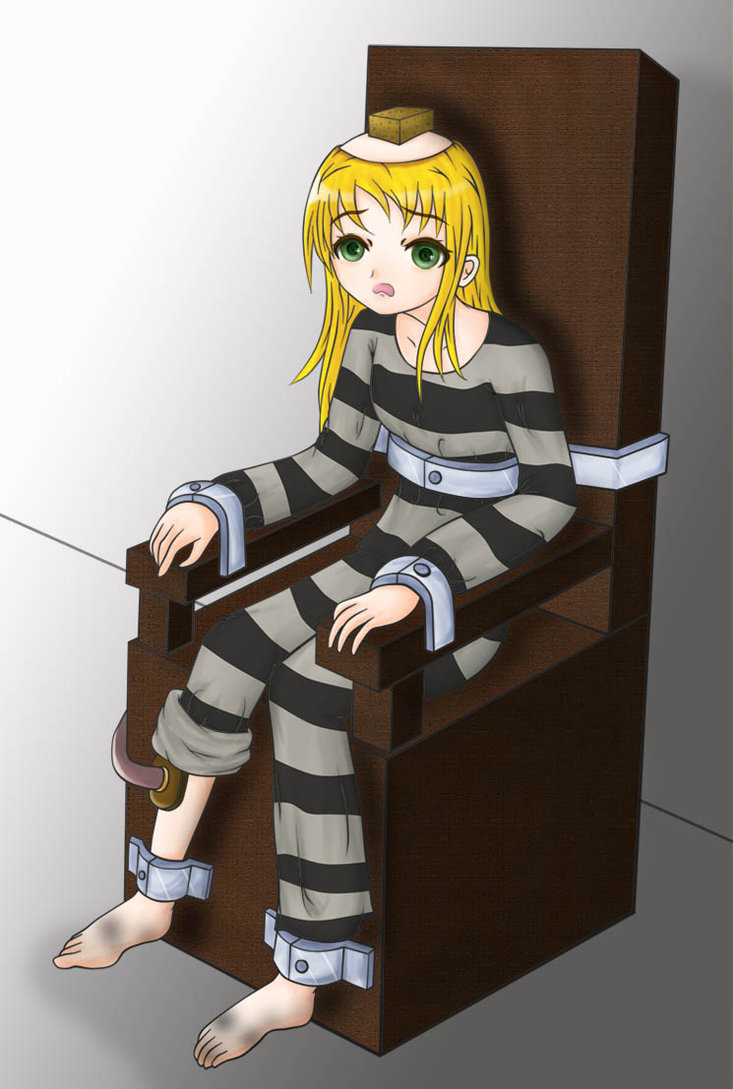
CAS Misandry
April 28, 2015 permalink
The Merriam-Webster dictionary defines misandry as a hatred of men. From the Kawartha-Haliburton children's aid society:
Sarah Kathleen Countrygirl Howe
A CAS worker told me that my boyfriend, who is the father of my children, is not allowed to change our boys diapers. She said it's a woman's job and men can be pedophiles but my boyfriend does not have any charges against a child at all. Is this allowed?
Source: Facebook, Stop the CAS ...
Lee Allan Bonneau R.I.P.
April 26, 2015 permalink
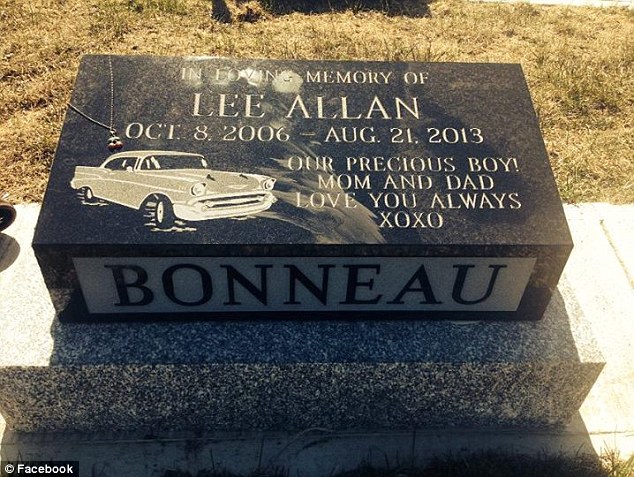
At the age of six Lee Allan Bonneau was taken from his parents by the province of Saskatchewan. Two and a half months later, while in the care of foster mother Mary Ramstead, he was attacked and killed by an older foster boy named only as LT. Lee's parents Dave Bonneau and Stacey Merk memorialized him with the tombstone above. How did the legal parents memorialize him? The province of Saskatchewan conducted an inquest into his death and the coroner published the Jury Findings (pdf). The report misspelled his name Allen.
Spelling a child's name wrong is commonplace for social workers. Best interest of the child does not extend to getting his name right.
JJ Back on Chemo
April 26, 2015 permalink
Last year Ontario courts allowed two aboriginal girls with leukemia to pursue alternative treatments instead of chemo therapy. Since then one of the girls, Makayla Sault, has died. [1] [2]. The cancer of the other girl, known only as JJ, has returned. Her family has decided to resume chemo therapy. Judge Gethin Edward has modified his ruling of last year, though the journalists do not state clearly what that modification was. Earlier articles on JJ: [3] [2].
expand
collapse
First Nations girl who used alternative treatment back on chemotherapy after leukaemia returns
BRANTFORD, ONT. — The legal wrangling has ended, but debate about a young aboriginal girl’s cancer treatment is likely to continue unchecked after new revelations about her condition emerged Friday at an extraordinary court hearing.
The girl had been in remission from leukemia, but the cancer returned last month and she has resumed chemotherapy, seven months after rejecting it in favour of native remedies and other alternative care, her lawyer said.
As the patient and her mother looked on, the judge who first ruled on the case in November then took the rare step of agreeing to change his decision at the request of lawyers involved in the affair.
The ruling controversially concluded the girl’s family had a constitutional right to choose traditional native medicine over conventional treatment for cancer. It was modified Friday to stress that a child’s best interests must always be paramount in such situations, though traditional treatments should still be respected.
Afterward, Justice Gethin Edward capped the unusual session — it is almost unheard of for a court to adjust its ruling long after the fact — by coming down from the bench to talk with the girl, her family, lawyers and others involved.
“This is a good day,” he said with a smile to Chief Ava Hill of Six Nations.
Evidence suggests that between 70 and 90 per cent of child leukemia patients can be cured with conventional treatment that includes chemotherapy; without it, the disease is usually a death sentence, medical experts say.
Another aboriginal girl, Makayla Sault from neighbouring New Credit First Nation, died in February after similarly pulling out of chemotherapy for leukemia.
Last year’s ruling, though, was embraced by many First Nations members as an overdue recognition of traditional ways and rights.
Paul Williams, the Six Nations parents’ lawyer, said his clients do not regret taking their daughter out of chemotherapy.
The girl can be identified only as J.J. because of a court-ordered publication ban.
“The family has always acknowledged that mainstream medicine was one of its options,” Williams said. “But there are good reasons why they made the decisions they made, and I don’t think any of them are mistakes.”
The family, the Hamilton, Ont., hospital where the girl was first treated, the local children’s aid society, Six Nations band and the family have been in closed-door talks with Ontario for five months, launched when the government belatedly got involved in the case.
The deadline for appealing Justice Edward’s decision was repeatedly extended as talks wore on.
“[But] people took what could have been a nasty confrontation … and Ontario said ‘We don’t need to appeal,’ ” Williams said.
As the girl’s cancer came back, the family concluded “chemotherapy, along with traditional Haudenosaunee (Iroquois) medicine, which J.J. had already been receiving, would be the next best step,” said the lawyer.
In a joint statement, Attorney General Madeleine Meilleur, the family and the reserve said Friday the case’s resolution lets the family move ahead with treatment, “using the best that both medicines have to offer.”
Juliet Guichon, a bioethicist and lawyer at the University of Calgary who studies legal conflicts over children’s health, welcomed the ruling’s modification, arguing that it had originally put constitutional rights above a child’s life.
“The fact that the parents have agreed to chemotherapy, along with traditional Haudenosaunee medicine, means that the child has a chance to live,” she added.
The case revolves around the second of two Southern Ontario girls, both 11, diagnosed last year with leukemia. Both started undergoing chemotherapy but then pulled out, saying they wanted to pursue aboriginal remedies instead.
They also attended a Florida alternative-health clinic, the Hippocrates Health Institute, which treats advanced cancer patients with vegan, raw-food diets and other unproven therapies.
J.J.’s family no longer has contact with that facility, Williams said Friday.
A local child-welfare agency refused requests to apprehend the children so they could be forced back into chemo.
The hospital took Brant Family & Children’s Services to court last fall over its decision regarding J.J.
Judge Edward declined to force her into chemotherapy, saying her mother has a right under the Constitution to pursue traditional medicine, even if it is not validated by “the Western medical paradigm.”
Williams explained that the patient’s health-care team now includes a senior pediatric oncologist and a Haudenosaunee (Iroquois) chief with experience in native medicine.
“The two paths of medicine began working together in a respectful and complex way,” he said.
Source: National Post
CAS and Police Extort Mother
April 25, 2015 permalink
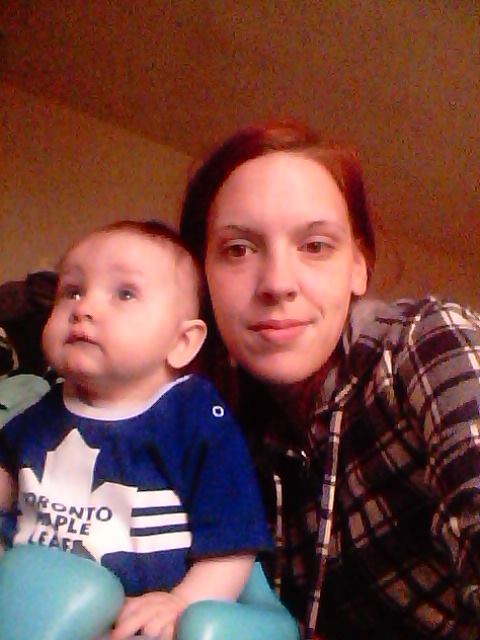
London Ontario police came to the home of Jasmine Leigh Brown looking for her boyfriend. She did not know where he was. Three hours later they returned with London-Middlesex CAS workers and a threat. Tell us where your boyfriend is or lose your child. Since she did not know, her child has been apprehended. Expand for the story in her own words.
expand
collapse
Jasmine Leigh Brown
The police came to my place looking for my old man because he has outstanding charges. I let them look in my place then the cops said it's jimmy your your son. I told them I'd call if I see him or if I knew where he was I'd tell you cops. Three hours later I get another knock on my door and it's the police again. I open the door and it's the police with CAS saying the police called and said I left my son alone in my apartment. If that was true I'd be charged. The police are playing games with me because I don't know where my boyfriend is. They said right to me that if I don't tell them where to find jimmy we will call CAS and have your kid taken. And that's the dirty game they did also two cops two workers NO APPREHENSION ORDER NO WARRANT. I asked for them to call the supervisor so I can confirm this and they wouldn't. Please help me I have had my son since birth I want my son back.
Source: Facebook, Stop the CAS ...
An unrelated item contrasts the protection of authorities with ordinary people. Jennifer Pawluck posted a picture of Montreal police Commander Ian Lafrenière with blood dripping from a bullet wound in his forehead. She has been convicted of criminal harassment. The son of Jasmine Brown was kidnapped, not for his best interest, but to extort compliance from his mother. The more substantive breach against Brown will get no remediation through the legal system.
expand
collapse
Woman convicted of criminal harassment for post threatening Montreal cop
A simple small click on a computer keyboard can have big consequences, a Quebec Court judge said Thursday after convicting a young woman of criminally harassing a police officer by posting a disturbing image of him on social media along with a threatening hashtag.
Jennifer Pawluck, 22, crossed her arms and appeared upset after Judge Marie Josie Di Lallo found her guilty of a crime. The young woman, who had no criminal record, was very active in the student protests against proposed tuition hikes in 2012 and was at a party in March 2013 where friends became upset after a discussion over police brutality. That same night she decided to post a photo she took, of a graffiti artist’s painting depicting Montreal police Commander Ian Lafrenière with a bullet hole in his forehead, on Instagram. Lafrenière was the very public face of the Montreal police throughout the protests because of his work as a spokesperson.
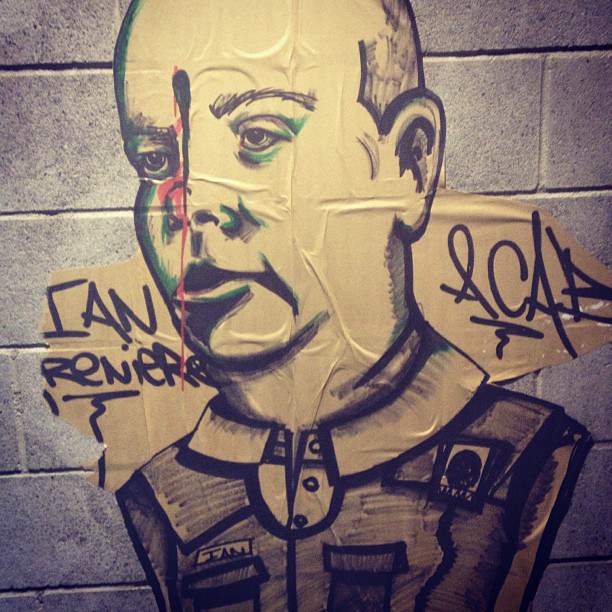 Image posted (and since deleted) on Instagram by Jennifer Pawluck.
Image posted (and since deleted) on Instagram by Jennifer Pawluck.Pawluck later added the hashtags “Un flic, une balle” (one cop, one bullet) and “All Cops Are Bastards” and made sure to get the spelling of Lafrenière’s name right (she had to correct it once). She also added a hashtag linking it to Montreal police social media pages.
During Pawluck’s trial in February, Lafrenière testified he was shocked when he first saw what Pawluck posted. He was searching social media after the Montreal police had handled an anti-police brutality protest in 2013. He also said that the student demonstrations of 2012 were the only time in his career that he felt threatened. His home address was posted on the Internet by someone and his family had to temporarily move out. He said seeing the image Pawluck posted, with the hashtags, was “the last straw.”
The case boiled down to whether Pawluck should have known a person would feel threatened by what she posted and whether Lafrenière has reasonable grounds to feel threatened. The Criminal Code makes clear that a threat doesn’t have to be repeated, and can involve one single action, in order to be considered criminal harassment. Pawluck testified that the posting was intended as a general criticism of the Montreal police and that she didn’t intend to threaten Lafrenière. She testified that she didn’t know who he was when she posted the image.
“To see his image with a bullet hole in his forehead is worrying, even if he is a police officer,” Di Lallo said as she read from her judgment. The judge also cast doubt on the veracity of Pawluck’s testimony by saying “it is very surprising” to hear someone involved in the 2012 student protests claim they didn’t know who Lafrenière was.
Prosecutor Josie Laplante said, after the verdict was read, that it wasn’t just the mere posting of the graffiti that constituted a threat in this case.
“On the photo there were links, or hashtags, with Ian Lafrenière’s name written in different ways and allusions like (all cops are bastards) and (one cop, one bullet) to the point where, given the context, there was criminal harassment,” Laplante told reporters.
“I think it is important that everyone pay attention to what they put on social media. It is very accessible, it is very easy (to access), that is what Judge Di Lallo mentioned in her decision. I think we all have to pay attention to what we post because (some people) don’t consider the impact it can have on other individuals.”
The charge is a summary offence and carries a maximum six-month sentence. Pawluck’s case enters the sentencing stage on May 14.
Source: Montreal Gazette
Jane Fitzgerald Quits, New Executive Director Needed
April 25, 2015 permalink
Jane Fitzgerald has retired as executive director of the Children's Aid Society of London-Middlesex. Some earlier articles suggest mismanagement that may have precipitated the retirement. [1] [2] [3]. For candidates aspiring to replace Mrs Fitzgerald, the qualifications are similar to those for replacing Peter Ringrose.
expand
collapse
Executive director of London Middlesex Children's Aid Society Jane Fitzgerald stepping down
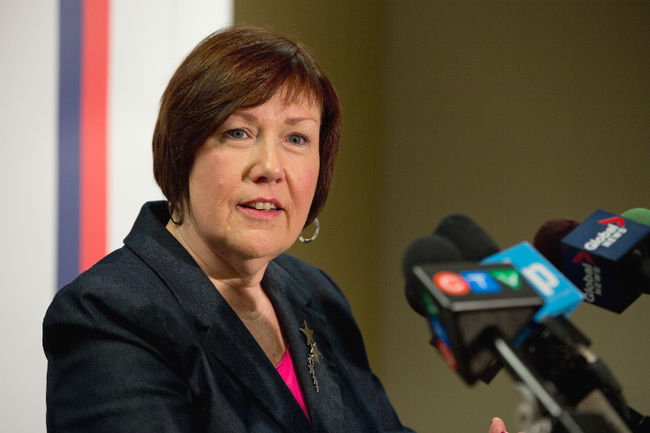 Children's Aid Society executive director Jane Fitzgerald is retiring.Free Press file photo
Children's Aid Society executive director Jane Fitzgerald is retiring.Free Press file photoAfter more than two years of controversy, London’s child welfare agency is searching for a new boss.
Jane Fitzgerald, executive director of the Children’s Aid Society of London and Middlesex, is leaving the post May 11, said acting director Regina Bell.
“Jane has made a decision to retire . . . She will not be returning,” Bell said Thursday.
Fitzgerald has been on medical leave since October.
Bell said the board asked her to continue as director until her retirement in October 2016.
Fitzgerald’s departure comes on the heels of a scathing provincial financial review, obtained by The Free Press, that found the CAS top-heavy and wasteful.
“It’s a relief to finally have an answer as to what is happening,” said Karen Cudmore, president of OPSEU Local 116 that represents CAS workers.
Workers are eager to turn the page on more than two years of controversy since details of Fitzgerald’s salary, and the inflated numbers for senior managers, came to light, Cudmore said.
“It’s a new atmosphere of openness and co-operation. It’s a very inclusive process among the staff and community groups. It’s a new start and for the membership, that’s a good thing.”
In 2013, reports surfaced that Fitzgerald was Ontario’s highest-paid child welfare agency boss earning $212,717, more than the executive director at the Toronto CAS. At that time, local CAS executives received raises — some more than $20,000 and $30,000 — as its front-line workers faced massive job cuts and a pay freeze.
Its list of managers on Ontario’s list of public servants paid $100,000 or more grew to 22 in 2012 from 19 the year before, and all made more than the year before at a time of budget cuts.
The CAS also failed to balance its budget in 2013, running a deficit despite one-time funding of $3.9 million from the Ministry of Family and Children’s Service.
That forced a review that revealed the agency spent $300,000 on renovations to rented offices, $174,000 on consultants, $50,000 on taxis and $19,600 for 23 iPad tablets. Its average cost of managing cases was $12,000 higher than other agencies.
Source: London Free Press
Most Missing Persons are Foster Kids
April 25, 2015 permalink
Manitoba opposition leader Brian Pallister has disclosed that most missing persons in his province are foster children.
expand
collapse
Majority of missing people are CFS kids: Tories
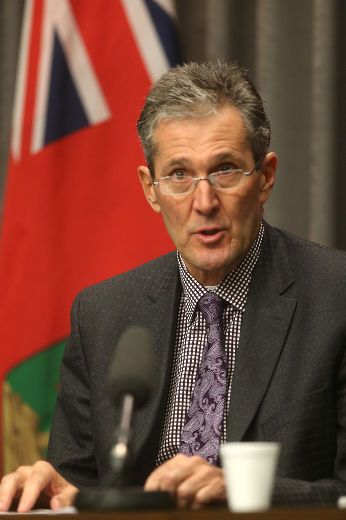 Brian Pallister says a majority of missing person cases in Winnipeg last year involved kids in CFS care.Chris Procaylo/Winnipeg Sun file photo
Brian Pallister says a majority of missing person cases in Winnipeg last year involved kids in CFS care.Chris Procaylo/Winnipeg Sun file photoNew information released by the opposition Tories shows the majority of the over 6,500 people reported missing in Winnipeg last year were youth in the care of Child and Family Services.
And the number has climbed over the past five years.
At a press conference on Tuesday, Tory leader Brian Pallister and his family services critic, Ian Wishart, argued the Selinger government is failing in protecting kids in care.
“The fact that these children are reported missing means they are not receiving the care they desperately need and deserve,” said Pallister.
According to a January Winnipeg Police Board brief, more than 6,500 people are reported missing each year and “most are vulnerable youth who are in the care of Child and Family Services.”
In total, according to the Canadian Police Information Centre’s statistical report, 6.458 children and youth were reported missing across the province in 2014.
The Tories also noted in the last five years, the total number of reported missing children and youth has increased by 22% in the province, while the average in Canada has decreased 20%.
“We are headed in the wrong direction ... so we compared ourselves to other provinces and found that we were way higher than any other province out there,” Wishart said.
According to federal statistics, girls in Manitoba are six times more likely to be reported as runways than across Canada, the Tories noted.
Wishart said 15-year-old Tina Fontaine, who was tragically murdered last summer, has become the face for at-risk youth who run away. Fontaine was under the care of CFS at the time of her murder and had recently run away from her foster home.
Family Services Minister Kerri Irvin-Ross said one child going missing or running away is one too many.
“However, one thing that needs to be clear is that the vast majority are returned within 48 hours and that happens because of the co-operation between Street Reach and the Winnipeg Police Service,” she said. “We are very quick to post a picture and give a description and ask Manitobans to help find the children.”
She also said the figures are only the amount of reports filed and often chronic runaways in the system are reported multiple times throughout the year, inflating the numbers.
“Some families in our province are experiencing a multitude of challenges and barriers and I think as a society we need to address the issues related to poverty, to residential schools, to colonization and the ‘60s scoop,” she said.
Source: Winnipeg Sun

Orange County CPS Sued
April 24, 2015 permalink
A lawsuit has been filed against child protective services in Orange County California. Expand for the press release. Here is a copy of the complaint: Randall vs Hammond (pdf).
The suit is on behalf of BR and 5000 unnamed plaintiffs in the same circumstances. If lawyer Shawn A McMillan cashes in they way he did for Deanna Fogarty-Hardwick, damages could reach $48 billion, enough to get the state of California to change policy.
expand
collapse
Class Action Lawsuit Filed Against Orange County (CA) Child Protective Services Alleges Unwarranted Seizure of Thousands of Children
Today, the Law Office of Shawn A. McMillan has filed a class action lawsuit against Orange County Child Protective Services alleging that the agency has seized more than 5,000 children without obtaining warrants as required under the 4th and 14th Amendments to the United States Constitution.

Attorney Shawn A. McMillan, of the Law Office of Shawn A. McMillan, filed a Federal Lawsuit in the Central District of California, Southern Division on April 20, 2015 (case number 8:15-cv-00626). The lawsuit alleges that the Orange County Child Protective Services Agency took a young boy from his mother’s home in the middle of the night without any justification, and without first obtaining a warrant. The Class Action complaint also alleges that as a matter of practice the agency frequently removes children from the custody of their parents without first obtaining a warrant where no emergency exists, and has done so for at least five years.
Lead plaintiff B.R. sued Orange County and Social Worker Myeshia Hammond, and all similarly situated county social workers, in his April 20, 2016 lawsuit.
The lawsuit claims that B.R. is one of thousands of children wrongfully taken from their parents by county social workers.
B.R. seeks class certification, an injunction and compensatory, statutory and punitive damages for civil rights violations.
Shawn A. McMillan
The Law Office of Shawn A. McMillan, APC
4955 Via Lapiz
San Diego, CA 92122
858-646-0069Source: PRWeb
Un-Munchausen by Proxy
April 24, 2015 permalink
In 1996 Florida accused Kathy Bush of intentionally harming her own daughter, the medical theory of Munchausen by Proxy. Daughter Jennifer Bush went into foster care and Kathy went to jail. Today mother and daughter have reunited, and daughter Jennifer has rebuffed the Munchausen accusation. Sadly, the reconciliation does nothing to restore Jennifer's lost childhood.
expand
collapse
Years after case, Jennifer Bush says she wasn't a victim of Munchausen or abuse by her mom
It was a heartbreaking case that ripped a 9-year-old girl from her South Florida family and sent her mother to prison for years.
Exactly 19 years ago today, Jennifer Bush was placed in state care amid allegations that her mother, Kathy Bush, was deliberately making her ill in an unusual — and some say now discredited — form of child abuse called Munchausen Syndrome by Proxy.
After shunning attention for years, Jennifer Bush is publicly defending her mom for the first time and agreed to release a written statement this week and answer a few, limited follow-up questions from the Sun Sentinel.
"Jennifer made it very clear: She thinks her mother never abused her," said Fort Lauderdale lawyer Robert Buschel, who defended Kathy Bush in her criminal trial and is the representative Jennifer Bush picked to relay her response to questions.
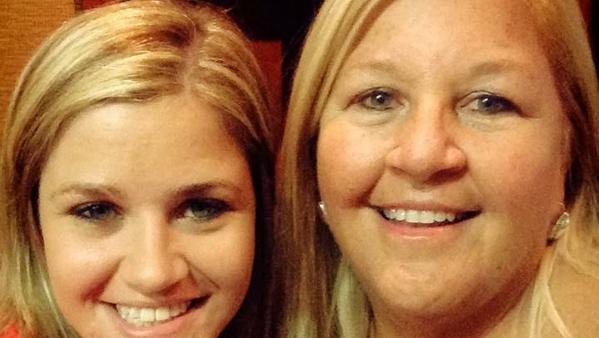 Jennifer Bush, now 27, and her mom, Kathy Bush, photographed together in 2015. They have been reunited for years and Jennifer says she does not believe her mother abused her.Sun Sentinel/Family photo provided by Jennifer Bush
Jennifer Bush, now 27, and her mom, Kathy Bush, photographed together in 2015. They have been reunited for years and Jennifer says she does not believe her mother abused her.Sun Sentinel/Family photo provided by Jennifer BushThe Coral Springs family's story fascinated and polarized the community for years, generated dozens of headlines internationally and featured on national TV.
Many thought the little girl was secretly abused by a mother who caused her to undergo dozens of unnecessary medical procedures and surgeries. Others believed it was a clear case of government overreach by state child welfare workers who split the family and prosecutors who filed criminal charges.
Jennifer Bush never appeared in court, never testified against her mom and never publicly discussed the case. Authorities kept her out of view, and out of state, for years while she moved between foster homes and shelter care. When she was old enough, she made it clear she did not want to be in the spotlight.
Now 27, she is happily married and has fully reunited with her parents, Kathy and Craig Bush, who live in Georgia, and her brothers, Matthew and Jason. She still fiercely protects her privacy and does not want to reveal where she lives.
Despite all the public speculation about the case and her mother, Jennifer Bush thinks it is so obvious that her mother did not abuse her that she included no reference to it in her initial prepared written statement. She only made it clear she believes her mother is innocent when the Sun Sentinel asked the question.
Bush wrote that April 15, 1996, changed her life forever.
"That was the day that I was taken from my home and my family, but that day has not changed how close my family continues to be. The 10 years I spent in foster care were traumatic, and I had some devastating things happen to me. However, I persevered because of all of the angels that were there for me during these difficult times. These people helped shaped the woman I have become today," she wrote.
"Today, I can proudly say my family is extremely close knit. We have flourished despite the devastating separation. The bond I had with my brothers, prior to being removed from my family, is something that never changed. My relationship with them helped carry me through my years in foster care. My parents and I have picked up from where we left off, and have a very close and loving relationship."
Bush's time in foster care was difficult but inspired her to try to fix the system's problems herself. She became a social worker and says she hopes to become a foster parent herself soon.
"Today, I am living my dream as a social worker and changing the lives of the children and families I am working with today. I am married to my high school sweetheart, who has walked along side me for the past 10 years. I get a lot of joy making memories with my family, and making a difference in my community. Although this isn't always a happy anniversary, it is a day to celebrate my family and who we are today."
Kathy Bush, who prosecutors argued was motivated by a desire to seek attention and publicity for herself by making her daughter ill, sent a one-sentence reply to an email requesting comment from her and Craig: "We are very proud of Jennifer and our sons, they have all grown up to be fine adults and dedicated their lives to serving others."
She declined further comment. The couple's sons both worked as firefighters and Jason Bush served in the U.S. Marine Corps and was stationed in Iraq during the war.
Buschel, the lawyer, said he thinks Munchausen Syndrome by Proxy was a flawed "diagnosis du jour" that has mostly fallen out of favor with medical experts. He said he has since represented other families who faced similar allegations but persuaded investigators that no crimes were committed.
"It's nice to see the government didn't succeed in destroying this family," Buschel said. "It's just good to see that Jennifer took her ordeal — of being separated from her family — and she really turned it around so that now she's helping other kids and parents."
The Bush family's ordeal began early in Jennifer's life when she appeared to be chronically ill with digestive problems, seizures and a host of related illnesses.
Before the abuse allegation surfaced, the little girl, sometimes dressed in a ballet tutu or baseball fan gear, and her mom were featured in newspaper articles about her illness.
They organized fundraisers to help pay her massive medical bills, were feted by sports stars and even visited the Clinton White House where they were invited to raise awareness about health care costs.
In April 1995, police and child welfare investigators began looking into a complaint made by a health care worker who suspected Kathy Bush might be intentionally causing her daughter to become ill by secretly giving her extra doses of medicine, infecting her and interfering with her treatment.
In her first eight years, Jennifer had spent 640 days in hospitals and underwent 40 medical procedures and 1,819 nonsurgical treatments, investigators said.
Authorities arrested Kathy Bush on abuse charges after a year of investigating. The same day, child welfare workers took Jennifer from her elementary school into state care. Authorities said her health improved immediately; the family said she'd been getting better for some time before she was taken away.
Jennifer Bush moved between several state shelter care homes and foster homes during the next several years while her mother battled criminal charges. Through it all, Bush's husband and their two sons managed to maintain their support for both Kathy and Jennifer, never wavering in their belief that Kathy was innocent and both needed to come home.
After a long, arduous trial in Broward Circuit Court in 1999, jurors found Kathy Bush guilty of aggravated child abuse. The judge only allowed fleeting references to Munchausen in the trial and jurors said they gave it little attention but believed Bush had harmed the girl.
Bush was later sentenced to five years in state prison. She appealed but lost. She was released in June 2005, after serving more than three years of her sentence. When state authorities moved to terminate her and her husband's parental rights to Jennifer, Bush initially fought but reached a settlement that cut her rights to the child but allowed her husband and sons to continue visiting Jennifer.
Courts barred Kathy Bush from seeing Jennifer for about six years, starting in 1999, but they began writing letters, supervised by a therapist, in 2004, and Jennifer asked to be allowed to resume seeing her mother in 2005 when she turned 18.
Broward prosecutors did not oppose her wishes and said they believed they had protected her until she was old enough to make her own choices.
As Jennifer Bush moves on with the happier phase of her life, she offered words of encouragement to other foster children who struggle:
"The odds are often against you to be successful in life. I challenge you to rise up against those odds, and be the very best you can be with the circumstances you are facing. Don't be ashamed or embarrassed to get the extra help that is offered, you will be thankful that you did in the future. There were many times that it would have been easier to give up, but it's persevering against the odds that makes it even more fulfilling. Speak up for yourself, be your biggest advocate, and be proactive. At the end of the day we owe it to ourselves. Don't let your current circumstance shape your future, and never doubt yourself!"
Source: Broward County Sun Sentinel
British mother Lorraine Hatfield was also falsely accused of Munchausen and forcibly separated from her son. They reunited a decade later but the trauma drove her to suicide.
expand
collapse
Suicide of ‘loving mum’ Lorraine Hatfield who suffered depression after wrongly accused of harming child
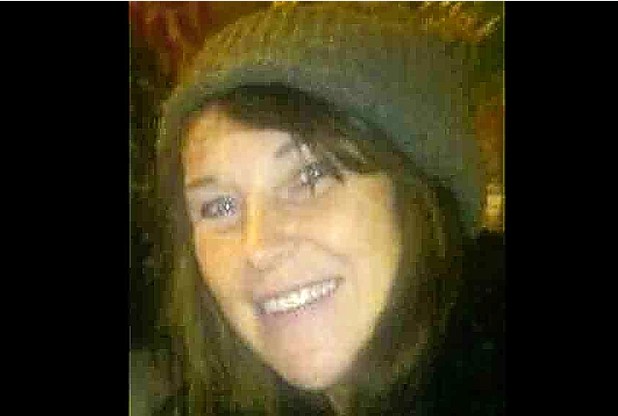 'LOVING MOTHER': Lorraine Hatfield took her own life after spiralling into depression when wrongly accused of having Munchausen syndrome by proxy
'LOVING MOTHER': Lorraine Hatfield took her own life after spiralling into depression when wrongly accused of having Munchausen syndrome by proxyA LOVING mother who spiralled into depression after being wrongly accused of harming her child committed suicide, an inquest heard.
Mother-of-three Lorraine Hatfield, 48, was found hanged in her bedroom by her 19-year-old son Billy Steinman, two days after celebrating Christmas with her family.
Ms Hatfield, of Sewerby Court in Bridlington, had dedicated her life to caring for her children but was plagued by long term mental health problems, which led to her death on December 27 last year.
Ms Hatfield's eldest son Luke Steinman, 25, said he thinks many of his mother's problems stem from a false allegation that she suffered from Munchausen syndrome by proxy.
"I don't think she ever got over what happened," Mr Steinman said.
"I was sent to live with my grandparents because they thought mum was making me ill."
The allegation that she was harming her eldest child in order to seek attention from medical professionals was made 15 years ago when doctors failed to diagnose the cause of Mr Steinman's allergy-related illness.
He said his mother developed a deep mistrust of the NHS after he was removed from her care when she was wrongly accused of making her son ill.
Mr Steinman says this mistrust of mental health professionals contributed to her not receiving the care she needed.
"I don't think she received the right level of care, because nobody could understand the gravity of her situation or the root of her illness," Mr Steinman said.
"There was no sense of empathy or understanding of her situation. What she really needed was someone in the medical profession who she could develop a relationship with and trust.
"But it was different faces all the times and different people coming to the house."
Her daughter Jodie Steinman, 22, described Ms Hatfield as "a loving and caring mum".
"Our relationship with mum was perfect when we were growing up," she said.
"She was always taking us on trips and doing educational things.
"We are a very close family. Her death has had a big affect on me and my two brothers and she will be greatly missed by all of us."
Miss Steinman said her mother was a very intelligent and artistic woman who specialised in portraits.
However, an inquest into her death heard she became increasingly paranoid and delusional.
She was sectioned after a breakdown in July last year, but was treated by nursing professionals at her own home until being discharged from mental health services several months before her death.
Coroner Paul Marks recorded a verdict of suicide.
Syndrome explained
Munchausen's syndrome is where an individual pretends to be ill, or deliberately makes themselves ill, usually to gain the attention of medical professionals.
Munchausen's syndrome by proxy is used to describe a syndrome where a person deliberately makes another person, usually a child or dependent, ill or fabricates an illness.
Fabricating an illness on behalf of a child or elderly relative is considered a serious form of child abuse or neglect.
Source: Hull Daily Mail
Inside a Child Welfare File
April 24, 2015 permalink
Kane Blacque grew up in Alberta foster care. In 2014 he requested his child welfare file. Ordinarily social service agencies resist disclosure of these files, but Blacque was successful in getting the whole box of documents. A reporter for the Edmonton Journal examined the file and spoke to Blacque. The enclosed report is a rare look inside a child welfare file.
Blacque had an unusual view of adoption. When he was seven years old he was placed with an adoptive family. The file is filled with lies told to the adoptive parents. The move was not a positive experience for Blacque. He lost his friends in his foster home, and left with the belief that his foster father had rejected him. The adoption failed when the adopters realized Blacque was gay.
Here is a copy of the accompanying Video by Ryan Jackson (mp4).
expand
collapse
Former foster child finally able to shed light on past filled with abuse, drugs and depression
EDMONTON - The old 1982 TV images have faded in colour, almost to sepia tones. But the video opens on images of two well-groomed little aboriginal boys, their dark hair shining, their eyes bright, as they explore the Storyland Valley Zoo, riding the tiny train past the old Indian village with its tipis, sticking their heads inside the mouth of the giant whale. The older boy grins up at the camera — and the camera loves him right back.
It’s a vintage clip of Wednesday’s Child — the CTV feature designed to convince Albertans to adopt children in need.
The TV presenter gushes that these two little boys “are so cute, you want to scoop ‘em up and pack them home right away.”
“They are two of the most well-behaved little boys I’ve ever met,” says the pretty white presenter, as she earnestly encourages TV viewers to adopt the brothers as a set.
“They’re healthy and sharp as tacks. They need a family who will appreciate their spunk and humour.”
It’s a sentimental image of happy children frolicking — designed to pluck the strings of the coldest heart.
The reality behind those images?
Far colder than most cosy TV viewers could imagine.
Kane Blacque, 39, is sitting across the table from me at a busy breakfast restaurant. He’s handsome, well-dressed, with a cherubic round face and the same mischievous grin he sported as a child.
These days, he’s a local gay rights activist, a competitive karaoke singer, and a senior account executive with a national magazine based in Edmonton.
He lives in a comfortable suburban townhouse with his partner, a buttoned-down business executive.
Sitting on the table between us is a large cardboard banker’s box.
“This box holds my life,” says Blacque. He’s not kidding.
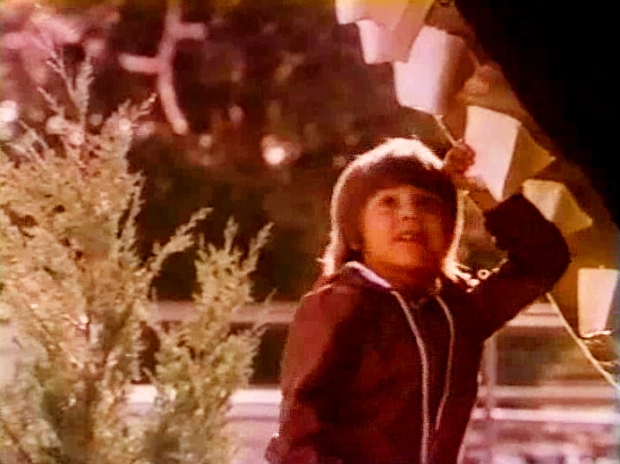 Photo: The boy who would grow up to be Kane Blacque, in a 1982 Wednesday’s Child adoption video, shot at the Edmonton’s Storyland Valley Zoo..
Photo: The boy who would grow up to be Kane Blacque, in a 1982 Wednesday’s Child adoption video, shot at the Edmonton’s Storyland Valley Zoo..Blacque is what you might call a survivor of Alberta’s child welfare system. He was in and out of protective care from infancy to the age of 18, when he “aged out” of the system.
It was a life, as he remembers it, full of neglect, violence, sexual and physical abuse, of homophobic bullying, drugs and alcohol, depression, suicide attempts, life in the sex trade and on the streets.
Last August, Blacque filed a Freedom of Information request with Alberta Human Services to see his entire child welfare record. That’s what’s in the box. That’s what he wants to share.
Normally, child welfare records in Alberta are strictly sealed. The media and the public never get to see them, not even in a case where a child dies in care. For a journalist to able to read an entire case file is almost unprecedented.
Digging through the pages and pages in the box is like conducting a kind of social autopsy. Except in this case, the abused child, the kid on the path to being a statistic, beat the odds. He survived, overcame, and lived to tell his tale.
Kane Blacque’s story begins years before he was born, with his mother Theresa Marie Desjarlais.
She was born in Bonnyville in 1959, and grew up near Wolf Lake, home to what was then known as the Wolf Lake Métis Settlement. The fifth of 10 children, she was raised largely by grandparents in a one-room house.
Her grandfather, she later told Edmonton Journal columnist June Sheppard, taught her to trap and snare. Her grandmother taught her to pick wild berries.
But in 1960, the provincial government officially “disbanded” the Wolf Lake settlement, and started to force out the land’s traditional people.
Desjarlais was five when her father, who was later described in court documents as “a repeated rapist,” abandoned the family. She was 11 or 12 when she was brought to Edmonton by her mother, who had a serious drinking problem.
Dejarlais told Sheppard in a 1980 interview that she was raped as a child by a cousin.
Eventually, she ended up as a permanent ward of the government.
In 1975, at the age of 15, while still under provincial guardianship, she became pregnant with her first child, the boy who would grow up to be Kane Blacque.
(That wasn’t his birth name, nor the name he was given by his adoptive parents. But it’s the name I’ll use throughout this story, for clarity’s sake, and to protect the privacy of his surviving siblings.)
Blacque was born in January 1976.
His birth certificate lists his father as Johnny Cardinal, aged 30. But child welfare records hint paternity was uncertain.
The young mother had only a Grade 5 education. She was addicted to alcohol and sniffing glue. Because she was homeless, child welfare authorities housed her and her infant son in a motel temporarily.
The baby was apprehended by child welfare authorities in October 1976 at his mother’s request.
He was made a temporary ward of the province, and moved from foster home to foster home. But in March 1977, he was returned to his mother, who was living with a new boyfriend and his mother.
Social workers who visited the home noted the boy had bruises and burns on his body, and that his mother seemed unconcerned and neglectful.
Nonetheless, the province returned the boy to his mother’s custody and closed his child welfare file.
Six months later, just after her 18th birthday, Theresa Desjarlais gave birth to her second child, Samantha.
Mother and daughter didn’t bond. A month after Samantha was born, Desjarlais asked child welfare workers to take Samantha away.
She was judged by workers to be “immature” and “a very poor parent” with “a marked capacity to be aggressive.” Social workers finally took Samantha and put her under temporary wardship for eight months. They left Blacque with his mother and her abusive boyfriend.
“He’d use a bullwhip or a stick or his belt,” said Desjarlais in a 1980 interview at the Remand Centre. “But he didn’t do it all the time. He didn’t like me swearing and did it for that, and once he gave me a black eye for glue-sniffing.”
Despite the chaos in the home, in October 1978 child welfare workers returned Samantha to her mother. A month later, Desjarlais gave birth to another boy.
Things went downhill rapidly, as Desjarlais tried, and failed, to cope with raising three children under the age of three.
On Dec. 17, 1978, someone called the child welfare crisis line with a tip that the children were being abused and the adults in the home were sniffing glue.
Police and social workers arrived, and noted that Samantha had bruises. But Desjarlais insisted she was a good mother, and that the apartment only smelled of glue because she and her friends had been building hobby models.
Workers left all three children in her care.
Three weeks later, Samantha was hospitalized with severe head trauma. Court records say Desjarlais showed no emotion when the ambulance picked up her daughter.
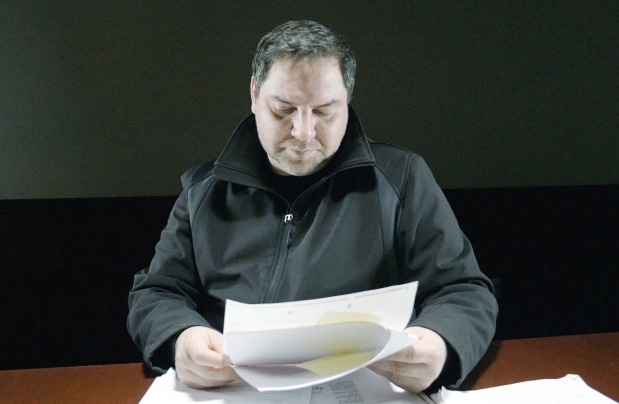 Photo: Kane Blacque, a former foster child, reads through copies of his child welfare records. In 2014, Blacque filed a Freedom of Information request with Alberta Human Services to see his entire child welfare record.
Photo: Kane Blacque, a former foster child, reads through copies of his child welfare records. In 2014, Blacque filed a Freedom of Information request with Alberta Human Services to see his entire child welfare record.Doctors operated on the child to relieve brain swelling but the little girl died on Jan. 12, 1979, aged 14 months.
Desjarlais later confessed that she had repeatedly thrown the toddler to the ground in frustration and fury.
“All right, all right, I threw her twice to the floor — I was mad. She was crying,” Desjarlais later told police. “I picked her up, stood up and threw her from living room to kitchen between the doorway. (She) landed on her head and back, screaming. Bent down, picked up again, stood up, and threw to the floor again about three feet away, shoulder high.”
Child welfare workers didn’t apprehend Desjarlais’s two sons for 10 days after Samantha was rushed to hospital.
That same day, Desjarlais was arrested and charged with second-degree murder.
It was just 10 days before Kane Blacque’s third birthday.
Various experts have told him he couldn’t possibly remember those events. But he insists his memories are quite clear.
“I remember it. I remember the whole situation. I remember her throwing my sister against the wall, though — not the ground. But who knows? Lots of things got thrown against those walls.”
At trial, Desjarlais pleaded guilty to manslaughter. She was sentenced to three years, but the Court of Appeal reduced the sentence to two years, less a day.
“The social history reveals an almost unbelievable level of crime, violence and addiction in her parents and many siblings,” said the court, quoting from a report written by a forensic psychiatrist who examined Desjarlais.
“It is quite clear from her social history that she has lived in an atmosphere of violence and absence of any accepted rules and regulations. The solutions to problems within her family of origin … were brutality and the survival of the strongest. Her lack of guilt feelings with respect to the injuries inflicted on her daughter have to be seen within this context. If she has no respect for the law it is because she has never learned any.”
By then, the Edmonton Journal reported, Samantha’s two brothers, and another baby boy, who had been born to Desjarlais while she was in jail, had all been taken into government care.
But Kane Blacque’s problems were far from over.
Blacque and the older of his two half-brothers were placed together in a foster home in Edmonton, with parents who had a reputation as firm disciplinarians.
At first, records show, Blacque seemed to do well. He had significant speech delays, which social workers and doctors attributed to his chaotic early home environment. And he was tiny, possibly malnourished, only in the fifth percentile for height and weight.
But in his foster home and in school he made huge strides. He was soon a talkative little boy, hitting all his developmental milestones.
But as he spent more time in the foster home, the records show, he became withdrawn and anxious. His foster mother, social workers reported, was actively sabotaging attempts to have him adopted, and refusing to take him for play therapy.
Years after, the foster father would be arrested and charged with sexual assault and sexual interference, after he allegedly molested a young child. Those charges were later stayed.
However what Blacque later remembered was being molested and anally raped, repeatedly, by one of the older children who also lived in the foster home.
Finally, in the autumn of 1982, child welfare workers, eager to get the children out of the foster home and into a permanent placement, had them featured on the Wednesday’s Child TV segment.
The television promo worked. In 1983, Blacque and his half-brother were formally adopted by a family from the Edmonton region.
Initially, the social workers’ notes suggest, Blacque was upset. He asked if he was being given away because he’d been “bad.” He asked if his foster father now hated him. Records show he seemed unusually attached to one of the older boys in the foster home, though social workers made nothing much of this at the time.
Still, the files show the adoption seemed to go well.
“Initially (the child) was resistant in relating to (his adoptive father) but is now first out the door for ice fishing, etc.,” wrote one social worker in January 1983, just days before the boy’s seventh birthday.
“There have been no behaviours such as tantrums, bed wetting, sleep disturbances, etc. (The adoptive parents) cannot believe their luck in getting two such lovely children. A very satisfactory placement.”
Four months later, the reports were even more glowing.
“(The child) is making excellent progress in school, being in the top 10 percentile in marks. He has really blossomed.”
But there were worrisome signs, too. Trips to see his former foster family left the boy angry and disturbed, acting out and refusing to visit them again.
And curiously, the records provided to the adoptive parents made no mention that the two boys had been raised by an abusive mother, nor that they’d been in the house when their mother killed their sister.
Instead, the adoption report described Theresa Desjarlais in glowing terms.
“She usually took care of herself, was an excellent homemaker and was pleased when someone cared for her,” reads the report. “She was patient with her children and had a reserved personality.”
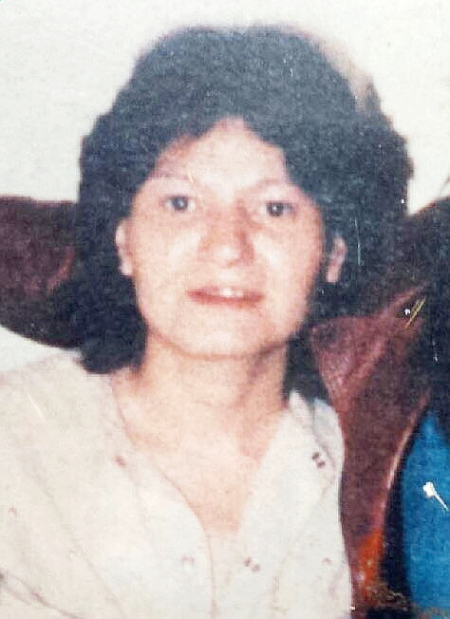 Photo: Kane Blacque's mother, Theresa Marie Desjarlais.
Photo: Kane Blacque's mother, Theresa Marie Desjarlais.There’s also no record the boy and his adoptive parents were offered support or counselling to deal with the fact that Blacque had spent his first three years surrounded by extraordinary violence. Nor is there any indication the department tried to help the two half-brothers maintain their aboriginal identity or connection to their Métis roots.
While early records describe Blacque as Métis, later files define him as Caucasian. His native identity was erased.
Once the boys were adopted, child welfare closed their files.
From the outside, things looked all right. Blacque took music lessons and acting classes. He won lead roles in school and community plays. On his report cards, his drama and music teachers praised his talent.
But his adoptive mother would later report that Blacque tried to kiss her open-mouthed, using his tongue, while still a little boy. Reading between the lines of the social workers’ later reports, it seems clear that his adoptive father, a big, rugged outdoorsman who loved fishing and camping, had a poor and distant relationship with his artistic adopted son, and favoured Blacque’s younger half-brother.
“My mother would enrol me in a dance class, and he’d pull me out and put me in baseball,” Blacque recalls. “She’d put me in music lessons, and he’d pull me out and put me in tae-kwon-do. He wanted me to be a man, and she wanted me to be me.”
But though Blacque and his adoptive mother had a very close relationship, it could also be a toxic one.
“When she got angry, she lost her mind,” he remembers. “It was rage. And she would start hitting me with whatever she could find.”
Nor was it easy to be a gay, aboriginal kid at his school outside of Edmonton. He was regularly bullied and beat up at school, regularly called a fag.
Things came to a head in 1989, the year he turned 13.
An Edmonton social theatre company, Catalyst, came to his school with a show designed to teach kids to protect themselves from sexual abuse.
When the play was over, his principal asked to speak with him. The teachers and cast had been concerned by his demeanour while the show was on. They asked him if he had ever been abused.
“As far as I can remember, I actually denied everything,” Blacque says.
Finally, he told them that he had been regularly molested in his former foster home.
The disclosure brought no relief or release. Instead, it blew his life apart. Child welfare authorities investigated his allegations, and informed police. But no charges were ever laid, in part, say the records, because Blacque had been so young at the time of the alleged assaults, and in part because the alleged assailant was himself a minor at the time.
And Blacque’s sexual orientation itself clearly made some people uncomfortable.
There are vaguely disapproving notes in his files about the fact that most of his friends were girls, and about his unusual interest in fashion. Some of the reports on the file worry about his “gender confusion” or what they call his “sexuality problem.”
In 1989, Blacque’s homosexuality was seen primarily as a psychological disorder, a pathology to be treated or overcome, not as a positive part of his identity.
Child welfare arranged for counselling for Blacque and his adoptive mother — his adoptive father, according to the reports, refused to come — but it doesn’t seem to have offered much help.
The 13-year-old started acting out, sometimes with physical and sexual aggression. Before the year ended, his adoptive parents decided they could no longer cope.
They asked child welfare workers to remove the boy from their home. Not long after, they and Blacque’s younger half-brother moved to another province. By 1991, the adoption was legally over. The province became his permanent guardian.
For Blacque, it was a dark and terrible time. In three years, he bounced through some 20 different placements: foster homes, group homes, youth centres, secure lock-ups, and supported living arrangements.
Sometimes he ran away. Sometimes his behaviour was so anti-social, homes refused to let him stay. There were allegations — unproven in court — that he’d sexually propositioned or pressured other residents.
By 14, he was a child prostitute, turning tricks for money and affection.
Yet his child welfare records are virtually silent about this. Workers obviously knew he was working in the sex trade. In a 1991 file, a caseworker notes that police confirmed the boy had been kidnapped and seriously assaulted by a “bad trick” — but there’s no record of intervention to try to get him out of sex work.
That same year, he was approached by an Edmonton man, Doug Butler, who promised to make him a movie star in a sexually explicit film about a gay boy’s coming of age.
Butler showed him a script and signed him to a formal-looking contract. Then, he asked him to “audition”. The sexual relationship went on for two years.
“He told me my co-star would be River Phoenix, and I believed him,” says Blacque ruefully. “He was that good.”
Butler was eventually charged and convicted of sexual exploitation, and sentenced to 30 months in prison. In 1999, after similar convictions involving other victims, including a case where he drugged a young man and raped him on camera, Butler was designated a long-term offender.
But Blacque’s child welfare records make no mention of his abuse by Butler.
Despite it all, Blacque auditioned and was accepted into the drama program at Victoria School of the Arts. Even while bouncing from group home to group home, he became an elite high diver with a competitive club. He recalls winning a bronze medal at the 1991 Alberta Summer Games in Stettler. One of his best memories of this time, he says, was coming home from the competition to find that the residents and staff of the safe house for teen prostitutes had made him a cake and organized a party to celebrate his medal.
Back then, MacDonald Drive, above Bellamy Hill, was part of the gay stroll where young male prostitutes plied their trade. Blacque recalls spending a lot of time outside the Edmonton Journal building trolling for clients. He’d go to class in the morning, diving practice in the afternoon, then pick up johns in the evening.
Eventually, his life unravelled. He dropped out of high school and quit diving. He was drinking, using drugs, acting out against other kids in his group homes. He was shoplifting, setting fires, turning tricks. There were multiple suicide attempts. Sometimes, he says, he’d steal from the Bay and then wave at the security camera, more interested in getting caught, in getting attention, than in what he stole.
“Treatment” didn’t seem to help. One psychiatrist, who treated him while he was at the Yellowhead Youth Centre, was dismissive.
“A lethal suicide attempt, however, can not be taken seriously,” he wrote in one report.
Later, the same psychiatrist reported that Blacque had “a well-developed personality disorder” with “anti-social, borderline, and histrionic categories.” He concluded that no psychiatric treatment was appropriate.
“He is clearly not suicidal nor mentally ill, but merely extremely manipulative.”
Others took a more charitable view.
“While (the boy) was being sexually abused, his ability to trust in people who had power over him was greatly reduced and was further diminished by the fact that when the abuse was revealed, the community and family response was not appropriately supportive,” wrote one psychologist. “The depth of betrayal (he) experienced consequently lead to his abandonment of any real trusting relationship.”
Wrote another therapist, “For all his bravado, it is clear that he feels a great sense of loss and abandonment and perhaps betrayal by the adoptive parents and many of his behaviours are related to those feelings.”
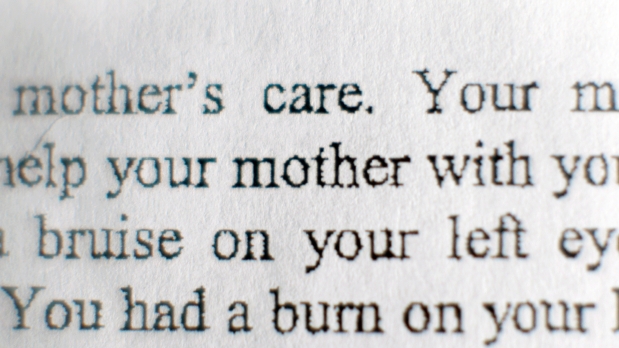 Photo: Details from Kane Blacque’s child welfare records. In 2014, Blacque filed a Freedom of Information request with Alberta Human Services to see his entire child welfare record.
Photo: Details from Kane Blacque’s child welfare records. In 2014, Blacque filed a Freedom of Information request with Alberta Human Services to see his entire child welfare record.At 18, he aged out of the child welfare system and his file was closed. He had his name legally changed to Kane Blacque.
There’s one more thing Blacque remembers about turning 18. That, as best he can recall, is when child welfare informed him that his birth mother, Theresa Marie Desjarlais, had died five years before.
Desjarlais served her sentence for the manslaughter of Samantha but there were lots of new arrests and convictions, beginning in 1982, the year she was released. In 1985, Desjalais was convicted of criminal negligence in the operation of a motor vehicle, common assault, and being unlawfully in a dwelling home. In 1987, she was convicted of possession of property obtained by crime and causing a disturbance.
Finally, in 1988, she was convicted of robbery, possession of a weapon and unlawful confinement, and sentenced to 822 days.
Desjarlais tried to commit suicide at the jail in Fort Saskatchewan by slashing her wrists. She was then transferred to the Lethbridge Correctional Centre.
On Oct. 17, 1989, she was seen by two psychologists, who found her extremely depressed, and wrote a report saying it was “paramount to get her psychiatric care.”
The next day, she was placed in solitary confinement after being found with drugs.
There were no cameras in the cells, but guards were supposed to check on her every 15 to 30 minutes. That night, according to a witness, she called out and told the guard she was going to string herself up. The guard reportedly yelled back, “Shut up, or we’ll restrain you.”
She tore apart the plasticized cover on her mattress, knotted the strips together, and hanged herself from the bars of a window.
She was discovered by the worried psychologist who’d opposed her move to solitary and had come to check on her.
She died four days later, shortly after being taken off hospital life support.
Her obituary in the Edmonton Journal made no mention of her four children.
She was just 30 years old.
On his own at 18, Blacque supported himself in the sex trade.
For a time, he was, he boasts self-mockingly, the highest-paid male escort in Edmonton. It was a very different life than picking up tricks on the street. The agency provided him with a car, driver and bodyguard.
Later, he left Alberta to work as an escort in B.C.
He battled addictions to drugs and alcohol. He made multiple suicide attempts. He moved back to Edmonton and was finally admitted to Alberta Hospital for electro-shock therapy, which helped with the depression, but disrupted his memory.
In 2005, he joined a class-action lawsuit against the province. The complainants were all survivors of the child welfare system who were suing the province, as their guardian, for failing to sue third parties who had injured or abused them.
But the class action, spearheaded by Edmonton lawyer Robert Lee, bogged down when Lee got into a dispute with two other class action specialists who were working with him on the case. The Alberta Court of Queen’s Bench finally removed all the original lawyers, and reassigned the case to an Ontario firm that specializes in class-action suits. A decade later, the case seems no nearer to being settled.
Blacque has received some money from the province’s victims of crime compensation program for the sexual abuses he suffered — but not what he feels he deserves. His appeals of that process continue.
It’s easy enough to understand Blacque’s anger at a system that failed him from the day he was born to the day he “aged out”.
And yet, flipping through all the hundreds and hundreds of pages in his child welfare record, it’s also plain that many well-meaning, dedicated individuals tried to help him.
When they failed, it wasn’t generally through malice or neglect or overwork, but perhaps more through deluded optimism. Case workers wanted so badly to believe that they’d done the best for the little boy, that he was in a safe place, that they blinded themselves to signs that things were terribly wrong.
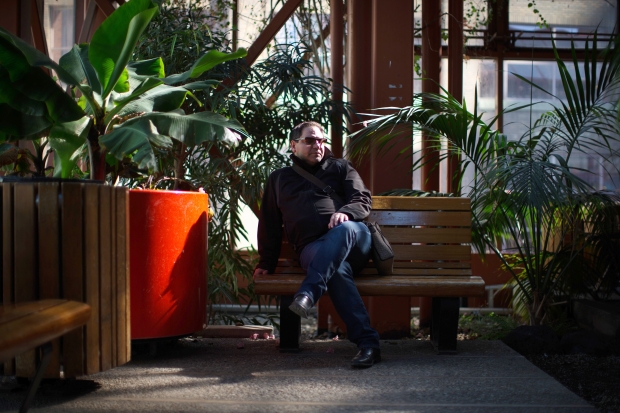 Photo: Kane Blacque in the Lee Pavilion at the Citadel Theatre. When he was young, Blacque would spend hours in this spot and think about his life.
Photo: Kane Blacque in the Lee Pavilion at the Citadel Theatre. When he was young, Blacque would spend hours in this spot and think about his life.It’s also clear that Blacque himself, angry and distrustful, with powerful feelings of abandonment, often lashed out at the very people who were trying hardest to help him.
Blacque was clever and articulate, charismatic and charming. And he often used that charm to con people.
“My files say, ‘He’s a very good manipulator,’” Blacque acknowledges. “Well hell, you had to be. That’s how I survived.”
Even today, he admits, it’s hard for him to make and keep friends. He sabotages relationships, is unwilling to trust people, behaves badly to friends and employers, in an effort to insulate himself from emotional pain and rejection.
Yet, despite it all, he survived — bruised, but unbowed.
“I did it by fighting, kicking and screaming,” he says.
His life in the sex trade behind him, he put his charm and his hard-won sales skills to work, instead, in advertising sales. He’s been drug-free for three years. Volunteering has also been therapeutic, whether he’s raising funds to fight AIDS, collecting for the Food Bank, or supporting charities that help the homeless, or advocating for children at risk.
“I believe in karma,” he says. “I’ve done a lot of bad things in my life and made a lot of bad choices, so I try to level that out with good things. I’ve taken so much from the community, I think it’s important that I give back.”
Clean and off drugs, in a loving, supportive relationship, with a meaningful job, and with the story of his life spread out in black-and-white before him, he’s feeling a little more in control of his destiny than he has in a long time — perhaps ever.
“This is the first time I’ve ever felt that I’m being heard,” he says. “Thirty-five years later, I finally get to tell my story.”
Source: Edmonton Journal
Long Arm of Child Law
April 23, 2015 permalink
American authorities reached over the border to forcibly grab Mexican teenager Alondra Luna Núñez from her parents. A Texas mother claimed the girl was her daughter. Authorities refused to believe the girl was who she said she was until DNA tests confirmed she was unrelated to the Texas claimant.
Think about this case. The United States claims the right to grab a child from anywhere in the world and subject her to American law.
In a related article Newsweek summarizes the theft of children of the Baltic states by other European countries. Policies that are routine within Scandinavia and Britain become international incidents when the victims are foreigners.
expand
collapse
Mexican girl who was wrongly seized and sent to US is reunited with family
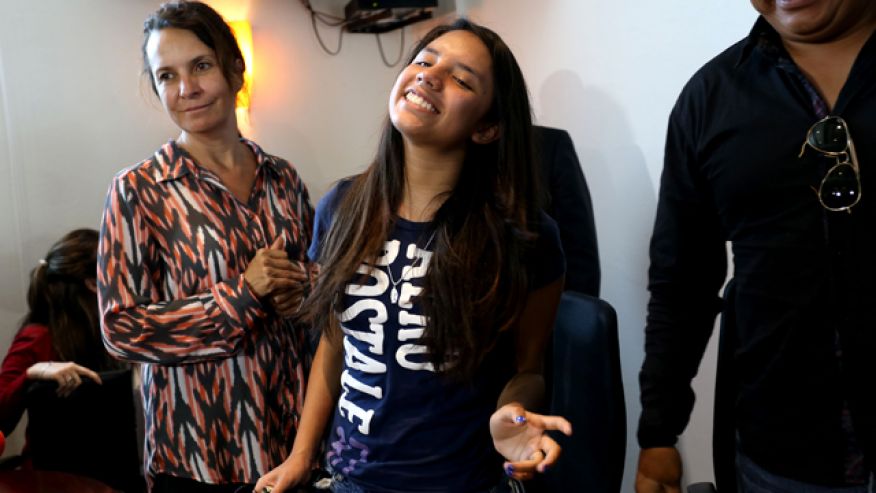 April 22, 2015: Alondra Luna Nunez smiles after attending a press conference upon her arrival to the Guanajuato International Airport in Silao, Mexico.AP Photo/Mario Armas
April 22, 2015: Alondra Luna Nunez smiles after attending a press conference upon her arrival to the Guanajuato International Airport in Silao, Mexico.AP Photo/Mario ArmasGUANAJUATO, Mexico – When a woman in Texas claimed that Alondra Luna Nunez was her long-lost daughter, the girl's real parents in Mexico say they presented more than a dozen documents from baptismal records and a copy of her birth certificate to family photographs. They were sure it was enough to demonstrate her true origins.
In the end, they say, Alondra was sent screaming to the U.S. based on a scar on the bridge of her nose resulting from a remote-control car mishap as a young girl. And they blame their traumatic weeklong separation squarely on the judge who made the final call.
"The other girl had a scar, but on the eyebrow, and I have one on my nose. I mean all this was stirred up over that," Alondra, 14, told The Associated Press on Wednesday at an emotional reunion with family after nearly a week away. "The judge said, 'No, it's her,' and that was that."
DNA testing proved Alondra was not Houston resident Dorotea Garcia's daughter.
The case drew international attention after a video of the distraught girl being forced into a police vehicle last week circulated in media and on social networks.
Judge Cinthia Elodia Mercado told the AP that she held to her obligation to make sure that international child-abduction conventions were followed.
"Our only job is to resolve whether the child needs to be returned or not," she said.
But the resulting drama touched not only Alondra's family in Mexico but also Garcia, who believed she had finally found her daughter, Alondra Diaz Garcia, taken from the U.S. illegally by her father nearly a decade ago.
That girl's whereabouts are unknown, and a felony warrant remains for the father, Reynaldo Diaz, who is suspected of abducting her from Houston in 2007.
Garcia, speaking to a Houston television station, said the first time she saw Alondra Luna, "I saw my daughter." She gave few details about how she ended up leaving Mexico with the girl, although she said she knows many won't look kindly on her actions.
"The people who know me don't need me to give an explanation for what happened," she said later to the AP. "Whatever explanation I give won't change the minds of people in Mexico or here."
Alondra said Garcia and the woman's family members apologized to her before she returned.
After Alondra flew into Guanajuato in Central Mexico around noon Wednesday, the family gathered for an afternoon and evening barbecue at her aunt's house. They celebrated with balloons, streamers and steak and chorizo sausage sizzling on the grill.
"Welcome to your real home, Alondra," read a homemade sign.
Wearing jeans, a gray T-shirt and a silver necklace with an image of the Virgin of Guadalupe, Alondra laughed and hugged brothers, cousins, aunts and uncles. As the sun went down in the hilly working-class neighborhood where they live, family and friends lit candles and recited the rosary on a sidewalk. Alondra wept as an elderly neighbor swept her into an embrace that lasted for minutes.
Garcia traveled to Mexico this year and said she had found her daughter in Guanajuato, prompting U.S. authorities to seek Interpol's help in retrieving her. She did not elaborate how, in her brief comments to the AP.
Many things remained unclear, including who called Interpol from the U.S.
On April 16, Mexican agents assigned to Interpol took Alondra from her middle school and transported her to a courtroom in the neighboring state of Michoacan, according to a statement from the federal Attorney General's Office.
Alondra's parents and Garcia each presented documents and gave testimony, then the judge ruled in favor of Garcia, ordering the girl into her custody. A court official, who was not authorized to speak to the press, said on condition of anonymity that Alondra's parents didn't present proper documents.
Alondra and Garcia went by bus to Houston, crossing at Laredo, Texas, with the birth certificate of Garcia's daughter and the court order, according to Mexico's Foreign Ministry.
"Anger. Rage. Powerlessness that they could tear my daughter from my arms. Sadness," said Susana Nunez, Alondra's mother. "I didn't sleep. I didn't eat. I said, 'How is my daughter, what is she doing?'"
Alondra said she was terrified at first, having never been so far from her parents, but was confident that ultimately the truth would come out and she would return. Still, her father, Gustavo Luna, said there were moments when he feared he might never see her again.
"A lot of things went through my mind ... at those moments you fear the worst," Luna said.
Alondra said she asked for a DNA test in Mexico but it was denied. The magistrate who ruled on the case said it wasn't within her authority to order one.
"We as judges are only responsible to resolve the case with respect to recovering the minor," Elodia Mercado said. "We don't do investigations or make inquiries."
Alondra asked again for a DNA test this week in the United States, and Mexico's Foreign Ministry also intervened after the video caused an uproar.
Source: Fox News
Baltic States Say Norway, UK and Finland Have Stolen Their Children
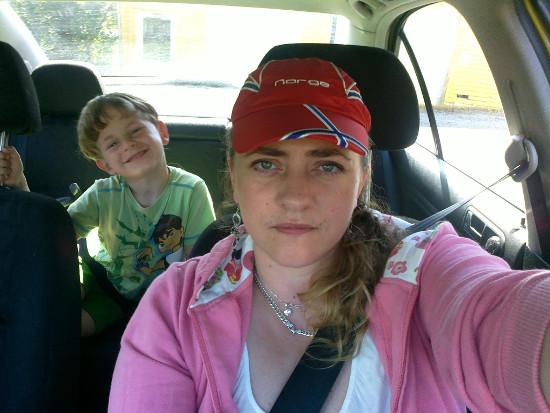 Gražina Lešcinskiene and her son, taken into care in Norway.
Gražina Lešcinskiene and her son, taken into care in Norway.Several Eastern European countries have declared war on child protection agencies in Norway, Finland and the UK, claiming that they are breaking up families based on little or no conclusive evidence.
The issue has come to a head in Lithuania after a television chat show accused the Norwegian child protection services, Barnevernet, of seizing the seven-year-old son of a Lithuanian mother, Gražina Lešcinskiene, earlier this year, after the boy showed signs of “sexualised behaviour”.
According to chat show An Hour with Ruta, Barnevernet routinely takes Lithuanian children from their parents as they are a “sought-after commodity” – a claim strongly denied by Norway.
The fall-out has become so toxic in Lithuania that the Norwegian ambassador there has hired a PR company to dispel the negative opinions of Norway being broadcast by the Lithuanian media. “This is a huge issue in Lithuania right now,” says Daiva Petkeviciute, a Lithuanian living in Norway, who works for the Oslo-based group Human Rights House Network. “The first thing Lithuanians say when I tell them I live in Norway is, ‘How do you still have your kids?’”
Meanwhile, a Latvian child living in the UK was removed from her mother in 2010 after the 21-month-old girl was allegedly found at home alone. The child was then placed with foster parents and is now living with adoptive British parents.
The mother denies her child was left alone and accuses the local authority of “forced adoption”. Earlier this month the Latvian parliament issued a formal complaint to the Speaker of the House of Commons about the conduct of British social services. The head of the child affairs cooperation division at the Latvian Ministry of Justice, Agris Skudra, said Britain had failed to notify Latvia that the child had been removed from its parents, thus depriving relatives of being given the chance to care for the child.
“The only thing [the social services] have done is apologise for missing a significant step in the adoption process, but for the mother and Latvian institutions this is not a relief. Apologising and saying we didn’t know something is not good enough,” Skudra says.
There has also been growing anger in the Czech Republic over a case that occurred in 2011. The two sons of a Czech mother were removed by Norway’s child protection agency after the parents were suspected of violence and sexual abuse. They were placed with different foster families. Earlier this year, Czech President Miloš Zeman accused Norway of “behaving like Nazis”, and a petition that backs the mother has attracted almost 10,000 signatures. “In the eyes of Europeans, Norway has become a country that takes children away from their parents excessively,” says Czech MEP Tomáš Zdechovský.
Wild theories circulating on Lithuanian social media suggest that Russian propaganda could be behind the discord. At the end of last year, the Russian Children’s Right Commissioner accused Norway and Finland of “terrorising” Russian families living in Scandinavian nations.
Norwegian ambassador to Lithuania, Dag Halvorsen, says a care order is only taken as a last resort. He blames cultural differences for the crisis, an opinion echoed by Lithuanians and Norwegians alike, who point out that acceptable child discipline differs vastly between different countries and generations.
Indeed, the head of child right protection in Lithuania concurs that culture differences could be affecting cases but that they “understand the concern of the citizens of the Republic of Lithuania about the existing situation”.
“With no clear legal regulation between these two states present, Lithuanian and Norwegian nationals have different interpretations of the situations when Norwegian authorities decide to curtail parental rights in their children's respect and to determine third-party custody of minor nationals of the Republic of Lithuania in Norwegian families. Information about cases like these is often published causing social frustration.”
However, the Directorate for Children, Youth and Family Affairs in Norway says that they regret the "distortion" they believe certain media in Lithuania have created regarding the Norwegian child welfare system.
"Norwegian legislation is primarily based on one principle: The best interest of the child. The Convention on the Rights of the Child is the most rapidly and widely ratified international human rights treaty in history, and Norway ratified the Convention in 1991.
The Norwegian Child Welfare Act’s main purpose is to ensure that children who live in conditions that can harm their health and development are given necessary and adequate help and care.
Regarding the Lithuanian population (including Norwegian born children from Lithuanian parents), less than 14 children out of a total of 5,906 children in Norway were placed out of home and 117 received voluntary support in the home.”
Source: Newsweek

Man Sentenced for Sexual Abuse
April 21, 2015 permalink
Rumors on the internet for a year have suggested the enclosed case, purportedly about sexual abuse, is really about shutting down opposition to children's aid.
expand
collapse
Six months for sexual interference
BELLEVILLE - A man who sexually touched his younger sister has been sentenced to jail time.
The man, whose name will not be released due to a publication order, was sentenced to a period of six months in jail, plus two years of probation with a variety of conditions, by Justice John Johnston Tuesday in the Superior Court of Justice at the Quinte Courthouse.
The case – which has torn a Centre Hastings family apart – has been before the courts for three-and-a-half years.
The sexual interference charges stemmed from incidents which occurred from 2008 to 2011, when the accused sexually touched his younger sister when she was between the ages of 11 and 14.
The court heard the victim – seven years younger than her brother – was touched both on top of and under her clothing when her brother would enter her bedroom during the night.
In a victim impact statement read aloud to the court by assistant Crown Attorney Michael Lunski, the victim stated her family has been torn apart by the incidents.
“My family never believed what I said,” she wrote, adding her mother and other brother both took the side of the accused.
She wrote there were times when she “just wanted to give up on life” and, at one point, did try to hang herself.
“I know it’s not my fault, but that is how I feel,” she wrote.
The victim impact statement also outlined how the girl was bullied at school, called names, and even told by other students that “I must have liked it if I didn’t tell anyone for four years.”
“I never told anyone because I was scared of what (he) would do.”
She also shared her inability to trust and be around people, especially men, which she said is a result of the touching.
Lunksi told the court the victim impact statement makes it clear “the extreme impact” the incidents had on the girl.
Lawyer for the accused, Clyde Smith, stated the man has “maintained his innocence” throughout the trial.
“These offences come at a horrible cost to everybody, including (the accused),” Smith said.
The man, who is 24-years-old and in a committed relationship, told Johnston he did not agree with the judge’s conviction ruling, but agreed to comply will all conditions imposed by the court.
“All I’ve ever wanted in my life is a wife and kids, to start a family,” he said. “All I want to do is get this over.”
Before delivering the sentence, Johnston told the victim she should feel no guilt.
“The fault lies with the accused who I have found to be the offender,” he said. “One hopes, along the line, this family will be able to work through this matter.”
“Society must protect our youngest and most vulnerable, that being our children, our future,” he said.
Source: Belleville Intelligencer
Police Reunite Toddler with Mother
April 19, 2015 permalink
When police found a wandering toddler in Barrie Ontario they returned the boy to his mother. There is no mention of calling children's aid. Not every wandering child needs the intervention of social workers.
expand
collapse
Wandering Barrie toddler reunited with mom
A lost Barrie toddler was reunited with his mother Thursday after he was spotted walking alone.
City police were called to the Stanley Street area about the boy and found a three-year-old wearing only a t-shirt, diapers and boots.
Officers knocked on doors in the area and after 45 minutes were able to locate the family.
His mother told police she had put her son down for a nap and shortly afterward he made his way out the rear door, and eventually out of the yard, and wandered down the street.
At the same time officers were in the area banging on doors, police said, the mother was frantically searching the neighbourhood for her son.
The situation could have been much different had a citizen not called police.
The child was safe and unharmed when he was reunited with his mother.
Source: Barrie Examiner
Fake Social Worker Kills Mother
April 19, 2015 permalink

A social worker impostor lured Samantha J Fleming and her newborn baby out of their home. The impostor murdered Samantha and claimed the baby as her own. Indiana police found the body by tracing the victim's cell phone.
expand
collapse
Mother found dead in Gary home was lured by suspect posing as case worker
 Gary and Anderson police found the body of a woman April 17, 2015, in the home at 1987 Cleveland St., in Gary.Michelle L. Quinn, Post-Tribune
Gary and Anderson police found the body of a woman April 17, 2015, in the home at 1987 Cleveland St., in Gary.Michelle L. Quinn, Post-TribuneA woman who was found dead Friday, wrapped in plastic and stuffed in a plastic storage bin inside a Gary home, has been identified, officials said.
The woman's body, which had been doused in bleach, was found at about 3 p.m. Friday at a home in the 1900 block of Cleveland Street, Lt. Thomas Pawlak said.
She was identified Saturday afternoon as Samantha J. Fleming, 23, of the first block of West Claire Street in Anderson, according to the Lake County coroner's office in Crown Point. The woman had been stabbed to death, according to the coroner, and her death was ruled a homicide.
Police from the central Indiana city of Anderson had come to Gary on Friday afternoon in search of a young mother and her newborn daughter who had been missing since early April. The 3-week-old infant, who was in the care of a suspect's sister, appears to be fine and will be returned to relatives in Anderson, Pawlak said.
But the story of how Fleming came to Gary is bizarre, police agree. Investigators from Gary and Anderson will sort through the events in the days ahead.
Anderson police had asked for the public's help in finding Fleming and her daughter, Serenity, who left Anderson on April 5 with a woman who said she was from the Indiana Department of Child Services and claimed Fleming had a hearing in Lake Superior Court, Anderson police said.
Soon after, relatives stopped hearing from her. Fleming's boyfriend reported her missing, police said.
Gary police found Fleming's wallet about two weeks ago at Woodlake Village apartments in Miller, and her cell phone had "pinged" on 15th Avenue near Interstate 65, Pawlak said.
In the meantime, a 36-year-old Gary woman who lives at the Cleveland Street home had set up a room in her home for a baby girl, police said.
"There was everything you would buy for a new baby. A crib, changing table, diaper bag, carrier, new clothes," Pawlak said. She passed off this baby as hers, police said. "It appears that she had been planning this," he added.
Investigators believe the woman posed as a Child Protective Services worker and lured Fleming to Gary.
At some point, the Gary woman asked her sister to care for the infant. The alleged kidnapper was later located in a hospital in Texas, Pawlak said.
"She knew a lot about this mother, enough to convince her she was with CPS," Pawlak said. Detectives will have to determine how she was able to gather information about the woman.
The suspect's sister had come to the house to pick up more items for the baby Friday and surrendered the child to police. Pawlak said the baby was examined at the hospital and is in good health.
A neighbor of the suspect is now questioning the relationship she had with her. The young woman, who asked not to be identified, said the last time she heard from her neighbor was around Easter.
The neighbor, who moved to Cleveland Street about a year ago, said she and the suspect were friendly but distant until January. Pregnant at the time, the two became close after the suspect helped her when she gave birth to her daughter at home.
"My phone was dead, so one of my sons went to go call the ambulance from a neighbor's house," the young woman said. "(The suspect) stayed with me and went to the hospital with me, and from then on, we were very close."
The suspect was pregnant at the time and said she was expecting twins, the young woman said.
Around Easter, the young woman said the suspect told her she had given birth, but one of the twins had died. The suspect also told her that she hadn't told her family that she had given birth because they had been harassing her doctor.
The second baby, the suspect told the young woman, was in the hospital recovering from jaundice.
A short time later, the young woman saw the suspect and a baby. The suspect was wearing sunglasses and had a bandage on her hand. The young woman said she thought the baby was "lighter-skinned" than she expected.
The suspect told her at that time she was leaving town and asked the young woman to watch the house while she was away. The young woman said she and the suspect texted regularly, though.
Friday was the first time the young woman had seen anyone at the house in weeks. When she texted the suspect Friday to let her know what was going on at the house, the suspect didn't reply.
"(The suspect's) sister was at the house and then left, and then a police car came by," the young woman said. "The sister came back, and then several police officers showed up.
"When I saw them bringing the body out, I thought it was (the suspect) for a second."
The neighbor said a night or two before the suspect left, she saw her going back and forth to the garage from the house with little plastic grocery bags.
There was also a night when she and a couple of other people left around 9 p.m. and didn't come back until late the next day.
"She was an amazing woman, and I don't want to place judgment," the young woman said, visibly shaken. "But her not responding today has made it more weird."
Detectives Alexander Jones and Jeff Minchuk are working with Anderson investigators on the case, Pawlak said.
Source: Chicago Post-Tribune
Addendum: The accused impostor is Geraldine Jones. Fleming believed Jones was a CPS worker because she had inside information about Fleming's prior involvement. Maybe Jones was a good detective, or maybe she had more of a connection to social services than has been revealed.
expand
collapse
Gary woman charged with murder, kidnapping in woman's death
 Gary and Anderson police found the body of a woman April 17, 2015, in the home at 1987 Cleveland St., in Gary.Michelle L. Quinn, Post-Tribune
Gary and Anderson police found the body of a woman April 17, 2015, in the home at 1987 Cleveland St., in Gary.Michelle L. Quinn, Post-TribuneThe nursery in Geraldine Jones' Tolleston home was ready for a newborn baby girl, all pink and bright and new. Jones, 36, had convinced family and friends she had given birth in March.
She named her baby Bella but claimed she was stressed from the loss of Bella's twin. She left the baby with her sister here and fled to Texas, where relatives live.
But it was not her baby, and police say she lured the newborn's mother from Anderson in central Indiana on April 5 to Lake County under false pretenses, then killed her.
Jones apparently attempted to kill herself days later by taking an overdose of over-the-counter sleeping pills, police said. Her attempt landed her in a Bedford, Texas, hospital bed where she remains under police guard, police said. Bedford is outside of Dallas.
On Monday afternoon, Jones was charged with murder, kidnapping and confinement in the death of Samantha Fleming, 23, of Anderson, and the abduction of her newborn daughter, Serenity. The charges were filed in Madison County, where the crime originated, news outlets there report.
Lake County Prosecutor Bernard Carter said his office had been in contact with Madison County Prosecutor Rodney Cummings and agreed the case could be filed there.
"We're not certain where the victim was killed, but the kidnapping occurred there," Carter said Monday afternoon.
Police found Fleming's body at Jones' home in the 1900 block of Cleveland Street on Friday afternoon. She had been stabbed to death, wrapped in plastic and left in a bleach-filled plastic storage bin in an unused bedroom, police said.
Her body was decomposed, but investigators were able to identify her from tattoos, police said.
Three-week-old Serenity was fine and appeared well cared for, police said.
Fleming graduated from Edison High School in Lake Station and had lived in Gary and Griffith. Her family and friends had made public appeals to find her.
She had been living with her boyfriend in Anderson. He reported her missing, saying he had not heard from her since she left with an Indiana Department of Child Services caseworker April 5. Fleming and her estranged husband had a previous child welfare case in Lake County, sources said. Jones apparently posed as a DCS caseworker and convinced Fleming she needed to return to address issues in the case in Crown Point, police said.
Fleming's wallet was found at the Woodlake Village apartments in Miller on April 6, police said. Jones' sister lives in that complex. Investigators "pinged" Fleming's cellphone at a location near Interstate 65 and 15th Avenue in Gary, police said.
Anderson police came to Gary on Friday to track Fleming's disappearance. The detectives were accompanied by Gary patrol units, who arrived about the same time Jones' sister was there to pick up more items to care for the baby. It was then that they found Fleming's body.
A DCS spokesman said Jones has never worked for the agency. Police have not yet discovered how Jones obtained detailed personal information about Fleming and her prior involvement with DCS, investigators said.
Gary Detective Alexander Jones and a detective from Anderson will fly to Bedford on Tuesday and attempt to interview Jones, police said.
Source: Chicago Post-Tribune
Total Family Destruction
April 19, 2015 permalink
Christopher Booker follows up on the case of a mother jailed for a comment to her lawyer. The mother has permanently lost her daughter. The boy who was the cousin and closest friend of the lost girl has died in an accident, leaving a girl and two mothers bereft.
expand
collapse
A family torn apart twice over
Two mothers have been left bereft by a tragic accident and badly applied law
 The girl had been taken into foster 'care' because her mother was assaulted by a man who was sent to prisonPhoto: Alamy
The girl had been taken into foster 'care' because her mother was assaulted by a man who was sent to prisonPhoto: AlamyI recently had an anguished call from the aunt of a young boy who had died in a tragic and widely reported accident. The boy’s distraught mother was her sister. I know this capable woman, because a year ago I told the bizarre story of how social workers had taken away her own daughter, a cousin of the dead boy. The children had grown up so close that they were “like brother and sister”.
As I reported, under the heading “If emotional abuse is to be a crime, who is guilty here?”, the girl had been taken into foster “care” only because her mother was assaulted by a man who was sent to prison. When, at a “contact session”, the mother was shocked to see her daughter covered in bruises, she raised this with the social workers, who dismissed it as of no importance. Next day, meeting to discuss another matter with a young trainee solicitor, she mentioned her dismay at the social workers’ response, casually adding that this was the kind of thing that prompted so many parents to escape with their children to other countries to prevent them being taken into care.
Completely misunderstanding what the mother had meant, the solicitor reported to the social workers her suspicion that the mother was intending to “abduct” her daughter to flee abroad. The mother was arrested. After a very odd trial, and solely on the solicitor’s evidence, she was sent to prison for a year. On her release, and despite evidence from the child’s “guardian” that the daughter’s only wish was to come home, the social workers convinced a judge that the girl should have no further contact with any of her family, including her beloved cousin. Now the boy is dead. Having not seen her mother for two years, the once happy little girl is still miserably in “care”. The two mothers are utterly bereft.
Source: Telegraph (UK)
Foster Jails
April 18, 2015 permalink
Manitoba has recently been in the news for its practice of housing foster children in hotels. Now it turns out that when a judge wants to release a foster child from police custody he languishes in jail until a foster home is available.
expand
collapse
Manitoba accused of violating rights of foster children stuck in jail CTV National News: Children in police custody
The Manitoba government is under fire after a provincial watchdog said children in government care are languishing in jail due to a lack of foster care spots.
Manitoba Premier Greg Selinger said the province is investigating after Children’s Advocate Darlene MacDonald said she receives calls from judges who want to release youth from police custody, but can’t because there is nowhere else to put them.
Manitoba’s Child and Family Services is looking into the matter, Selinger said, and working to create more placements for foster children.
"If in fact, there’s any children staying in any kind of correctional facility longer than necessary, we want to make sure that’s not the case,” Selinger said Wednesday.
However, critics say it is a human rights violation, and are calling on the provincial government to do more.
Progressive Conservative critic Ian Wishart says police custody is not an appropriate place for a vulnerable child, and that the government isn’t moving fast enough to end the practice.
“Kids that don’t need to be in institutions should not be in institutions,” Wishart said.
Manitoba has more than 10,000 children in care and the vast majority are aboriginal.
Youth who break the law are placed at the Manitoba Youth Centre, a correctional facility for kids. They are also placed there when they are picked up off the streets.
A girl who asked not to be identified told CTV News that spending time at the Manitoba Youth Centre became somewhat normal for her as a teen.
As a ward of Child and Family Services since infancy, the girl said she has been in and out of youth jail six times.
A runaway, she was picked up repeatedly for breaking curfew, and has also been charged with assault. The girl says she and others have remained in remand before because there was nowhere else to go.
“It makes us feel like we are not wanted, like they don’t want to get us out of there,” she said.
No one knows how many kids are being kept in jail when they should be released, because officially, no one is keeping track.
Provincial departments such as Manitoba Justice don’t have statistics, and neither does Child and Family Services -- the agency responsible for kids in care.
Cora Morgan counsels youth who have been involved with the law. Increasingly, she’s been speaking with kids who have been left in the Manitoba Youth Centre.
In some cases, she said, they want to stay in jail to avoid hotels.
“In the past two years, I’d say it’s happened around 20 times,” Morgan told CTV News.
Officials are now working to add more shelter beds and foster care spaces. The province estimates as many as 160 new emergency placements are needed by deadline.
The criticism over the lack of foster spaces comes after recent violent incidents involving Manitoba children in government care.
Earlier this month, a 15-year-old girl under the care of Manitoba Child and Family Service was severely beaten outside a Winnipeg hotel. The girl and the 15-year-old boy subsequently charged in the beating were both in foster care and were being housed at the same hotel at the time of the attack.
On Wednesday, the 15-year-old girl was taken off life support.
In light of the attack, the province has vowed to stop using the hotel system to house children by June.
Source: CTV

Baby Neglected by CAS
April 18, 2015 permalink
Jenn Feero reports on the care of her newborn while in CAS care. Alberta social workers rebuffed similar complaints by Jamie Sullivan. Her baby was dead four days later.
expand
collapse
Jenn Feero
UNBELIEVABLE C.A.S what a joke they are! NEW Born baby Neglected!
I Had a visit with my little man Ryder today and got the shock of a life time! Went to change his little bum and I opened his diaper up to a mess of poop, blood and a very red little bottom. He has such a bad bum rash it's beet red and blistered and bleeding! He had a minor rash two weeks ago and no one has taken care if it now it has gotten so bad it bleeds and my baby boy screams in pain!
Some lazy cunt is being paid to care for my son so why the fuck is he in the shape he is in he certainly wouldn't look like that if I had him. The foster mom sends no bum cream and doesn't mention any rash nothing! He spent the hour of visiting time crying in pain if you hold him under his bum he cries because it hurts so bad. Like WTF is she doing with my son obviously nothing!!!
Not to mention his cheeks are all broke out and red and his skin is all dried out. They aren't taking good care if him at all. Every time I see him he has new rash or break. There is always something wrong with him and no one seems to notice or no one seems to give a fuck at least!!
If CAS showed up at my place to check on my son and he was in that shape they would rip him out of my home so fucking fast, but because they placed him there he is safe and it's ok because they know it all and they do everything right
I brought it to worker's attention she didn't seem to think it was a big deal! Hello lady are you friggin blind? Look at my kid. He is not being taken care of properly. A monkey could do it better
Don't listen to anything I say though. I'm just the stupid parent that didn't have her kids. What do I know? I can't tell them nothing. They are CAS, the child care professionals, they know it all and they say he's fine and safe so he is fine and safe!!! Yeah what a fucking joke!!! Give me my kid back so he can be taken care of properly. It's not that hard. Some bum cream and a bum change every hour or so, some baby lotion for his delicate skin and some love, care and attention how hard is that? Like you're really that lazy you can't take the time out of your busy day to care for a helpless little baby. CAS is USELESS.
Source: Facebook, Jenn Feero
Motherisk R.I.P.
April 18, 2015 permalink
Following repeated criticism in the press, the Hospital for Sick Children in Toronto has permanently closed the Motherisk program. There may still be legal actions to undo past injustices caused by Motherisk. Earlier articles: [1] [2] [3] [4] [5].
expand
collapse
Sick Kids shuts down hair tests at Motherisk lab
Decision comes after a Star investigation into tests used in criminal and child protection cases across Canada.
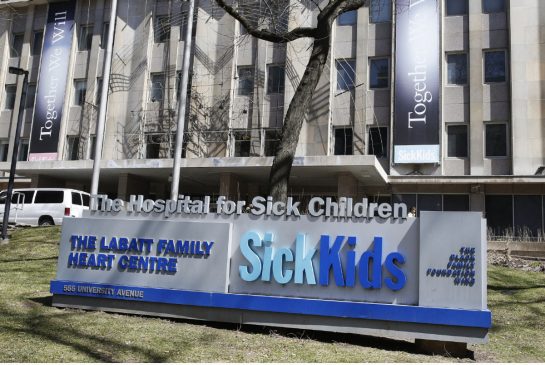 The Hospital for Sick Children announced on Friday it has permanently discontinued hair drug and alcohol tests at its Motherisk Drug Testing Laboratory.Colin McConnell / Toronto Star
The Hospital for Sick Children announced on Friday it has permanently discontinued hair drug and alcohol tests at its Motherisk Drug Testing Laboratory.Colin McConnell / Toronto StarThe Hospital for Sick Children has permanently discontinued hair drug and alcohol tests at its embattled Motherisk Drug Testing Laboratory after an internal review “further explored and validated” previous, and as yet undisclosed, “questions and concerns.”
The decision, announced on Friday, comes amid a Star investigation and mounting pressure from critics to shutter the lab, whose hair drug and alcohol tests have been used in criminal and child protection cases across the country, typically as evidence of parental substance abuse.
“Over the past six weeks, the hospital has continued to review its decision to suspend the laboratory’s operations,” Sick Kids said in a statement. “The hospital has concluded that this laboratory service is not required for its ongoing operations.”
The province appointed retired Appeal Court Justice Susan Lang late last year to probe the reliability and accuracy of five years’ worth of drug hair tests performed by Motherisk, from 2005 to 2010.
In March, Sick Kids temporarily suspended all non-research operations at Motherisk, after Lang’s review and the hospital’s review revealed new information, pending the results of Lang’s review, which are expected by June 30.
The hospital has declined to elaborate on the nature of that information. A hospital spokeswoman said on Friday that Sick Kids is not taking media inquiries.
Toronto lawyer James Lockyer, who criticized the hospital’s secrecy in his submissions to Lang on behalf of the Association in Defence of the Wrongly Convicted, called the hospital’s silence “disquieting.”
“It is a drastic decision, to permanently close down an important operation which, until recently, the hospital was strongly defending,” he said. “The ‘wait and see until the independent review is completed’ only (heightens) concerns about what went wrong.”
Criminal lawyer Daniel Brown, who urged Lang to broaden her review on Motherisk in the submissions he helped prepare for the Criminal Lawyers’ Association, said the hospital “has an immediate obligation to publicly share the results of their internal review so that problems identified during that review can be swiftly corrected.”
In its statement Friday, Sick Kids said it would not provide further details to “maintain the ongoing integrity of the independent review.”
“We understand the public may want more information on the findings that have led the hospital to make this decision, and we believe that it is most appropriate for that disclosure to come through the independent review,” the hospital said.
Health Minister Eric Hoskins refused to answer questions on why there is so much secrecy surrounding the problems uncovered at Motherisk and instead issued a statement by email about Lang’s review.
“The independent review is ongoing and we have confidence in the work that is being carried out by the Honourable Susan Lang,” he said.
Sick Kids recently temporarily reassigned medical oversight of Motherisk, which also counsels pregnant women on which medications are safe to take, amid questions from the Star about the ties between Motherisk director and founder Gideon Koren and the drug company Duchesnay.
The questions related to the lack of disclosure of the funding Motherisk receives from Duchesnay in a booklet for pregnant women co-written by Koren and featured on the Motherisk website, which heavily promotes the use of Duchesnay’s drug Diclectin to treat morning sickness.
The hospital has said it is aware of the concerns about Koren and Duchesnay and is continuing to investigate. It has declined to comment on whether Koren has been removed as director of Motherisk. Koren did not respond to a request for comment on Friday.
The Star investigation of Motherisk began late last year, when an Appeal Court overturned the cocaine-related convictions of Toronto mom Tamara Broomfield after fresh evidence criticized the hair drug tests results Koren presented at her 2009 trial.
Broomfield was sentenced to seven years in prison for feeding her toddler cocaine after Koren testified that tests of her son’s hair showed that he had regularly consumed large amounts of the drug for more than a year leading up to a near-fatal 2005 overdose.
Statement from Hospital for Sick Children
Operations of Motherisk Drug Testing Lab Closed
April 17, 2015 (Toronto)
The Hospital for Sick Children (SickKids) announced today that it will not be reinstating the non-research related activities of the Motherisk Drug Testing Laboratory. The Government of Ontario launched an independent review of the Motherisk hair analysis program, with the full support of SickKids, in November of 2014. The Honourable Susan Lang has been leading the independent review.
Based on information available in November 2014, SickKids made the decision to continue operating the drug testing laboratory. On March 5, 2015 as a result of new information arising from the ongoing analysis by the hospital and the independent review by Justice Lang, SickKids suspended the operations of the laboratory.
Over the past six weeks, the hospital has continued to review its decision to suspend the laboratory’s operations. Questions and concerns have been further explored and validated. The hospital has concluded that this laboratory service is not required for its ongoing operations. For these reasons, the operations of the laboratory will not be reinstated.
To maintain the ongoing integrity of the independent review, SickKids will not be taking media inquiries at this time. We understand the public may want more information on the findings that have led the hospital to make this decision, and we believe that it is most appropriate for that disclosure to come through the independent review.
Lockyer represented Broomfield at the Appeal Court. The fresh evidence he presented came from Craig Chatterton, deputy chief toxicologist in the office of the chief medical examiner in Edmonton, who challenged Motherisk’s findings and said the method the lab used to test the boy’s hair was a preliminary screening test, and the result should have been confirmed with a gold-standard test.
The terms of the independent review were set after Sick Kids told the Star it started using the gold-standard test to analyze hair for cocaine in 2010.
When she announced the review, Attorney General Madeleine Meilleur said it was the first step that could spark a larger inquiry.
The Criminal Lawyers’ Association, the Family Lawyers Association, the Innocence Project and the Association in Defence of the Wrongly Convicted have since called for the scope to be broadened.
Toronto lawyer Katharina Janczaruk, chair of the Family Lawyers Association, said on Friday that the hospital’s announcement bolsters the case for expanding the review beyond 2010, to include whatever new information has arisen about more recent issues in the lab.
“We have a right to know what the new information is because it may have an impact on current cases,” she said.
A spokesman for the review declined to comment on the news from Sick Kids on Friday.
Source: Toronto Star
Addendum: Ontario's children's aid societies have been told to stop using Motherisk. But will they return children taken in the past?
expand
collapse
Children’s aid societies told to stop using Motherisk hair tests
Ontario is also expanding the scope of the probe at the Hospital for Sick Children lab.
The province is expanding the scope of the independent probe into problems at the Hospital for Sick Children’s Motherisk Drug Testing Laboratory.
The Ministry of Children and Youth Services has also directed children's aid societies to “immediately stop relying on” hair drug and alcohol testing in the course of child protection proceedings, the province said in a news release Wednesday, amid an ongoing Star investigation.
The province has expanded the scope of the review from hair tests to include hair drug and alcohol tests from 2005 to 2015. It will also “consider other matters related to the operation of the laboratory as appropriate,” according to the press release.
The final report by retired Appeal Court justice Susan Lang is now expected in December.
“It is critically important that the institutions upon which our justice system relies are held to an extremely high standard,” Attorney General Madeleine Meilleur said in the release. “Our families and our children deserve no less.”
Calls have been mounting for months for a wider look at the concerns that prompted the province to launch an independent review in November of five years’ worth of hair drug and alcohol tests performed by Motherisk from 2005 to 2010, and used in criminal and child protection proceedings.
Motherisk’s hair drug and alcohol tests have been used as evidence in cases across the country, generally as proof of parental substance abuse. The results have influenced an unknown number of child custody decisions.
Sick Kids announced last week that it is permanently closing all non-research operations of the Motherisk lab, including hair alcohol and drug testing. The hospital temporarily suspended hair drug and alcohol testing in March after an internal review and Lang’s review uncovered new information.
The hospital has not revealed any details about the nature of the information that has been uncovered.
The decision to shutter Motherisk’s hair and drug testing lab is in stark contrast to the position Sick Kids took when the Star started asking questions about Motherisk last year, when the hospital vigorously defended the reliability of the lab in the media.
In March, before the Motherisk lab was closed for good, Sick Kids said it had reassigned medical oversight of the program, including its other functions, which include counseling pregnant women on which medications are safe to take. The move followed questions from the Star about the financial ties between Motherisk founder and director Gideon Koren and the drug company Duchesnay, which manufactures the popular morning sickness drug Diclectin.
The hospital has repeatedly refused to say who is currently overseeing Motherisk. The program’s counseling helplines provide advice to “hundreds of women and their health care providers each day,” according to the Motherisk website.
The province has continued to express confidence in Motherisk’s research and counseling services.
Source: Toronto Star
Meitiv Children Don't Come Home
April 14, 2015 permalink
Police picked up Rafi, 10, and Dvora, 6, children of the high-profile Meitiv, family and turned them over to Maryland child protectors. The parents only found out when the children failed to come home. They spent several panicked hours searching. CPS apprehension without notice is commonplace, though rarely mentioned in the press. Possibly because the public interest in this case is so high, CPS did not apply its usual tactic of placing the kids in foster care, but returned them to the family later that night, though only after extorting more concessions from the parents. Previous Meitiv stories: [1] [2]. Two articles are enclosed.
expand
collapse
‘Free-range children’ taken into custody again in Maryland
Earlier this year Danielle and Alexander Meitiv were investigated by Montgomery County after letting their children, 10 and six, walk home alone from a park a mile away from their house. (Jorge Ribas/The Washington Post)
The two Montgomery County children who were picked up last year while walking home alone were taken into custody again Sunday, authorities said.
The children of Danielle and Alexander Meitiv were taken into custody by county police at a park about 5 p.m. and turned over to the Child Protective Services agency, said Capt. Paul Starks, the county police spokesman. The children’s mother said they were released to the couple at 10:30 p.m. Sunday.
The parents said the children, who are 10 and 6 and have been described as “free-range children,” had been expected home at 6 p.m. Sunday. When that time passed, the parents said, they began looking for them.
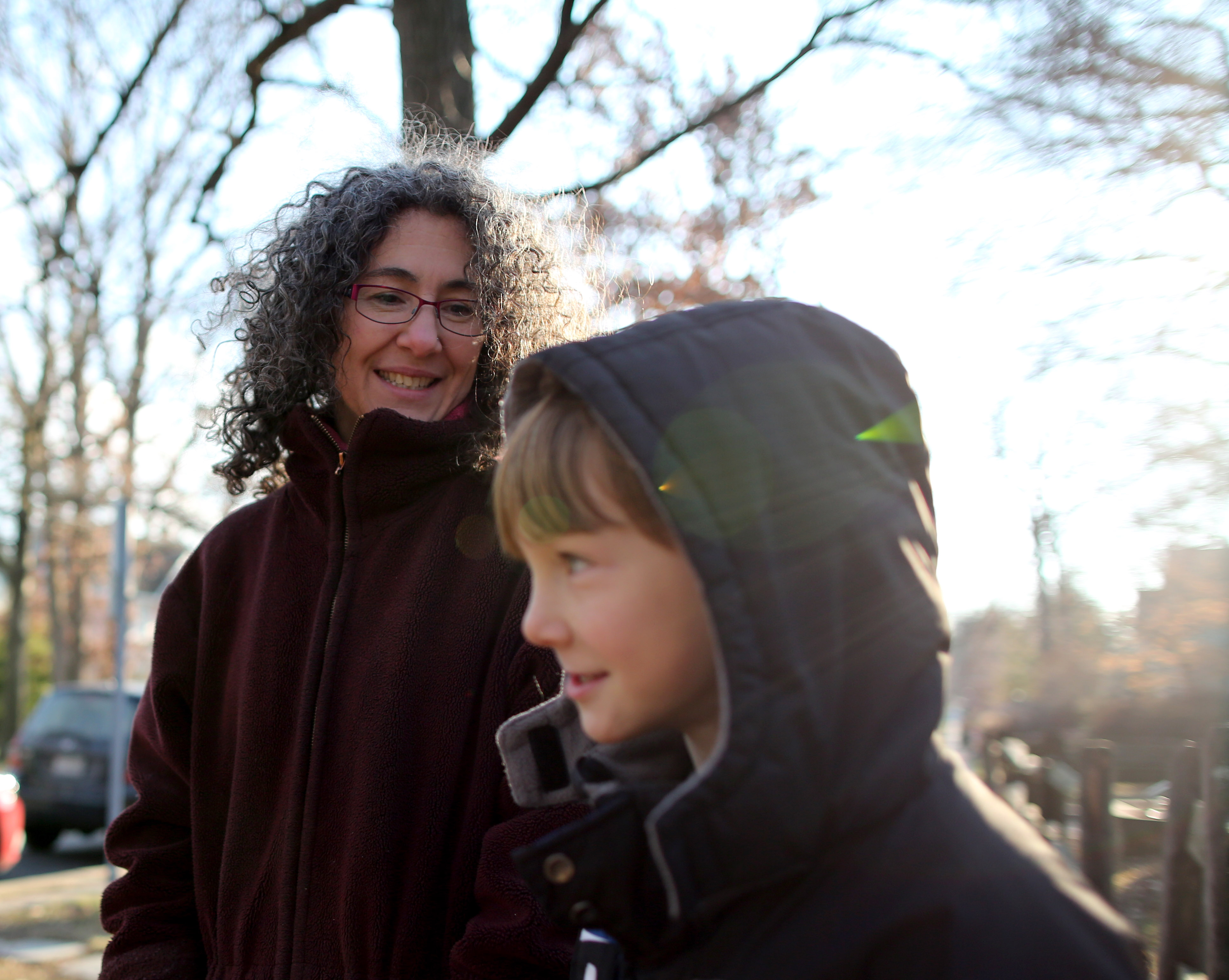 Danielle Meitiv waits with her son Rafi Meitiv, 10, for Danielle's daughter, Dvora Meitiv, 6, to be dropped off at the neighborhood school bus stop in Silver Spring earlier this year.Sammy Dallal/For the Washington Post
Danielle Meitiv waits with her son Rafi Meitiv, 10, for Danielle's daughter, Dvora Meitiv, 6, to be dropped off at the neighborhood school bus stop in Silver Spring earlier this year.Sammy Dallal/For the Washington Post“We have been searching for the kids for hours,’’ the mother said in a Facebook posting. They learned of the children’s whereabouts about 8 p.m. The mother said they later spent about a half-hour at the CPS offices in Rockville without being allowed to see them.
Starks said police were dispatched after a stranger saw the unaccompanied children in the park near Fenton and Easley streets. He said police took the children to the CPS office.
No charges had been placed, Starks said, and the matter remained under investigation.
After CPS investigated the earlier incident, the Meitivs were notified that a finding of “unsubstantiated neglect” had been made. That is one of three findings that can be made in neglect investigations. The others are “ruled out” and “indicated.”
An official said that the “unsubstantiated” finding is typically made when CPS has some information supporting a conclusion of child neglect, when seemingly credible reports are at odds with each other or when there is insufficient information for a more definitive conclusion.
The Meitivs’ case prompted debate about responsible parenting, child safety and the government’s role. The couple takes the view that children learn self-reliance by being allowed to make choices and progressively experience the world on their own.
Source: Washington Post
‘Free-range’ kids and our parenting police state
They were coming home from a park, on this gorgeous, blossoming weekend, after playing.
And for this, a 10-year-old and his 6-year-old sister ended up in the back of a squad car. Again. For hours this time.
In the bizarre nationwide culture war over how much freedom children should have to play outside alone, the youngest combatants — Rafi and Dvora Meitiv — are the ones being damaged the most.
This is getting pretty ridiculous. Somehow we’ve morphed from being a village that helps raise children to a parenting police state.
The Silver Spring siblings were about 2 1/2 blocks from their home Sunday when Montgomery County police got a call reporting them — gasp — playing alone.
“The police coerced our children into the back of a patrol car and kept them trapped there for three hours, without notifying us, before bringing them to the Crisis Center, and holding them there without dinner for another two and a half hours,” their mom, Danielle Meitiv, said to her Facebook friends. “We finally got home at 11 pm and the kids slept in our room because we were all exhausted and terrified.”
What a pathetic way to fight about parenting styles. Because the kids are the biggest victims in all this.
Imagine the cops telling two young children to get into the car as they argue that they know their way home, they know where they are going and that their dad said they could walk home. This is what happened in December. And Rafi and Dvora had nightmares about police snatching them that time, their mom told me.
Mom and Dad were dragged into court for that incident, and the nation debated whether they are good or bad parents. Montgomery County ruled that they were guilty of unsubstantiated child neglect. Which means no one could decide who was right.
This time, police were called again by an adult worried about these kids playing outside alone.
Capt. Paul Starks, the county police spokesman, told The Washington Post that the children were taken into custody about 5 p.m. and turned over to Child Protective Services. They were released to their parents at 10:30 p.m. Starks said the matter remains under investigation.
Danielle Meitiv, a climate-science consultant, offered a scarier account of what happened to her children. “The cops said they would drive them home, then kept the kids in the patrol car for three hours,” she told me Monday. “Wouldn’t even let them out to use the bathroom.”
Imagine the message our society is sending the Meitiv kids by holding them in the back of a squad car and in a crisis center for nearly six hours because they were playing alone outside. And if what Danielle said is true — that police initially told the kids they were going to just drive them home — how is this not a kidnapping?
It’s outrageous, really.
If that adult who called police was worried about the kids, why not talk to them? Ask them where their parents were? Walk them home?
Or maybe it was someone who recognized the Meitiv kids, hated their parents’ very public “free-range” advocacy campaign — multiple television appearances included — and decided to get back at them.
If this is how we respond to children playing alone, my kids and I would’ve been locked up multiple times. Walking the dog around the block? Call the Capitol Police! Getting a Popsicle at the corner store? Alert the social workers! Getting me the cheese I ran out of while making dinner? Book ’em!
We need to get a grip. I get that it’s a scary thing to let kids go. But it is absolutely necessary for them to become normal, functioning adults.
My kids play basketball and lacrockey (a made-up hockey/lacrosse thing) in our alley on Capitol Hill. It’s not a suburban cul-de-sac, believe me. The other day, a motorcycle cop rode up to them and asked if they had seen a man running past them.
This was the search that ended on H Street in Northeast Washington, with the capture of a man suspected of killing a security guard at the U.S. Census Bureau.
Did I let them play in the alley the next day? You bet.
Because when I drove past the fatal crash on the Baltimore-Washington Parkway earlier this year, I did not stop driving, either. There are risks in living, no matter what.
Our rapid march toward police-state parenting has got to end.
Today, when you look at the readiness checklists for first grade, you’ll find that we are concerned only with their academic performance, being able to “expand sight words” or “read a graph” or “locate the seven continents and four oceans.” Really.
But take a look at the first-grade readiness checklist from a 1979 book, “Your Six-Year-Old — Loving and Defiant.”
Back then, your child was ready for first grade if he or she had two to five permanent teeth, were at least 6 years and 6 months old and these:
- Can your child tell, in such a way that his speech is understood by a school crossing guard or police where he lives?
- Can he travel alone in the neighborhood (four to eight blocks) to store, school, playground, or to a friend’s home?
- Can he be away from you all day without being upset?
Yeah. Life skills, social development. Becoming actual people, not just little graph readers. We’ve kind of forgotten about that, haven’t we?
Source: Washington Post
Social Workers on Leave
April 14, 2015 permalink
Foster parents Danielle Yates and John Yates failed to adequately nourish their two foster children. The children lost weight under their care. So far, there is nothing unusual. The parents were diverting a stipend for the children for their own use as portrayed two centuries ago by Charles Dickens. What makes this story unusual is that the parents were arrested. Ordinarily foster parents are only prosecuted after their wards die. Even more unusual, three Oregon social workers have been suspended, though they got the mildest possible reprimand, a paid vacation.
expand
collapse
DHS employees put on leave after foster parents charged with not providing food, medical care
 Danielle Yates, John Yates, jail booking photos
Danielle Yates, John Yates, jail booking photosYAMHILL, OR (KPTV) -
Three employees of the Department of Human Service's child welfare program are on paid administrative leave following the arrest of two foster parents on charges they did not provide adequate food or medical care to two young children.
Danielle Yates, 31, and John Yates, 42, were taken into custody at 6 p.m. Wednesday after they were indicted by a Yamhill County grand jury.
Deputies said the victims, a 4-year-old boy and 5-year-old girl, had been in the couple's care at their Yamhill home for four years.
In that time, the children actually lost weight, according to detectives. A special investigations unit said the kids spent about a week in the hospital during the Christmas holidays after their condition was discovered by a relative.
A special investigations unit conducted interviews and examined evidence, including medical records, and determined the suspects "were not providing adequate nourishment or medical care to the children," according to the sheriff's office.
The couple has legal guardianship over the children.
Danielle and John Yates were booked in the Yamhill County Jail on two counts each of first-degree assault and first-degree criminal mistreatment.
Their bail was set at $350,000 each.
Anyone with information on this case is encouraged to contact Detective Marc Brodeur at 503-434-7506.
The Department of Human Services, released a statement Friday saying the department's director, Lois Day, called on a Critical Incident Response Team (CIRT) to conduct a review of the case and identify any potential systemic issues and areas of improvement.
Source: KPTV
Paper Assault
April 13, 2015 permalink
Vanessa Wasiela reports one of the most frivolous pretexts ever for intervention in a family — accidentally hitting a child with a newspaper.
expand
collapse
Vanessa Wasiela
So today I got call from CAS. Meeting with her Thursday! What happened is my hubby, myself and daughter went to Walmart. My daughter was misbehaving so the hubby stayed in car with her. Our daughter is special needs. Anyway the hubby threw a newspaper in the back seat, sadly his aim was off and accidentally hit our daughter with the paper! She started screaming, the hubby asked: what's wrong? She kept screaming: you hit me! He kept saying no because he didn't know he had accidentally hit her at that point! Finally she screamed: you hit me with the paper. He said he was sorry! But too late, somebody had heard our daughter. Took down the car plate then called cops. Cops came, talked to my daughter and myself. I explained, cops felt all was fine but said I could use resources since I have a special needs child and disabled hubby! Why in heck does this worker want to meet at my home? I told her she couldn't come in our home, but we would be happy to meet her at her office. She wanted us to pull our child out of school early, we said no! Finally she said ok how about 5:30 Thursday. Which we was fine too. Can they open a case because of an accident? We don't hurt our child! Even our daughter says it was an accident!
Source: Facebook, Stop the CAS ...
Foster Teenager Missing
April 13, 2015 permalink
Teenager Jacob Buttineau is missing from his foster home and is believed to be in the area of Midland or Barrie Ontario.
expand
collapse
Missing 15-year-old last seen April 10 in Tay Township
 Jacob Buttineau, 15, was last seen leaving his Tay Township home on the morning of April 10.Submitted photo
Jacob Buttineau, 15, was last seen leaving his Tay Township home on the morning of April 10.Submitted photoTAY TOWNSHIP – Police are asking for the public’s help to find a 15-year-old boy missing from his Tay Township home since April 10.
Jacob Buttineau was last seen leaving home at 10:50 a.m. His foster parents contacted Southern Georgian Bay OPP when he did return by his 9 p.m. curfew.
He is described as white with a thin build. He stands five-foot-10 and has black, straight, medium-length hair and brown eyes. He was last seen wearing a black and green New York Giants baseball cap, a blue hoody and black jeans.
Investigators believe he may be in the Midland or Barrie area. Anyone who has seen him or is aware of his whereabouts can contact the OPP at 1-888-310-1122.
Source: Midland Mirror
Naked Research
April 10, 2015 permalink
What kind of research do judges conduct while deciding whether to separate children from parents? They watch porn. Four British judges are out of a job after mis-using court computers.
expand
collapse
Judges dismissed after watching pornography on court computers
Judicial Conduct Investigations Office says the four men have left their roles after what it described as "wholly unacceptable conduct"
Three judges have been removed from office and a fourth has resigned after allegations they viewed pornography on court computers, it has been announced.
The Judicial Conduct Investigations Office (JCIO) said in a statement that Lord Thomas of Cwmgiedd, the Lord Chief Justice, and Chris Grayling, the Lord Chief Justice, had investigated allegations against the men.
They concluded that it was an "inexcusable" use of court equipment and condemned the judges' conduct as "wholly unacceptable".
The material viewed did not include images of children and was not illegal, a spokesman added.
But he refused to disclose whether the pornography had been viewed during court cases while the judges were sitting on the bench.
A statement from the JCIO said: "District Judge Timothy Bowles, Immigration Judge Warren Grant and Deputy District Judge and Recorder Peter Bullock have been removed from judicial office following an investigation into an allegation that they viewed pornographic material on judicial IT equipment in their offices.
"The Lord Chancellor and the Lord Chief Justice were satisfied that the material did not include images of children or any other illegal content, but concluded that this was an inexcusable misuse of their judicial IT accounts and wholly unacceptable conduct for a judicial office holder."
Another judge, Recorder Andrew Maw, who sat at Lincoln County Court, was also found to have viewed similar inappropriate material on his judicial IT account.
"The Lord Chancellor and the Lord Chief Justice would likewise have removed Recorder Maw had he not resigned before the conclusion of the disciplinary process," said a spokesman.
Judge Bowles sat at Romford County Court in east London, Judge Bullock was on the court circuit in the North East, including North Shields County Court, and Judge Grant served in the lower immigration tribunals based in central London.
In 2005 Judge Bullock was involved in a prominent case at Newcastle County Court when Jimmy "Five Bellies" Gardner - a close friend of Paul Gascoigne, the England footballer - was declared bankrupt.
The cases were not linked and are understood to have taken place at different times and places.
One of the judges said he had been suffering from "severe and undiagnosed depression" at the time of the allegation.
Mr Grant, who now works as an immigration law specialist at a firm of north London solicitors, said: "I do not wish to comment save to say that for some years before, and during, the period covered by the conduct which formed the subject of the complaint laid against me I was suffering from severe and undiagnosed depression.
"I request that the privacy of my family and myself be respected so that we are allowed to continue with our lives."
Father-of-five Mr Grant, of Golders Green, north London, was educated at the Royal Newcastle Grammar School and Cambridge University, and has an interest in jazz.
Source: Telegraph (UK)
Kopyto Ousted as Para-Legal
April 10, 2015 permalink
The law society has denied Harry Kopyto the right to practice as a para-legal. Kopyto plans to appeal.
expand
collapse
Kopyto vows to fight ‘until my last gasp’
Fresh off a Law Society Tribunal good-character decision denying him a paralegal licence, disbarred lawyer Harry Kopyto is vowing to continue battling the regulator “until my last gasp.”
 Harry Kopyto says he is ‘outraged’ by the LSUC’s recent decision denying him a paralegal licence.Photo: Law Times files
Harry Kopyto says he is ‘outraged’ by the LSUC’s recent decision denying him a paralegal licence.Photo: Law Times files“I’m outraged and I’m extremely disappointed and the decision is a litany of factual and legal errors as well as distortions of the evidence that was heard,” says Kopyto, 68.
“Am I going to appeal?” he adds. “Does a bear defecate in the woods?”
The comments follow a decision by the tribunal’s hearing division last week denying Kopyto a licence to practise as a paralegal. Following his disbarment in 1989, Kopyto continued to provide paralegal services and, when the Law Society of Upper Canada began regulating paralegals in 2007, Kopyto applied to continue practising under the grandparented provisions included in the new rules. The law society has since brought good-character proceedings to determine whether he can practise as a paralegal.
In coming to its decision to reject his application, the panel seemed at pains to acknowledge Kopyto’s efforts to assist people who can’t afford legal services.
“We have reached this conclusion despite much evidence of the dedication Mr. Kopyto has shown to the causes of his clients,” wrote panel chairwoman Margot Blight.
“Those clients whom he called to testify expressed gratitude to him. We accept that he has sought, throughout his career, to improve the lives of the disenfranchised and the disadvantaged and has represented many clients without seeking any payment. Although this is evidence of good character, it is insufficient to meet the good character requirement of the act, in view of the panel’s many concerns, set out below, and in particular its conclusion that Mr. Kopyto is ungovernable.”
Of particular concern was the panel’s finding that Kopyto had engaged in unauthorized practice.
“Mr. Kopyto acknowledges having provided unauthorized legal services on hundreds of occasions since his disbarment, and on numerous occasions since giving the undertaking,” wrote Blight.
“Typically this consisted of him preparing and filing pleadings in the Superior Court (which is not permitted for paralegals), or engaging in correspondence in respect of Superior Court matters, using his client’s name. . . . For official purposes, Mr. Kopyto’s clients were self-represented, but in fact, he was fulfilling the role of representative using their names. . . . He would propose to conduct discoveries in writing. When this was opposed, he coached the client or arranged for a lawyer to conduct the discoveries. He either coached the client or arranged a lawyer for other court appearances.
“These tactics have sometimes had the desired effect of avoiding Mr. Kopyto’s involvement becoming an issue. However, they have given rise to problems in addition to the obvious breaches of the scope of paralegal practice rules.”
Other concerns noted by the panel included Kopyto’s financial obligations, including his difficulties with the Canada Revenue Agency. According to the panel, Kopyto “does not pay taxes, except through garnishment by CRA of his old age pension.” It also found he had paid nothing towards the costs orders made against him by various courts and tribunals over the years totalling more than $80,000 since 1985.
For his part, Kopyto is unrepentant. The decision, he says, made no reference to the evidence of about 20 witnesses, most of whom were clients, who appeared on his behalf. It also failed to consider what he says is an enviable legal record, including “over 75 cases that have changed the law, including getting the Human Rights Code amended to cover homosexuals and lesbians in the 1980s.”
Kopyto says he’ll be pursuing four grounds of appeal:
- The institutional bias of a panel selected by a minority of lawyers who determine who can participate in a fundamental public institution such as the justice system.
- Alleged personal bias by Blight, whom he says acted as counsel against one of his witnesses in an unrelated proceeding.
- His overall objection to lawyers deciding on who can be part of the legal system, including their paralegal competitors. “They’re protecting their turf,” he says. “There’s a constitutional issue there regarding access to the courts.”
- The ruling’s “endless litany of factual errors,” including the suggestion the Canada Revenue Agency is garnishing his pension. “The CRA is not garnishing my income,” he says. “I don’t know where she got that from.”
Kopyto says the appeal will be expensive, however, given the need to pay for transcripts from the years of proceedings in his case.
“Where am I going to get the $75,000 to pay for the transcripts, which is a prerequisite for proceeding on the grounds of appeal that related to the evidence that she heard?” he asks, noting the proceedings have been going on since 2009 and have included two previous panels.
As for what happens to his practice now, Kopyto says he’ll continue assisting people but hints the battle over his own status is largely about making a point.
“I would have retired years earlier but for these proceedings,” he says. “There’s no personal consequence for me. I’m appealing in order to change the law.”
He adds: “I’m not closing shop. I’m providing free legal advice and assistance to clients who otherwise would not be represented.”
Kopyto notes, for example, that the immigration rules allow paralegals and agents to appear at immigration hearings as long as they act for free, something he says the law society has taken issue with. “I’m continuing to do that,” he says.
“It’s not just another chapter,” he adds. “I wouldn’t be Harry Kopyto if I ever gave up fighting for justice until my last gasp.”
For its part, the panel acknowledged some of the positive aspects of Kopyto’s crusade in its decision on the good-character issue.
“We have no difficulty concluding that Mr. Kopyto is sincerely devoted to pursuing his clients’ causes, and that he has great empathy for them. He is generous, he is appreciated by his clients, and he is dedicated to them. And although these qualities denote good character, they do not justify permitting an individual to provide legal services who considers himself to be exempt from applicable laws and rules, including those regulating his profession, whenever his conscience finds it to be convenient.”
Source: Canadian Lawyer
Social Work Witchcraft
April 9, 2015 permalink
Former British Columbia social worker Heather Carr died in a fire. Investigators found the fire was the result of a pagan ritual gone wrong. Did your social worker act like a witch? Maybe she was.
expand
collapse
B.C. woman set on fire in supposed pagan ritual was social worker on Schoenborn file
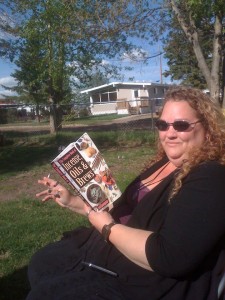 Heather Carr died shortly after catching fire while in a rock art sculpture in Riverside Park last week.Photograph by: Patheos.com photo , Kamloops This Week
Heather Carr died shortly after catching fire while in a rock art sculpture in Riverside Park last week.Photograph by: Patheos.com photo , Kamloops This WeekKAMLOOPS, B.C. — A B.C. woman who died this week after being found ablaze in Riverside Park was a former social worker in Merritt who went on long-term disability after three children in her case-management file were murdered by their father.
Heather Arlene Carr was discovered on fire by emergency responders just after 2 a.m. on Tuesday.
Firefighters extinguished the blaze but the 40-year-old died in hospital a few hours later.
Police initially suspected suicide, but BC Coroners Service investigators believe the death was accidental. According to posts on Facebook, Carr’s death was the result of a pagan ritual gone wrong.
Carr, a Thompson Rivers University graduate, was a social worker in Merritt. She had the file for Allan Schoenborn’s three children: Kaitlynne, Cordon and Max.
Schoenborn killed the three children in April 2008 inside the Merritt home they shared with their mother, Darcie Clark.
Carr went on stress leave after the murders and was later placed on long-term disability.
In 2010, Schoenborn was found not criminally responsible for the killings by way of a mental disorder. He remains in psychiatric custody in Port Coquitlam.
Carr was active among Wiccan groups on social media, operating a Facebook group called Being Pagan Out of the Broom Closet.
A post on that page said Carr died as a result of “severe burns suffered in a ritual gone horrifically wrong.”
The B.C. Coroners Service and the RCMP continue to investigate.
Source: The Province

Teens in Foster Hotel Fight
Girl Comatose
April 9, 2015 permalink
A teenaged girl is in a coma after she was beaten by a teenaged boy. Both teens were in custody of Manitoba CFS and housed in a hotel. CFS is placing the entire blame on the boy.
expand
collapse
Teen girl's family in shock over vicious attack in Winnipeg
'She didn't deserve that,' says aunt of teen, who remains in a coma
The aunt and brother of a 15-year-old girl who was viciously beaten this week in downtown Winnipeg say they're disturbed by the assault and the serious extent of her injuries.
"I'm still in shock. I can't believe that happened to her. She didn't deserve that," the girl's aunt told CBC News in an interview Thursday evening.
The teen has been in critical condition in a Winnipeg hospital since she was found badly beaten early Wednesday morning on Hargrave Street near St. Mary Avenue.
"I didn't want to believe it was my sister there," said the teen's brother.
 A 15-year-old girl who was attacked in downtown Winnipeg early Wednesday morning is shown in this Facebook photo. She cannot be identified because she a sexual assault victim, a minor and a ward of Manitoba's child welfare system.
A 15-year-old girl who was attacked in downtown Winnipeg early Wednesday morning is shown in this Facebook photo. She cannot be identified because she a sexual assault victim, a minor and a ward of Manitoba's child welfare system.The aunt and brother are not being named to protect the identity of the girl, who is a ward of the Child and Family Services system as well as a minor and a victim of sexual assault.
The aunt said her niece is in a coma with severe head injuries. Her head is badly swollen and she cannot open her eyes, she added.
"I only went for a visit for, like, 15 or 20 minutes. I didn't really want to stand that much longer, looking at my sister like that," the brother said.
"She might not even make it the next couple nights," he added.
Boy charged with aggravated assault
A boy, also 15 years of age, has been charged with aggravated assault and aggravated sexual assault.
Winnipeg police said the suspect and victim know each other.
Both were in government care and were housed at the same downtown hotel, a few blocks away from the place where the victim was found.
"It's my understanding that they were walking around together downtown and some kind of argument ensued between the two of them," Const. Chris Wingfield told reporters earlier Thursday.
The teen's aunt described her niece as a good girl who was kind to everyone, and her brother said he and his sister were very close. The siblings lived with their grandmother in a home in Winnipeg's North End.
However, they said the girl had friends who were a bad influence, and she ended up in the child welfare system in part because she was running away from home.
"Taking off every once and a while without telling my granny … that's part of the reason why," the brother said.
When asked what she would say to her niece's alleged attacker, the aunt said, "You almost killed my niece. You should've just walked away from her if she was getting you mad. You didn't have to beat her up so bad, because she looks really bad."
2nd incident in a year
The latest attack marks the second incident within a year involving a teenage girl who was in the child welfare system.
In August 2014, the body of 15-year-old Tina Fontaine was recovered from the Red River in Winnipeg, over a week after she was reported missing.
Like the victim in the latest case, Fontaine was staying at the same Winnipeg hotel while in care last summer. She left the hotel and disappeared.
Fontaine's death is being investigated as a homicide, but no arrests have been announced.
Her great aunt, Thelma Favel, said she's disgusted to hear there is now a similar case. She wants the provincial government to fix the system.
"They shouldn't be called Child and Family [Services] because they don't care," Favel said Thursday.
"They don't care about the child. They don't care about the families that love their child."
The province says it will end the practice of housing children in care in hotels — a practice that was meant to be a last resort — by June 1.
Manitoba has about 10,000 children in care, and on any given day, dozens are put up in hotel rooms because there aren't enough foster homes.
Source: CBC
Provincial child advocate Irwin Elman wants to ban the use of hotels for foster children in Ontario.
expand
collapse
Ontario urged to ban use of hotels, motels for foster children
String of Manitoba attacks prompts Ontario child advocate to demand ban on opaque practice of placing kids in hotels, motels when homes unavailable.
Ontario needs a policy to prohibit children’s aid societies from placing kids in hotels and motels when foster and group homes aren’t available, the province’s child advocate says.
“When the children’s aid is considering where they should put a child, I don’t want them to think about a hotel,” said Irwin Elman.
Manitoba announced Thursday it was banning the practice as of June 1 in the wake of a string of attacks on foster children being cared for in hotels.
A girl living in a Winnipeg hotel was sexually assaulted, beaten and left for dead Wednesday. A 15-year-old boy, also staying in the hotel, has been arrested.
Last November, 15-year-old Tina Fontaine was murdered after running away from a hotel placement.
Child welfare officials in Manitoba have had trouble finding enough foster and group homes to care for about 10,000 children, mostly aboriginal. They have been promising since 2006 to stop using hotels and motels where dozens are cared for on any given night.
Ontario’s Child and Family Services Act is silent on the use of hotels and motels, according to a spokeswoman for provincial children’s minister Tracy MacCharles.
“Following apprehension of a child, a Children’s Aid Society must place the child in a place of safety,” Ali Vitunski said in an email. “Hotels are not specifically mentioned.”
But the act doesn’t preclude their use.
The main concern is that a child must be safe and secure, Vitunski said. It would be up the discretion of individual agencies to use them, she added.
Elman asked the ministry how often Ontario children are placed in hotels and motels when news about Manitoba’s problems hit the headlines last fall.
“Here’s what we were told: We don’t know. And we don’t have any policies, directives or guidelines. We don’t think it’s a problem. But you should ask the agencies,” Elman said.
After writing Ontario’s 46 children’s aid societies, 24 responded to say that they rarely, if ever, used hotels or motels, he said.
“But what about the others? We just don’t know.”
Elman isn’t against children’s aid workers helping a former youth in care, who may be already living independently, stay in a hotel or motel for a short time to avoid going to a homeless shelter.
“But for children in care, if they have no group home or foster home available, I don’t want them to think, I know, we’ll use hotels,” he said. “I want them to get proper resources for kids. And the province needs a proper policy for that.”
Only one of the children’s aid societies Elman contacted mentioned any policies on the practice.
The Children’s Aid Society of Stormont, Dundas and Glengarry, which serves the Cornwall area near the Quebec border, acknowledged hotels and motels were regularly used in the area until about seven years ago “when our kids were in crisis and we had a shortage of homes.”
But under the agency’s revamped family-based care model “it ended the option to ever think that a child could go to a hotel,” director of service Angela Arcuri said in a telephone interview Thursday.
Under that model, the goal is to ensure that every foster child is cared for in a family setting. Of about 280 children in care in the agency today, all but one is living with a family, she said.
“It took a lot of (work) to be successful in helping locate different options for our kids other than hotels,” Arcuri said. “But it was worth it because the outcomes when our kids were there (in hotels) were very poor.”
A spokeswoman for the Ontario Association for Children’s Aid Societies, which represents the province’s 46 agencies, agreed that “hotels are not a good place for teenagers to live.” But the sector would be leery of a hard ban on their use, said Virginia Rowden.
Since children in Ontario can legally leave foster care at age 16, agencies don’t have many options to help if a child that age doesn’t want to go to a group or foster home setting, she said.
“You try to steer them to the best possible resource, perhaps a family member or a responsible adult they know,” she said. “But if nothing is going to work and the hotel is no longer a resource, are you saying go out and live on the street?
“I’d rather be able to offer a kid a hotel or motel room with a worker coming in or staying nearby or in the same suite than have the kid walk out.”
Source: Toronto Star
Child Protected by Punching Pregnant Mother
April 9, 2015 permalink
When the Hunt County Texas sheriff's office was called to assist CPS, the deputies knew how to protect the child of pregnant mother Deanna Robinson-Katsuki. They punched her while she was pinned in a corner. The punch is on video, YouTube and local copy (mp4). The video is incomplete because it came from a home security system that recorded in 30 second intervals, then switched to another camera. Two articles are enclosed, the mother's side and the sheriff's side. The sheriff says the mother tried to grab an officer's gun.
expand
collapse
Texas Deputies Caught on Camera Punching Pregnant Woman During CPS Visit
Texas deputies stormed into a home with state Child Protective Services workers workers to seize an 18-month-old child last month, forcing the child’s pregnant mother into a counter before punching her at least twice in the back of the head.
The mother, Deanna Robinson-Katsuki, who was almost nine months pregnant, ended up jailed for six days on charges on felony charges that she assaulted an officer and “interference with child custody.”
Part of the incident was captured on a home surveillance camera, a horrific 30-second video showing Hunt County sheriff deputies punching her at least twice as she screams to inform them that she is pregnant.
Since her release from jail, she has given birth, but that child was also seized from her by CPS, but placed in the custody of her mother. However, her 9-year-old stepson was also seized from her and placed in foster care, separated from her 18-month-old son who is in a different foster location.
The incident took place on March 4 at her parent’s home after she had agreed to meet with Department of Family and Protective Services, which is how Texas refers to the more commonly named Child Protective Services, who wanted to check on the welfare of her son.
She agreed to meet with them but when they arrived, they were accompanied by sheriff’s deputies who told her they were taking her son from her.
She asked for a court order, but the deputy flashed her a piece of paper and did not give her a chance to read it. When she asked to examine the document more closely, she said the deputy told her, “that’s not going to happen.”
That was when she attempted to shut the door on them, which led to the deputies forcing their way inside.
The video was first posted on Brett Sanders’ blog and is now going viral. This morning, Hunt County Sheriff Randy Meeks posted the following statement on the department’s Facebook page:

A Facebook page titled That Happened has also emerged in support of Robinson-Katsuki, which offers more details and photos, including a photo of a letter she received from the Quinlan Independent School District removing her from the “Quinlan ISD Hall of Fame,” where she was inducted in 2008 for her military services in Iraq in 2004, citing her arrest as “conduct deemed unworthy.”
But she has not been convicted.
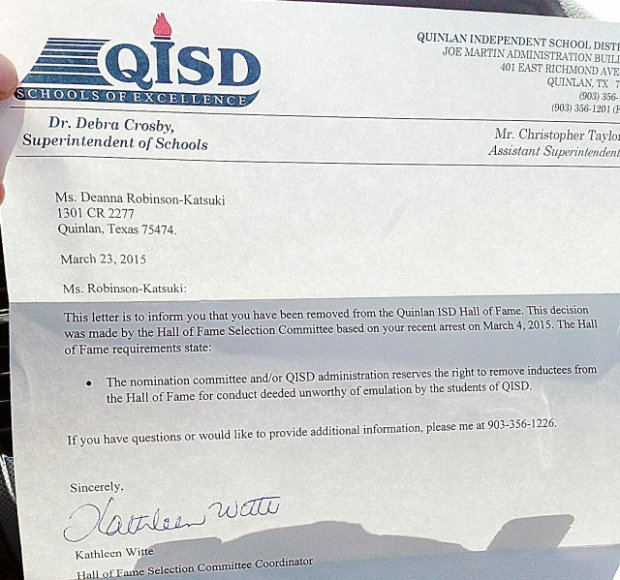
Also on the Facebook page is a post from a friend who is vouching for her credibility and innocence.
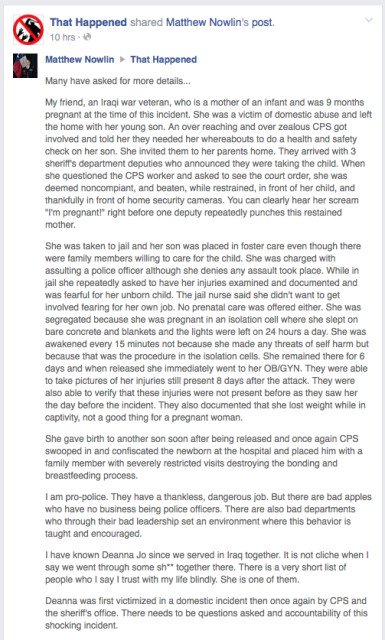
Below is her full statement to PINAC:
The Hunt County CPS investigators asked me to meet them at 8:30pm on the night of March 4, 2015 for an interview and health/welfare check of my 18 month old son. I complied.
At approximately 8:15pm there was a banging on the door that sounded like what I imagine the Gestapo might have sounded like. I opened it to see a large Hunt County Sheriffs Officer on the porch steps, there were 2 more officers behind him. He asked “Are you Deanna Robinson?” I said yes I am. He asked if I was the mother of (my 18 month old son’s name – which was horribly mispronounced) I said yes I am. He said “we are here to remove your son”. I replied “nobody is touching my child without a court order or a warrant….”
He reached behind him and one of the other officers handed him a solid, opaque pocket folder. He opened the folder, revealing approximately the top 1/3 of a sheet of white paper with writing on it. Then quickly closed the folder again and passed it back behind him. I asked to examine the document. He responded “that’s not gonna happen”, so I attempted to close the door again.
Before I could get it closed, he shoved the door open, in the process shoving me backward several steps into the kitchen. My son was standing behind me and a little to my left. All 3 officers had entered the kitchen by that point. The first officer yelled “there’s the kid, somebody grab him….”
I began screaming and trying to block his access to my child. He immediately grabbed me, spun me around and then the two officers seen in the video shoved me into the corner and forcefully pinned me there, slamming my knees, legs, thighs into the lower cabinets, slamming my abdomen into the kitchen counter and even pinning my head down onto the counter initially. I was handcuffed at that point. My parents quickly came to see what the commotion was and my mother grabbed my son to remove him from the middle of the physical aggression. Only after I had been handcuffed did the CPS investigators even bother to enter the house.
I was personally familiar with one of the investigators, Michelle (Hughes. The other CPS Investigator, who is seen turning around and watching my assault while remaining silent and offering no intervention is Jay Borton). She was well aware of my condition and the advanced stage of my pregnancy. At 38+ weeks pregnant, my appearance makes it quite obvious as well. When I noticed Michelle, I began screaming out for her to intervene or at least to verify/remind the Sheriffs Officer that I was pregnant. Again, she remained silent, did not intervene in any way and in fact, turned her head aside when I called out to her.
The video speaks for itself here. Near the end of the clip the officer who is standing aside can be heard to say “somebody shut her up”.
I cannot explain the short duration of the video clip because it was captured by a home security camera that was mounted inside the adjacent room on a wall. The system, apparently, was programmed to record for 30 second intervals and then shift to the next camera (I’m speculating here, based on what I was told. I didn’t install or have any personal knowledge of the camera or system).
Ultimately I was taken to the Hunt County Detention Facility and my son was taken from the arms and the safety of his maternal grandparents’ home, despite their protests, willingness, ability and repeated requests to retain physical custody of him. The paperwork and forms that CPS left behind were all marked “REFUSED NONCOMPLIANT” on the parent signature line, even though I obviously never even saw any of the forms, much less refused to sign them.
I was jailed for 6 days, charged with felony “Assaulting a Police Officer” and “Interference with Child Custody” while my family scrambled and borrowed to pay the bail bond. I am a decorated Veteran of the Iraq war; I have ZERO criminal history, no alcohol, drug or any other problems. I had never been arrested before this night.
During my incarceration I was kept in a holding/processing cell the entire time, and it was explained to me that this was because the facility lacked a medical area appropriate for a pregnant woman. The holding cells do not have beds and the fluorescent lights are left on 24 hours/day. Officers do checks on the holding cells every 15-30 minutes. Each time I encountered any medical personnel, I explained that I had been assaulted during my arrest and I asked to have my injuries documented (either on paper or with photographs). Each time (4 different encounters) I was denied with only the feeble explanation that I “could contact Internal Affairs if I wanted to pursue that kind of thing”. Despite repeated requests, I was never provided with prenatal vitamins or my regular medications.
On the third day, Jay Borton(the CPS Investigator who is seen in the video) came to the jail to meet with me. I was taken to an interview room where Borton placed his business card on the desk between us and stated “I’m Jay Borton, I currently have custody of your son. I’d like to ask you a few questions.”
I replied “I’d like to speak to an attorney, please sir.”
Upon hearing that he snatched the business card back up off the desk, slammed his folio shut and stood up. He began to walk out of the room but instead he stopped in the doorway and said “well, let me ask you this…do you want your court subpoena sent to your home address or your parents’ address?”
I replied “I’d like to speak to an attorney, please sir.”
Borton began to sneer at me “you’re a fool, you must WANT the State to make decisions about your kids” and then he left the room.
Once I was released on bond, I made an urgent appointment with my OB/GYN and finally had my injuries examined & documented and had the status of the baby evaluated.
I was actually inducted into the Quinlan ISD Hall of Fame in 2008 in association with an incident that happened during my deployment to Iraq in 2004. Subsequently I have been removed from the Hall of Fame, citing my arrest as the reason for removal.
As of today, my 18 month old remains in foster care (as well as my 9 year old step son, however they are separated in different locations) – I’m not allowed to know where he is, and despite a court order from March 13th that they be transferred to the custody of my parents. I have only been allowed to “visit” my son for an hour 3 times between the arrest and now. Each time I have been allowed to see him he was sick; with visible dark, runny snot, wheezing, sneezing, coughing and breathing difficulties (have video). He was otherwise perfectly healthy when he was removed. I have been adamantly insisting he get medical care and have been ignored, and eventually was told that I could not attend his medical appointments nor was I allowed to know the name of the provider/pediatrician who would be treating him.
My family and I had put in 3 separate requests to be able to have visitation with them for the Easter Holiday. The first request was verbal (in person but tape recorded), the second & third were in writing (email). They were all ignored. No reply or acknowledgement whatsoever.
I hope I have covered enough. Please feel free to reply if you have additional questions.
This is a developing story, so come back later for more details. There are still many questions that have not been answered, including why does it appear that one of the deputies appears to be wearing a shirt that reads “police” on the back.
It should be noted that since the incident, the Department of Family and Protective Services has come under fire from Texas Governor Greg Abbott after three children have died in its care this year.
Source: PINAC
Hunt County Sheriff Addresses Pregnant Arrest Video
Hunt County Sheriff Randy Meeks Wednesday addressed the circumstances around a video that appears to show a deputy punching a pregnant woman.
During a news conference, Meeks said deputies with the Hunt County Sheriff's Department were called in to assist taking custody of a child alleged to have suffered abuse or neglect.
Two deputies, a Quinlan police officer and two CPS workers arrived at the home of Deanna Robinson-Katsuki's parents and said they had a warrant to take custody of her 18-month-old son.
Robinson-Katsuki, who was 38-weeks pregnant at the time, asked to see the warrant and Meeks said deputies showed it to her and allowed her to read it.
Meeks said the situation quickly became chaotic as the woman began yelling that they weren't taking her child. She tried to close the door, but a deputy was able to push the door open and enter the residence.
Meeks said Robinson-Katsuki then became combative, shouted profanities and struck one of the deputies in the face.
At this point, Meeks said, the video in question begins and shows officers attempting to put Robinson-Katsuki under arrest for assaulting an officer, resisting arrest and interfering with child custody.
In the video, it's alleged by Robinson-Katsuki that the deputies pushed her into a corner as one of them hit her with his fist. Meeks said at the time when the woman was struck she was not handcuffed and that she was resisting arrest.
Meeks said there is more evidence present than what the video shows and that more time was needed for investigators with the Texas Rangers to determine what happened throughout the incident.
He added that saying a deputy punched a pregnant woman was only one possible narrative in the story and that a second possible narrative could be that a pregnant woman attempted to take a deputy's gun.
"I believe that we can say that that is a possibility," Meeks said. "Which narrative is correct? I don't know. That is for the Texas Rangers to determine."
When pressed by reporters, Meeks refused to definitively say whether Robinson-Katsuki tried to grab the officer's weapon, that it was only a possibility, and said his department was awaiting filing charges on the allegation until after the Texas Rangers completed their investigation.
"From what I understand, she had got some of his ammo belt off and was reaching for his gun when he delivered the blows to keep her from reaching his service revolver," Meeks said, of his discussion with his deputy about the incident.
"I don't know how many blows that the deputy made. I believe by looking at it that he was trying to keep her hands away from his gun. If someone gets your own gun, you can be killed by a pregnant woman as well as you could a 16-year-old child."
If the investigation shows the deputy acted outside of the law or violated policy, Meeks said the deputy will be prosecuted to the fullest extent of the law.
Meeks added that his office has not received any complaint from Robinson-Katsuki, or her attorneys, regarding the recorded incident.
The investigation by the Texas Rangers is ongoing.
Robinson-Kutsuki denies she reached for the deputy’s gun.
“That notion is ludicrous,” Robinson-Kutsuki said. “There is nothing that I did, and there is nothing in my mind that exists that warrants that kind of treatment on an extremely pregnant woman.”
Her attorney went on to tell NBC 5 they do not view an investigation by the Texas Rangers as independent, and they are calling for the officer to be removed from duty while the investigation continues.
“There is absolutely no excuse and no justification for what happened to me,” Robinson-Kutsuki said.
Source: KXAS
Fast for Grandson
April 9, 2015 permalink
A Manitoba woman is fasting until the province returns her baby grandson to her family. Even on a hunger strike, the press will not disclose her name.
expand
collapse
Woman fasting to protest CFS decision to take grandson
Meghan Roberts reports on a woman who is fasting to protest the seizure of her grandson by Child and Family Services.
A woman, who can’t be identified because her grandchild is in the care of Sagkeeng Child and Family Services, says she will fast until the child is returned.
She said her one and a half year old grandson was taken from her 17-year-old daughter after the girl missed a curfew in her group home.
"Even if she was 3 or 4 hours late, why take him?” she asked. “There's no drugs or alcohol or abuse."
 A woman, who can’t be identified because her grandchild is in the care of Sagkeeng Child and Family Services, says she will fast until the child is returned.
A woman, who can’t be identified because her grandchild is in the care of Sagkeeng Child and Family Services, says she will fast until the child is returned.The woman said she was not contacted before the child was placed in care.
According to the women, both she and her other daughter, who is 30-years-old, volunteered to provide a safe home for the child, but Sagkeeng CFS said no.
The woman says a previous file with CFS regarding an incident related to the family, but not perpetrated by a family member, is holding up the process.
The woman began a spiritual fast on Saturday to demand the return of her grandson to his family and bring awareness to the issue of children in care.
Source: CTV Winnipeg

Innocence is No Defense
April 8, 2015 permalink
Parents encountering child protectors often believe that as long as they have done nothing wrong the courts will preserve their family. That is not how the law works. In case there was any doubt, a California court has removed a teenaged daughter from blameless parents who did all the right things.
expand
collapse
California court: State can take custody of out-of-control kids even if parents not to blame
SAN FRANCISCO — The state can remove an out-of-control child from the custody of a parent even if the mother or father is not to blame for the child's behavior, a California appeals court said Thursday.
If children face substantial risk of harming themselves, it doesn't matter whether the parent did anything intentional to put them in that position, the 2nd District Court of Appeal ruled.
"When a child thereby faces a substantial risk of serious physical harm, a parent's inability to supervise or protect a child is enough by itself to invoke the juvenile court's dependency jurisdiction," the court said in its 3-0 ruling.
The court disagreed with another state appellate court that ruled in 2010 that a parent had to be shown to be culpable for a failure or inability to supervise or protect a child. Such conflicts between appeals courts are often resolved by the state Supreme Court.
Thursday's ruling goes against the commonly accepted understanding that a court has to find the parents did something wrong to remove the child, said Dan Mayfield, a San Jose attorney who specializes in juvenile law.
"It broadens the government's power," he said.
The ruling came in the case of a Los Angeles County mother whose teen daughter repeatedly ran away from home and had a child at the age of 15. The appellate court said the girl remained incorrigible despite her mother's best efforts, which included looking for her each time she left home, sending her to live with her grandparents and calling the police and Los Angeles County Department of Children and Family Services for help. The mother was identified in court documents only as "Lisa E." and her daughter as "R.T."
"(The) mother in this case was neither neglectful nor blameworthy in being unable to supervise or protect her daughter," the court said.
But state law is clear that children can still be taken if they have suffered or are at substantial risk of suffering serious harm that a parent is unable to stop, Associate Justice Brian Hoffstadt wrote.
"We do appreciate the clarification the court made that the welfare of the child is what's paramount here," said Armand Montiel, a spokesman for the Los Angeles County Department of Children and Family Services. "Our work is based on the fact that the child's safety is job one."
The court's ruling upheld a juvenile court's decision to assert control over R.T. and allow the county to place her elsewhere. The county placed her back with her grandparents.
The mother appealed the decision. The girl turned 18 while the appeal was pending.
A call to the mother's attorney was not immediately returned.
Source: Minneapolis Star-Tribune
No Cross-Dressing for Tots
April 8, 2015 permalink
When Jennifer Giordana let her five-year-old daughter Maddie dress in a boy's Easter outfit, Texas child protective services stepped in to save the girl.
Child protectors are supportive of gay and lesbian adults, even boasting of a high level of adoptions by same-sex couples. [1] [2] [3] [4] [5] [6]. But the slightest hint of irregularity in a child is grounds for intervention.
expand
collapse
Mum of 'tomboy' girl accused of child abuse for letting her pick boys' outfit for Easter
Jennifer Giordana let her five-year-old daughter pick out a boys' suit rather than a frilly dress for an Easter outfit
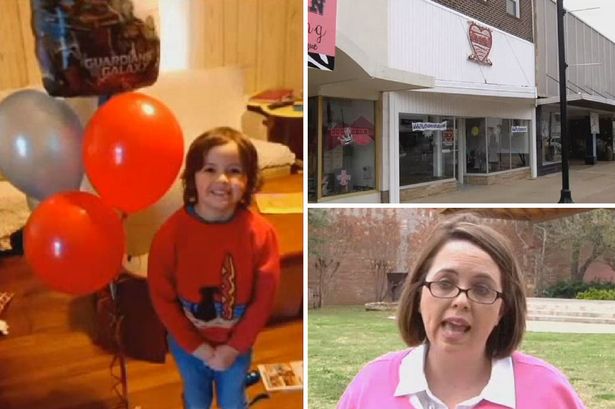 kten.com
kten.comA mum who let her five-year-old 'tomboy' daughter pick out an outfit designed for boys has been accused of child abuse.
Jennifer Giordana let her daughter Maddie pick out a traditional boys' suit as an Easter treat rather than a frilly dress from the girls' section.
But Jennifer said the shop assistant was filled with "disgust" when she saw Maddie in the outfit and the little girl left the store in tears.
"The woman's face was just a face of disgust," said Jennifer, who was shopping in Martha's Miniatures in Texas.
"She told me that I was promoting wrong behavior and that parents should not let their children choose the way that they dress if it's cross-gendered."
Jennifer told American news site KTEN: "Maddie's a tomboy.
"She's preferred to dress in boys' clothes since she was about three years old."
The upset mum then posted about her experience on Facebook and supportive friends responded by giving the business one-star reviews.
But a Martha Miniatures' employee hit back, saying: "I was so shocked she asked for a boys' suit for the child.
"I asked her why she was encouraging this."
Another post went on to say: "This is child abuse from the mother."
The store's Facebook page has since been removed.
Although laws against business discrimination are in force in Texan cities such as Austin, Dallas, Houston and Fort Worth, Grayson County – where the store is located – does not.
Attorney Bobbie Peterson-Cate said: "It depends on what they're refusing the service for – for sexual orientation, no, it is not illegal."
But Giordano thinks it is still a bad business move to look down on her for allowing Maddie to dress how she wants.
"People don't need to pick on little kids for what they're wearing," she said.
Source: Daily Mirror (UK)
Parents Not Heard
April 8, 2015 permalink
Parents in child protection actions rarely get a chance to speak during the court hearings that determine the fate of their children. The judge does not invite them to give their side, and parents who attempt to speak are menaced by bailiffs rattling handcuffs.
An NPR report (mp3) on a recent judicial decision has brought this practice to light.
Source: NPR
Giving Birth Incognito
April 8, 2015 permalink
Rosemarie M Chavez, who had already lost custody of eleven children, tried to save her twelfth by giving a false name to her California maternity hospital.
expand
collapse
Mom gave birth under fake name to give officials the slip
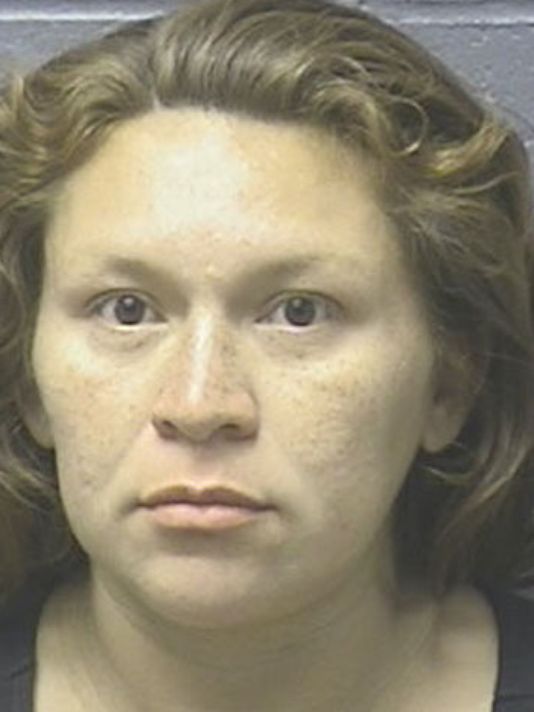 (Photo: Yuba County Sheriff's Office)
(Photo: Yuba County Sheriff's Office)MARYSVILLE, Calif. — A woman who gave birth to her 12th child in a neighboring county gave the hospital a fake name to avoid child-protection workers, authorities said.
Rosemarie M. Chavez, 36, was booked Saturday into Yuba County Jail here on a suspicion of child stealing charge, said Sgt. Tom Oakes of the Yuba County Sheriff's Office.
Chavez had signed a contract with Yuba County Children's Services, agreeing to check in with the agency after she gave birth. However, she checked into a hospital in Nevada County using a pseudonym, had the baby, then checked out, Oakes said.
Police eventually caught up to Chavez in Solano County, but her 8-day-old baby was not with her when she was taken into custody. The baby's father, who was not arrested, helped lead police to a fourth county, Santa Clara, where they found the baby in San Jose, Calif.
Chavez' other 11 children are in protective custody, Oakes said.
Chavez has a history of drug abuse and child neglect, a Yuba County Children's Services spokesman told KOVR-TV, Sacramento.
Source: USA Today
British Election
April 5, 2015 permalink
Britain will be electing a new parliament on May 7. Christopher Booker comments on what ought to be a campaign issue — the child protection system.
expand
collapse
Children in care – the scandal that this election will ignore
In the past few years, record numbers of children have been taken by the government into a broken system, writes Christopher Booker
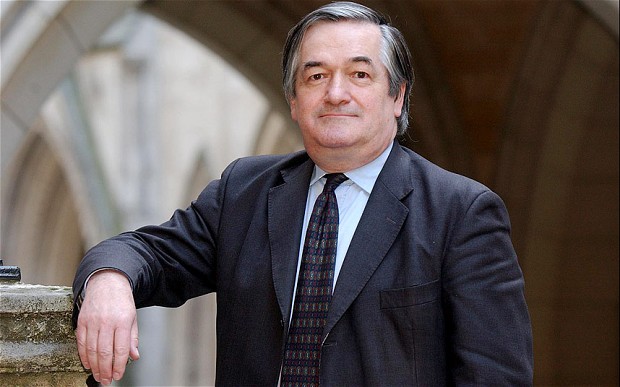 Sir James Munby, president of the Family Division of the High Court, said the public had a right to know “what is being done in their name” and called for the courts to adapt to the internet eraPhoto: BRIAN SMITH FOR THE TELEGRAPH
Sir James Munby, president of the Family Division of the High Court, said the public had a right to know “what is being done in their name” and called for the courts to adapt to the internet eraPhoto: BRIAN SMITH FOR THE TELEGRAPHOver the coming weeks, I hope to explore some of the huge political issues that will scarcely be mentioned in this claustrophobically unreal election campaign. This week it is what I have often described here as one of the most disturbing scandals in Britain today, the catastrophic state of our highly secretive “child protection” system.
By any measure, this should be a political issue. Largely hidden from public view, it operates almost entirely under laws passed by Parliament. But we are given many horrific glimpses of just how badly it has broken down, in ways those laws never intended – not least in the horrific abuse of some 2,000 children in Rotherham, Oxford and elsewhere, many of whom were in the state “care” system.
In the past few years, record numbers of children have been taken into this system, currently almost 100,000 in the UK as a whole. Yet there is ever more evidence to show that far too many of them have not only been snatched from their families for wholly inadequate reasons (while the plight of others, such as Baby P, is ignored), but then suffer far more in “care” than they did before they were removed.
This system has become a major industry. With our 80,000 foster carers earning up to £500 a week or more for each child, the cost of “looked after children” alone has soared to nearly £4 billion a year, and within five years, according to the Local Government Association, “children’s services” will account for a fifth of all the money raised in council tax.
Of late, thanks above all to the heroic efforts of Sir James Munby, the current head of our family courts, some senior judges have been questioning parts of this system more trenchantly than ever before. In one recent judgment, (2015) EWFC 11, Munby went out of his way to highlight some of the methods whereby local authorities and social workers routinely flout basic principles of the law by bringing cases for the removal of children that rely only on unsubstantiated allegations and hearsay, “sometimes at third and fourth hand”.
He has emphasised before how removing a child from its parents is one of the most serious decisions the courts and the state can ever take. Yet what may seem to a local authority an “impressive” case, as in the one he was hearing, too often turns out to be only a “tottering edifice based on inadequate foundations”.
One could cite a whole succession of recent judgments, by Munby and others, where local authorities, social workers and even other judges have been torn apart for their flagrant disregard of both the spirit and the letter of the law as laid down by Parliament. But with one or two shining exceptions, notably John Hemming (who deserves, regardless of his party, to be soon returned as Lib Dem MP for Yardley, Birmingham), our politicians never seem to question what is going on in their name, or even to show the slightest interest in it.
The only responses of successive governments, both Labour and the Coalition, have been smugly to defend the system, claiming that if it goes wrong at all this is only in “a tiny minority” of cases, and to do all they can to drive up the mere 5 per cent of children in “care” who now go on to be permanently adopted.
One disastrous consequence of this has been merely to encourage the social workers to take even more loved and undamaged children into “care” because it is much easier to find parents to adopt them.
The scale of the unnecessary suffering all this is inflicting on tens of thousands of children is unimaginable. Despite the heroic efforts of a handful of judges, the only people who can ultimately do something to remedy this colossal scandal are the politicians. But in this election, as on so much else, they will remain oblivious and silent.
Source: Telegraph (UK)
Wikwemikong Creates Native CAS
April 3, 2015 permalink
Wikwemikong has established its own native child protection agency. This is the same area that saw baby Malachi Beaudry die after less than two days in Sudbury CAS custody. [1] [2].
expand
collapse
Wikwemikong establishes child protection agency
Wikwemikong First Nation child protection agency writes its own Children’s Bill of Rights
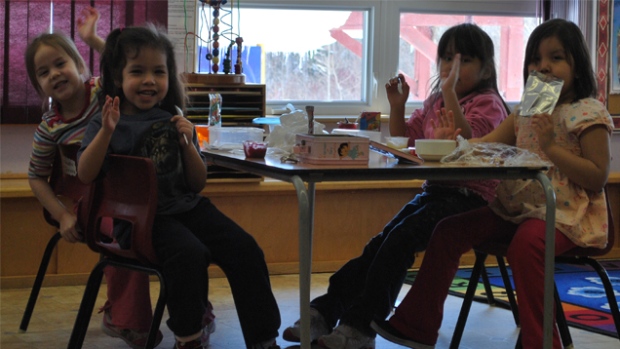 Ontario's children's advocate Irwin Elman says Wikwemikong's new child protection agency will help children maintain their culture and family ties.wbe-education.ca
Ontario's children's advocate Irwin Elman says Wikwemikong's new child protection agency will help children maintain their culture and family ties.wbe-education.caWikwemikong is the latest First Nation community in northern Ontario to certify its own child protection agency. The Manitoulin Island-based agency joins six other aboriginal children's protective agencies in the region.
The children's advocate for Ontario said Wikwemikong is well qualified to keep its children safe and rooted in its culture.
Irwin Elman visited Wikwemikong recently and said he was impressed.
"I certainly heard the need for a community based child welfare system and service in that community and I welcome it."
Elman said the Ministry of Children's and Youth Services encourages First Nations to form their own children's protective agencies. He said it helps children maintain their culture and family ties, but it is a rigorous process to form the agency.
"They are able to adopt practices, cultural practices, that are appropriate for the community," said Elman. "But there's not a lessening of standards in terms of how much protection a child needs or the amount of care and nurturing they get."
Elman said the Wikwemikong agency will succeed because it has a strong sense of community. He said the agency has written its own Children's Bill of Rights.
"I think under Chief Peltier's leadership there and his council, I think that's a remarkable achievement."
Source: CBC
Success vs CAS
April 1, 2015 permalink
Chris York recently had a CAS action against his family that he was not free to tell about. Now he can give the full story.
expand
collapse
Chris York
April 1, 2015
UPDATE UPDATE UPDATE:
Here it is folks......
As I was previously under a gag order via section 45(8) of the CFSA as you all are aware... today was the day I had to attend court against the CAS in a child protection case. Kim Shook was in attendance with me and first of all I would like to start by saying...
Kelly Aird (CAS worker).... I TOLD YOU SO!
Secondly it is with great pleasure to tell you all that the CAS has withdrew its application entirely as I knew they would with no findings of any child in need of protection and then went on to state that they wished to thank me for providing such great care for my children based on the medical info that was brought forward to the court and it is clear that myself and my wife Pam Smart-York are providing great care to meet the medical needs of both of our children and thanked us for providing such in depth reports to the court and as such fully believe that the childrens medical and emotional needs are being met. They stated cooperation is paramount in their investigation which of course I laughed under my breath as this never happend and never will.
So it is very possible folks to beat these monsters and as I stated before I DO PRACTICE WHAT I PREACH IN THIS GROUP WITH MY OWN ADVICE.
I hope others can learn from this and move forward and I look forward to assiting many more of you in the future going forward.
It is a bittersweet day and I feel like I just hoisted the Stanley Cup for the first time ever.
Case dismissed on the very 2nd court appearance and they stated that they hope they never have to see me in court again in the future.
As a result of the case no longer being a proceeding before the court section 45(8) NO LONGER APPLIES
CASE CLOSED!!!
VICTORY VICTORY VICTORY!!!!!!
Source: Facebook, Stop the CAS ...
Complaint Against Judge Wood
Particulars of DH Suit
March 31, 2015 permalink

Father DH has requested that some material formerly in this article be deleted at least temporarily.
Privately, DH reported that at a court hearing presided by judge Wood after the request the judge changed his attitude, actually administering the law properly. Then in May DH filed his Plaintiff's Response to the Demand for Particulars. To keep all this material in one place, find the documents on the page DH vs Family, Youth And Child Services Of Muskoka" . Link to an earlier article on DH
The tiny Muskoka children's aid society, and judge Wood, have been the subject of a disproportionate level of complaints for the past several years. On April 1, Muskoka CAS will be merged into Simcoe Children's Aid in Barrie.
British Columbia Lets Baby Die, Mother Sues
March 29, 2015 permalink
Baby Isabella Wiens died in British Columbia foster care on March 16, 2013. In common with other foster deaths, mother Sara-Jane Wiens reported bruises on her baby during visits, but social workers ignored her. For two years she has been unable to find out what really happened to her daughter. Now she has resorted to a lawsuit against the province.
expand
collapse
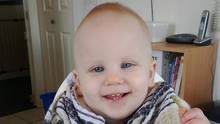 Isabella Wiens, shown in a family handout photo, died in foster care, according to a lawsuit filed by her mother Sara-Jane Wiens against the B.C. Ministry of Children and Family Development.Handout from Sara-Jane Wiens/THE CANADIAN PRESS
Isabella Wiens, shown in a family handout photo, died in foster care, according to a lawsuit filed by her mother Sara-Jane Wiens against the B.C. Ministry of Children and Family Development.Handout from Sara-Jane Wiens/THE CANADIAN PRESSMother sues B.C. after daughter died in foster care
When Sara-Jane Wiens learned her 21-month-old daughter had died in foster care, she ran out of her back door and “screamed bloody murder.”
“I couldn’t believe what I was hearing,” she recalled, her voice breaking. “My heart sank. My whole world came crashing down before my eyes that day.”
Two years later, Wiens said she’s still searching for answers. The 25-year-old has filed a lawsuit against the British Columbia government and the province’s director of child, family and community services alleging recklessness and bad faith.
The civil lawsuit states her two-month-old daughter, Isabella, was taken from her in August 2011 after she was deemed unfit to care for her. Wiens suffers from a learning disability that causes anxiety and depression.
In March 2013, the toddler was found dead in the crib at her foster home.
The lawsuit alleges that the government didn’t properly supervise Isabella while she was in foster care and failed to adequately consider returning the child to her mother.
“The system failed me, and I trusted the system with my flesh and blood,” Wiens said in an emotional phone interview from Ontario, where she now lives.
“If one thing can get changed to prevent this from happening to another person, then I know I was able to make that small change.”
Wiens said she noticed bruises on her daughter during supervised visits and told her social worker but nothing was done.
A coroner’s report could not determine the cause of death, but said there were several bruises on the body and indications of healing fractures on the girl’s left arm that couldn’t be explained.
Children and Family Development Minister Stephanie Cadieux said the ministry launches a review any time a child dies in care, but would not comment on the specific case.
“The oversight for our Ministry — and the children in our care — is extensive but entirely appropriate given the often vulnerable population we serve,” she said in a statement.
Mary Ellen Turpel-Lafond, B.C.’s representative for children and youth, said the foster home has been shut down after a ministry investigation.
Turpel-Lafond said she would like to see the ministry and coroner’s service sit down with families and debrief after the death of a child.
“They’ve lost a precious child, their family is very devastated, they don’t feel like they’ve had answers. I’d like to see the answers that they’d like to see,” she said.
Wiens’s lawyer, Jack Hittrich, said his client had to fight for nearly eight months to see a copy of the coroner’s report.
The circumstances surrounding Isabella being taken into ministry custody are not yet clear. Hittrich said the B.C. ministry falsely alleged Wiens was fleeing a child protection order in Ontario, but in fact she left the province to escape an abusive ex-boyfriend.
“She is told that she cannot parent because she poses a risk to this young child,” he said. “The child is scooped from her. There’s no attempt made to work with her to reunite her with her child. They then completely abdicate their responsibility to monitor the foster home and attend to these injuries.”
Source: Globe and Mail
Psychotropic Drugs Kill 150 People
March 29, 2015 permalink
On March 24 Germanwings Flight 9525 crashed near the village of Barcelonnette France, killing all 150 people on board. Once the voice recorder was recovered, investigators found that co-pilot Andreas Lubitz locked the captain out of the cockpit during a washroom break, then took the plane into a ten minute descent into the French Alps.
The world's most authoritative news sources are corroborating what the fringe press has been saying for days. Andreas Lubitz had antidepressant drugs in his apartment. So either he was on psychotropic drugs at the time of his suicide, or even worse, had withdrawn from drugs. During withdrawal, the patient experiences the opposite of the intended effect of the drug. That would have made Lubitz more depressed, and more suicidal, than before starting his treatment.
For two decades there have been regular mass shootings by deranged killers. The common element in most is the use of psychotropic drugs by the shooter. In previous incidents the psychotropic drug connection has been downplayed. The excuse of patient confidentiality has kept the details of drug use out of the press. But how can the airline industry avoid exposing the full details this time? Anything less would risk repeated murder/suicides of hundreds of passengers at a time.
expand
collapse
Germanwings Crash Raises Questions About Shifting Ideas of Pilot Fitness
Aviation agencies in Europe and the United States once banned all pilots from flying if they disclosed a mental illness to their employers.
But in recent years, bowing to advances in scientific understanding and a growing public awareness that common mental disorders like depression are treatable, regulators loosened those restrictions, allowing the use of certain antidepressants for a small number of pilots and permitting some pilots whose illnesses were mild to stay on the job. In doing so, agency officials said, they hoped to encourage pilots who were experiencing problems to come forward and seek treatment.
Now the crash of Germanwings Flight 9525 on Tuesday has raised questions about how well those policies work and whether airlines and regulators are doing enough to detect pilots who are too mentally ill to fly.
The authorities have said that Andreas Lubitz, the co-pilot who is believed to have intentionally crashed the German aircraft, killing himself and the other 149 people aboard, had a mental illness and hid the diagnosis from his employer. The exact nature of his disorder remains unknown, but Mr. Lubitz apparently sought treatment for vision problems that may have jeopardized his ability to work as a pilot. Still uncertain is whether there is a link between Mr. Lubitz’s vision problems and his psychological issues. On Saturday, an official said that the police had found antidepressants during a search of his apartment in Düsseldorf.
Here’s what we know (and what we don’t) about Andreas Lubitz, the pilot believed to have crashed a Germanwings plane in the French Alps, according to investigators:
What We Know
- The French prosecutor in charge of the case has said that Mr. Lubitz, the co-pilot, was alone at the controls of the Airbus A320 in the ten minutes before the crash. Mr. Lubitz did not respond to pleas from the captain to be readmitted to the cockpit and set the plane on a descent course that took it into the mountains, the prosecutor said.
- Mr. Lubitz had been receiving treatment for a psychological or psychiatric condition that he did not disclose to his employer.
- He had also sought treatment for a vision problem.
- He had doctors’ notes in his apartment in Düsseldorf excusing him from work, including one good for Tuesday, the day of the crash.
- His pilot’s license included a designation indicating that he had a medical condition.
- Antidepressants were found in his apartment.
What We Don’t Know
- When his psychological problems began, their severity and precise nature, or when he began treatment.
- The severity of his eye problems, when they first occurred or whether they could have been psychosomatic and related to his psychological problems.
- What antidepressants he might have been prescribed, at what dose and whether he was taking them.
- Whether any family members, friends or colleagues were aware of his problems and raised any flags with the airline about his suitability to fly.
- Whether an interruption in his pilot training was related to any psychological or medical problems.
Since the crash, European airlines have scrambled to require that two people be present in the cockpit at all times, a rule already in place in the United States. But many experts said the focus should now be on improving the process of hiring and screening pilots to better guard against someone like Mr. Lubitz getting into the cockpit in the first place.
The programs currently used by airlines and regulators on either side of the Atlantic, aviation experts and psychiatrists said, leave much to be desired. Screening exams are given on a yearly basis and often merely nod to mental health issues, including only a few questions about depression or other illnesses. The exams are often conducted by general practitioners with no psychiatric expertise.
In addition, most programs are based on an honor system, relying on pilots to volunteer information about problems they might have. And to do that, several psychiatrists said, they must overcome the stigma that still clings to mental illness, one that remains strong in commercial aviation, a profession with deep roots in the military that values a cool head and steady hand under pressure.
The screening process for pilots “really falls short for people who are involved in the public’s safety,” said J. Reid Meloy, a forensic psychologist who consults on threat assessments for corporations and universities.
The practice of screening only once a year is a particular problem, he said, because any number of life events — the breakup of a relationship, the death of a loved one or other setbacks — can affect mental functioning. Rather than coming out of nowhere, suicide often represents a convergence of troubled strands. Investigators who delve into a suicide victim’s background — interviewing relatives, co-workers and friends in what is called a psychological autopsy — almost always find a troubled history and often uncover hints about suicidal intentions that were overlooked or ignored by others.
A study of eight deliberate airplane crashes from 2003 to 2012, for example, found that five of the general-aviation pilots had intimated their plans to others beforehand.
But while suicide is rare, depression is one of the most common mental disorders: Government surveys suggest that one in 20 American adults have an episode of major depression each year and one in 10 take antidepressant medications.
And identifying a person whose condition poses a threat to public safety is not always easy, said Dr. Andrew Brown, president of the Academy of Organizational and Occupational Psychiatry.
“You have to get a sense of who this person really is, of what their coping mechanism is, of what their defenses are, in terms of how they characteristically deal with adversity,” Dr. Brown said. “It goes without saying that you have to ask them specifically if they have ever had thoughts of suicide.”
Screening systems in Europe closely mirror those imposed by regulators and airlines in the United States, aviation experts said, and in most cases, the tests that would-be pilots must pass to be licensed are focused far more on physical than mental health.
Crashes caused intentionally by pilots are very rare but not unheard of.
Dr. Warren Silberman, a former manager of aerospace medical certification for the Federal Aviation Administration, said that in the United States, pilots applying for a license must fill out an online medical questionnaire. Only three questions on the form deal with mental health, he said.
“There is no specific psychological testing,” he said.
Before they are licensed, pilots must undergo a medical exam, conducted by a doctor trained and certified by the aviation agency. Some airlines impose additional screening procedures, but they vary from company to company. Active pilots are required to have a medical screening once a year until they turn 40 and then twice a year after. Only when pilots are found to have mental health problems are they sent to a psychiatrist or psychologist for evaluation or treatment.
But the system, Dr. Silberman and others said, leaves pilots on an honor system, albeit one reinforced by penalties to discourage them from concealing any health issues that could affect their fitness to fly, including mental illness. Pilots who falsify information or lie about their health face fines that can reach $250,000, according to the F.A.A.
But Peter Goelz, a former managing director of the National Transportation Safety Board, said the system left a lot of wiggle room for pilots. For example, pilots are allowed to choose doctors, and can pick someone who might be less likely to report any difficulties.
“They know which guys are more cordial to their concerns and which are not,” Mr. Goelz said. “My guess is that the industry and the F.A.A. will look at this closely.”
Martin Riecken, a spokesman for Lufthansa, the parent company of Germanwings, said that airline’s screening procedures were similar to those in Europe and the United States.
Pilots are rigorously screened for physical problems before they are hired and fill out a questionnaire intended to vet their psychological fitness. Examination by a psychologist or psychiatrist is not a routine part of screening, he said.
As in the United States, pilots are required to report to the company any medical or psychiatric condition that might make them unfit to fly, Mr. Riecken said. But he added that in Germany, a private doctor who is consulted by a pilot is under no legal obligation to inform the airline about the pilot’s physical or mental state.
Seeking help from outside doctors is a common practice among pilots in Europe, said Dr. Alpo Vuorio, a researcher at the Mehiläinen Airport Health Center in Finland who has studied depression in pilots and pilot suicides. And few pilots inform the airlines that they have done so.
Without a strict reporting system, accountability suffers, he said. “People start to find services all around the country and even from different countries, and then it’s lost,” he said.
In Mr. Lubitz’s case, the Düsseldorf University Hospital said in a statement that he had been seen at their clinic in February and a final time on March 10 for what it called a “diagnostic evaluation.” The hospital refused to give further details, citing Germany’s privacy laws for medical records, including those of the dead, but denied reports that the co-pilot had been treated for depression. Prosecutors said that several doctors’ notes stating that Mr. Lubitz was too ill to work, including on the day of the crash, were found at his home; one of the notes had been torn up.
Because pilots and flight crews spend so much time working together in close quarters, airlines often rely on employees to monitor their colleagues’ behavior and raise concerns when a pilot appears unfit for flying.
“It’s very hard for mental illness to hide under those circumstances,” said Dr. William Hurt Sledge, a professor of psychiatry at Yale who has served as a consultant to the F.A.A., as well as to the Air Line Pilots Association and a number of carriers.
Yet Dr. Sledge conceded that the screening tools available were inadequate to the task of detecting a pilot determined to hide any signs of distress. Mr. Lubitz was heard on the flight recorder chatting amiably with the captain before locking him out of the cockpit.
And given the stigma attached to depression, many pilots who have the illness do hide their symptoms, a fact that led the F.A.A. in 2010 to revise its policies, allowing pilots to take antidepressant drugs in some circumstances and continue flying.
“We know more today about the science of the medications being given and we know a lot more about depression itself,” said Randy Babbitt, the F.A.A. administrator at the time, in announcing the new policy. The European aviation agency followed suit a few years later.
Dr. Silberman, the former F.A.A. medical manager, said that the agency’s thinking evolved over years and that many within the agency were reluctant to change its policies, worried about the side effects of the drugs.
“This was an effort to let guys know that once you start getting better and you are treated, you can fly again,” he said. But he added that the agency was careful in its decisions about who could keep flying and that pilots taking the medications must follow a treatment plan and be closely monitored.
Dr. Ryan Shugarman, a psychiatrist in Alexandria, Va., who performs mental health evaluations of pilots and air controllers for airlines and the F.A.A., said he had seen one case in which an applicant to be a pilot had suicidal thoughts, but never one where a pilot threatened to bring down a plane.
“My experience is that there’s a lot of support among the aviation community for getting treatment,” he said, adding that he supported the F.A.A.’s change in policy because before it was made, pilots were going to outside doctors for mental health treatment and concealing it from their employers.
Whether the crash of Flight 9525 will prompt calls for the agency to revert to its earlier conservatism remains to be seen.
“I hope not,” said Dr. Vuorio, the Finnish researcher. “This is a good practice, in good hands.”
Correction: March 29, 2015
An earlier version of this article described incorrectly a patient whom Dr. Ryan Shugarman, a psychiatrist in Alexandria, Va., had evaluated. The patient was an applicant to be a pilot, not a pilot.
Source: New York Times
Grand Theft Bambino
March 29, 2015 permalink
British parents could be reported to police and social services for allowing their children to play video games such as Call Of Duty and Grand Theft Auto. With this move, the social services watch over children will approach 100 percent.
expand
collapse
Parents who let kids play Call of Duty could be reported to police
The adult video games could increase 'early sexualised behaviours', primary school headteachers in Nantwich warn
Primary school headteachers have warned parents who allow their children to play video games such as Call Of Duty and Grand Theft Auto will be reported to police and social services for neglect.
The Nantwich Education Partnership, made up of 15 primary schools and one secondary academy, issued a letter after children reported playing or watching the adult-themed games.
The heads said the video games could increase "early sexualised behaviours" and the advice was in line with local authority policy and concerns.
The letter, sent last month, said: "Several children have reported playing or watching adults play games which are inappropriate for their age and they have described the levels of violence and sexual content they have witnessed: Call Of Duty, Grand Theft Auto, Dogs Of War and other similar games are all inappropriate for children and they should not have access to them.
"If your child is allowed to have inappropriate access to any game or associated product that is designated 18-plus we are advised to contact the police and children's social care as it is neglectful.
Parents were also warned about allowing their youngsters to have accounts on social media sites such as Facebook and WhatsApp because it could make them vulnerable to sexual grooming.
 A screenshot from Grand Theft Auto: Vice City
A screenshot from Grand Theft Auto: Vice CityThe letter went on: "Access to these games or to some social media sites such as those above increases early sexualised behaviours (sometimes harmful) in children and leaves them vulnerable to grooming for sexual exploitation or extreme violence."
Source: Telegraph (UK)
Social Worker Prosecuted.
March 28, 2015 permalink
Florida social worker Shani Smith falsely reported that she had referred mother Catalina Bruno for a substance abuse and mental health evaluation. The mother later let her baby boy Bryan bake to death in a car. That was one of several incidents that led to the resignation of DCF Secretary David Wilkins in 2013. Now Smith is being prosecuted. In cases of failure to intervene in a family, the social worker becomes the scapegoat. When a child dies from unnecessary intervention, the foster parent becomes the scapegoat.
expand
collapse
Former Miami DCF investigator arrested for falsifying records
Child welfare investigator Shani Smith broke the law when she concocted reports about a Kendall woman who later left her baby son to die in a sweltering car, authorities said.
The allegations against the former Florida Department of Children and Families employee first surfaced in 2013. On Wednesday, she surrendered to face six felony counts of official misconduct.
The investigation of Smith had been yet another black eye on the state child welfare agency. The boy’s death was one of several in the fall of 2013 that eventually led to the resignation of then-DCF Secretary David Wilkins.
At the time of her resignation, it was revealed, Smith had been working without the proper state credentials. In interviews with the press, Smith had always maintained she did nothing wrong.
Her attorney, David Kubiliun, said Wednesday that she will fight the allegations.
“I feel she’s being made a scapegoat for the department,” Kubiliun said. “They’re trying to use her as a fall guy.”
The alleged misconduct was uncovered by DCF’s Inspector General, and forwarded to prosecutors and FDLE.
“This former employee violated the public trust and did not uphold the standards we expect for those entrusted with the duty of protecting children in our community,” DCF said in a statement Tuesday.
Smith is not the first Florida child welfare employee to come under scrutiny for bogus reports in recent years.
Last year, police in Seminole County arrested Jonathan Irizarry, a case worker with the Children’s Home Society of Florida, for falsely claiming in reports that he had visited and examined a healthy child. The child had been tortured and beaten to death.
In Broward County, foster care caseworker Jabeth Moye reported that a 12-year-old named Tamiyah Audain was doing fine. Actually wasting away of starvation and neglect, the girl died in September 2013.
Last year, Moye was charged with child neglect. Moye worked for a foster care agency under the umbrella of Broward’s privately run child welfare agency, ChildNet, which has a contract with DCF.
Most infamously, Miami DCF case worker Deborah Muskelly was found to have lied in reports over a decade ago, saying she was visiting foster child Rilya Wilson. The child went missing for 15 months — presumed murdered by her caretaker, who is now in prison.
Muskelly resigned from DCF and was criminally charged with official misconduct and grand theft for falsifying her time sheets in an unrelated case. She got five years’ probation.
In Smith’s case, the chain of events began in November 2012, when a Kendall woman named Catalina Bruno was found passed out drunk behind the wheel of her car, its transmission still in drive. Her infant son, Bryan, was sprawled beside her in the front seat.
Bruno was charged with driving under the influence and child neglect.
Afterward, DCF assigned Smith to assess Bruno’s fitness to continue caring for her children.
In case notes filed in an internal DCF computer system more than a month after Bruno’s arrest, Smith wrote that she earlier had referred the mother for a substance abuse and mental health evaluation.
She immediately noted that an evaluation center, Spectrum, found that Bruno “showed no evidence of substance misuse or mental injury,” according to a FDLE arrest warrant.
The case was closed. But the Spectrum center had no records of any requests for an evaluation for Bruno. Smith’s own e-mails showed no such evaluation. And Bruno herself told FDLE Agent Kristen Hoffacker that she never met with Smith after her November 2012 DUI arrest.
Bruno was still in jail when Smith dropped by her house and left a business card. When Bruno was released from jail, she “called Smith several times and left messages” but never got a call back.
Six months later, Bruno drank again — with deadly consequences. She drove to her Kendall home and left the toddler behind in the car, along with her purse and a can of beer. He spent hours inside the car and was later declared dead at the hospital — his body temperature measured at 109 degrees.
The boy’s death shattered his father, Amos Glen Osceola.
Two days before the anniversary of the son’s death, Osceola killed himself by plunging his car into a canal.
Last year, Bruno pleaded guilty to manslaughter and child neglect after she spent more than one year in jail. She was ordered into rehabilitation.
Bruno’s attorney, at the time, blasted the agency for failing to get Bruno help for alcohol abuse.
“If DCF had done their job, they would have taken Bryan away, most likely given him to his grandmother, his mother would have gone to treatment, and Bryan would be alive today,” attorney Lonnie Richardson said then. “His father would also be alive today, and Catalina would be celebrating a year of sobriety.”
Source: Miami Herald
Foster Voyeur
March 28, 2015 permalink
An unnamed Manitoba foster parent outfitted his home, and several others, with cameras to record members of his family and visitors undressed. From another news report, all but one of the targets were female.
expand
collapse
Bathroom spy cams put in foster home, friend's cottage
A Manitoba man who used mini-spy cameras to record friends, co-workers and children as they used the washroom should go to prison for eight years, a judge was told Thursday.
The 44-year-old accused, a long-time foster father prior to his arrest, pleaded guilty to nine counts of voyeurism and one count each of making and possessing child pornography.
The offences were committed between 2010 and 2012 at a Winnipeg foster home, a second Winnipeg home, his Gimli home and a friend's cottage in Ontario.
"He's offending at every location he is where he has access to bathrooms," Crown attorney Debbie Buors told Judge Brent Stewart.
Victims included a foster son, his own daughter and 10 other children.
Police arrested the man in November 2012 after his teenage foster son found a pen camera hidden in a shaving kit in the bathroom. Police later seized a wealth of computer equipment and spy cameras from the Winnipeg and Gimli homes yielding hundreds of bathroom videos.
"If police did not catch me I would still be doing it," the man told a probation officer in a pre-sentence report prepared for court. "I knew it was wrong ... I don't know where my conscience was."
Police interviewed the man's wife, who said he always "made it clear" no one was to ever move his shaving kit. She called the man "a great actor and a master manipulator."
Defence lawyer Todd Bourcier recommended the man be sentenced to just 18 months in jail.
The accused will return to court for sentencing in late April.
Source: Winnipeg Sun
Snitch Sued
March 28, 2015 permalink
When North York daycare operator Tammy Larabie suspected child abuse in one of her clients she alerted children's aid. CAS found no abuse and cleared the parents, Christopher Cui and Iris Lee. They have successfully sued Larabie, getting an award of $13,000 for their troubles. Several child advocates (CAS supporters) quoted by the Toronto Star are outraged, fearing that the award could scare off other reports in the future. If the courts hold fast on this award, it offers some hope of protection for families against frivolous accusation.
expand
collapse
Daycare operator sued for calling the CAS
Toronto judge orders Tammy Larabie to pay $13,000 to parents of a child she worried wasn’t properly cared for.
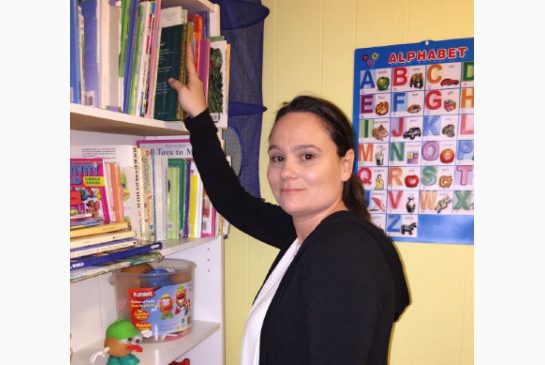 Home daycare operator Tammy Larabie called the CAS because she was concerned about one of the children in her care. After they were cleared by the CAS, they sued Larabie for emotional suffering.Tracy Augot
Home daycare operator Tammy Larabie called the CAS because she was concerned about one of the children in her care. After they were cleared by the CAS, they sued Larabie for emotional suffering.Tracy AugotA North York home daycare operator who called the Children’s Aid Society because she was concerned about a baby in her care has been ordered to pay the child’s parents more than $13,000 for the “emotional pain and suffering” that her report caused.
It’s a ruling which children’s advocates say ignores child care providers’ duty to report suspected child abuse or neglect to the CAS, and it could dissuade them from doing so for fear of a lawsuit.
“It’s hard enough to get people to report (to the CAS) and this will have a silencing effect,” said Mary Birdsell, executive director of Justice for Children and Youth. “The legislation is supposed to protect people from being sued if their report was reasonable.”
In a decision delivered last month, Superior Court judge Lewis Richardson ruled Tammy Larabie’s call to the CAS was “unreasonable” and there “was nothing to suggest that (the baby) was in any danger.”
In a court transcript obtained by the Star, Richardson found the parents “to be competent, caring and capable” who “properly looked after the interests of their son.”
“There was no basis whatsoever to report them to the Children’s Aid,” he said. “(Larabie) acted selfishly and to protect her own interest, not for the benefit of the child.”
Larabie’s lawyer disagreed and is considering an appeal.
“Her heart is very much in the right place,” said Ari Goldkind. “She doesn’t want anybody who has a concern about a child to hesitate for one second to pick up the phone (and call the CAS) because they’re worried they’ll get sued.”
“This is the very reason we have CAS,” he said. “These are the people trained, tasked and experienced in making sure a child is fine. Do we want to leave these decisions up to regular people?”
Christopher Cui and Iris Lee put their 10-month-old baby in a Larabie’s unlicensed home daycare in March 2013.
Larabie became concerned about the baby’s health because she felt he slept too much, wasn’t meeting developmental benchmarks and had lost weight, according to the transcript. She also felt the special diet of rice, fruit, vegetables and meat that Cui and Lee provided for their baby wasn’t nutritious enough.
But Richardson found these concerns were not shared by the child’s pediatrician.
“(Larabie) went on Google and formed her own medical opinion, which has not been substantiated and makes no sense,” he said.
Larabie called the CAS in July 2013, shortly after the high-profile death of 2-year-old Eva Ravikovich in a filthy and overcrowded unlicensed home daycare in Vaughan. In his ruling, Richardson felt that death had influenced Larabie, who “panicked and overreacted” owing to “the current public pressure on unlicensed daycares.”
The CAS launched an investigation and found her complaint unfounded.
“Larabie did not contact my clients with her concerns,” said Richard Brown, the lawyer for Cui and Lee. “She started a campaign to make them feel insecure and then went further and reported them to the CAS.”
Less than a week after the complaint, Cui and Lee found out it was Larabie who made the call and pulled their child out of daycare, Brown said.
Citing the contract they had signed, Larabie asked for two weeks of payment ($380) because they had withdrawn their child without any notice. When they refused to pay, she took them to small claims court.
Cui and Lee then countersued for the suffering they said Larabie’s call to the CAS had caused them, including a depression that had to be medicated during Lee’s second pregnancy.
“My clients did not do this for financial gain. It was a question of deterrence,” said Brown.
In dismissing Larabie’s claim (which grew to $735 with late fees, interest and penalties), and ordering her to pay damages to Cui and Lee, Richardson said the “unfounded complaint to the Children’s Aid Society created emotional distress.”
Even though the parents were cleared of any wrongdoing, “these complaints and investigations remain on record permanently,” the judge said.
Richardson ordered Larabie to pay the child’s parents $10,000 in damages and $3,175 in legal costs.
Larabie’s sister told the Star that stress caused by the ruling has forced her to shut down her daycare.
“She’s got laryngitis now and all she wanted to do was help,” said Tracy Augot, who started an online crowdfunding campaign to help her sister pay the damages.
Minister of Children and Youth Services Tracy MacCharles deferred to the judge’s ruling.
“This was a civil proceeding where the judge found there to be no reasonable grounds for the complaint. The judge heard both sides of the story and ruled in favour of the parents,” she said in a statement, adding “this case should not dissuade anyone from fulfilling their duty and reporting the abuse or mistreatment of any child.”
MacCharles’ spokesperson, Aly Vitunski, later added: “The law is clear. Every person, including an operator or employee of a child care nursery, who has reasonable grounds to suspect that a child is in need of protection, must report that suspicion promptly to a children’s aid society. It is not necessary for people to be certain a child is or may be in need of protection to make a report to a CAS.”
Asked about the case, Premier Kathleen Wynne said Wednesday that her office would look at the judgment.
“We want to make sure that the laws that are in place are the right balance to ensure that people report when they see that there’s abuse, and that they feel free to report, but that they understand what it is that they are looking at,” she told Global News.
Ontario Child Advocate Irwin Elman worries the decision will have a chilling effect on reports to the CAS.
“I wouldn’t want anyone to second guess their own judgment,” he said. “We all have a duty to report, not only professionals, but anyone in the province.”
Caroline Newton, communications director for the Ontario Association of Children’s Aid Societies, emphasized that public reporting is the backbone of the child welfare system.
“We can’t be everywhere. We totally rely on the public — especially professionals who work with children — to alert us to problems,” she said.
“The safety and well-being of children is paramount,” said Newton, who advised people with concerns to “make the call. You don’t have to be certain.”
Source: Toronto Star

Child Abuse is not Hereditary
March 28, 2015 permalink
When social workers fill out their forms to determine whether to take your children, one of the questions is: "Was the parent abused as a child?" A yes is several points toward child removal.
Now a serious scientific study casts doubt on the notion that parents who experienced physical abuse as children pass that abuse on to their own children. Many previous studies in this area were biased because they relied on data collected by child protection agencies. The bias arose because CPS pays more attention to families headed by parents abused as children.
The report itself is behind a paywall. Enclosed is the abstract from Science, the editor's summary and a technical review from Ars Technica.
expand
collapse
Report
Intergenerational transmission of child abuse and neglect: Real or detection bias?
Abstract
The literature has been contradictory regarding whether parents who were abused as children have a greater tendency to abuse their own children. A prospective 30-year follow-up study interviewed individuals with documented histories of childhood abuse and neglect and matched comparisons and a subset of their children. The study assessed maltreatment based on child protective service (CPS) agency records and reports by parents, nonparents, and offspring. The extent of the intergenerational transmission of abuse and neglect depended in large part on the source of the information used. Individuals with histories of childhood abuse and neglect have higher rates of being reported to CPS for child maltreatment but do not self-report more physical and sexual abuse than matched comparisons. Offspring of parents with histories of childhood abuse and neglect are more likely to report sexual abuse and neglect and that CPS was concerned about them at some point in their lives. The strongest evidence for the intergenerational transmission of maltreatment indicates that offspring are at risk for childhood neglect and sexual abuse, but detection or surveillance bias may account for the greater likelihood of CPS reports.
Editor's Summary
Abuse from generation to generation?
Parents who were abused as children are thought more likely to abuse their own children. Widom et al. compared reports from parents, from children, and from child protective service agency records gathered on the same families and on matched controls. They observed different findings depending on which information they used. Increases in sexual abuse and neglect relative to controls were reported by children of abuse victims. However, much of the believed transmission of abuse and neglect between generations could be ascribed to surveillance or detection bias targeted at parents with childhood histories of abuse or neglect.
Source: American Association for the Advancement of Science
Childhood abuse victims don’t always grow up to be abusers
Families with abuse histories might be more scrutinized by social services.
It’s a widely held belief that people who were abused as children are more likely to grow up to abuse their own children, but a new study in Science suggests a more complex picture. Different kinds of abuse and neglect have different patterns of intergenerational transmission, and there’s reason to think that certain families are scrutinized more than others, leading to biased reporting.
The widespread belief in intergenerational transmission is not completely unfounded. A number of studies have found evidence that abuse victims are more likely to abuse, but the overall picture is mixed: many other studies have found no such link. Understanding what causes child abuse is obviously vital to finding solutions, so it’s an essential question for researchers to resolve.
Part of the problem is that this is an incredibly difficult subject to study. Asking people to self-report their experience of abuse as children, or their tendency to abuse as adults, will obviously produce answers rife with inaccuracies. On the other hand, not all instances of abuse are reported officially and not all reported abuses have sufficient evidence to result in criminal charges.
A team of researchers at John Jay College of Criminal Justice constructed a new study design that tried to work around some of the main problems with obtaining data on child abuse. Previous research had used cross-sectional research, finding abusive parents and interviewing them about their childhood experiences. This means that people who were abused as children but who didn’t grow up to be abusers aren’t accounted for in the research. Past studies have also focused on physical abuse, ignoring sexual abuse and neglect.
To get around this problem, the John Jay researchers opted for a longitudinal study, identifying children who, based on official records, were known to have been abused or neglected between 1967 and 1971. They also identified a comparison group of children with no documented abuse or neglect cases, but who were from the same region and matched for age, sex, race, and social class.
Of course, there’s no guarantee that the children in the control group hadn’t also been abused or neglected without official reporting, but the controls do help to ensure that other social factors aren’t affecting the results.
The researchers first interviewed the study participants between 1989 and 1995 when they were around 29 years old. At this stage, there were 1,196 participants all together, although a number left the study before its conclusion. Analyses of those who dropped out indicate that there’s no reason to think that there were differences in abuse rates between those who stayed and those who left.
Follow-up interviews were conducted in 2009 and 2010, when participants were around 47 years old. The children of the participants—now young adults, 22 years old on average—were also interviewed at the same time. Finally, results were compared with reports from Child Protective Services (CPS).
They found that adults who had records of abuse or neglect as children were twice as likely to have been reported to CPS because of child maltreatment. Overall, approximately 21.4 percent of these adults had been reported, compared to 11.7 percent of those in the comparison group. Rates of reporting for sexual abuse and neglect were significantly higher, but reports of physical abuse were similar. This is a really important finding, because previous research and common assumptions have focused on physical abuse.
The second part of the study focused on self-reports. Parents in the abused group were no more likely to self-report behaviors that are considered abusive than control parents, but they were more likely to admit neglectful behaviors. But, write the authors, there’s reason to be skeptical of abusive parents’ willingness to report on their own behavior, so these reports might fall short of the truth.
The reports from the participants’ children portrayed a different picture. The children of parents who were abused were more likely to report sexual abuse and neglect than the children of parents with no abuse history, but no more likely to report physical abuse. This result matches with the data from CPS reports.
Finally, the researchers compared the self-reports of abuse with the rates of reporting to CPS, and they found something unexpected: CPS knew about more of the abuse and neglect cases in the abused group than they did in the control group. In fact, they knew about approximately 30 percent of the self-reported cases in the abused group and only 15 percent of cases in the control group.
The implication, the researchers suggest, is a surveillance bias toward families already involved with CPS. If CPS knows that there’s a history of abuse in a family, they watch them more closely and are more likely to know about ongoing abuse cases. This means that detection of intergenerational transmission of abuse based only on CPS records could be substantially skewed.
The researchers emphasize that there are weaknesses in this study despite its stronger design, and there’s a lot more work to be done. Apart from the obvious difficulties in obtaining complete and accurate reports of abuse, the families in this study were predominantly poverty-stricken, which means there’s an obvious confound with socioeconomic status. The results might not generalize to all socioeconomic groups.
What the results do suggest, though, is that CPS might be missing cases of abuse by focusing too much on families with a known abuse history. That’s an important avenue for future research to explore.
Source: Ars Technica
Rosie O’Donnell Stole My Baby
March 28, 2015 permalink
Celebrity Rosie O’Donnell started mothering in 1995 when she adopted a boy. Later she adopted Chelsea Belle O'Donnell, born in 1997, shared with her then same-sex partner Kelli Carpenter. For two decades she has given advice to parents, citing her own experiences as a mother. Her family life includes five children (none that she gave birth to), two same-sex divorces and one child repossessed because Florida did not allow same-sex foster parents.
Now Deanna Micoley, the real mother of Chelsea, has come forward. She says she was drugged by her ex, then compelled to sign a document relinquishing her baby that she called Kayla. Direct quote: "Rosie O’Donnell stole my baby." In direct communication with her real mother, Chelsea revealed that she despises bombastic Rosie.
In defense publicist Cindi Berger says Rosie “legally adopted” Chelsea from the non-profit Children of the World in New Jersey. In the days when celebrities were criticized for wearing fur coats, some defended themselves with: "I did not kill the animal, it was already dead when I bought it." Sorry, the purchase price paid for the killing of the animal. And Rosie's adoption fees paid for the forced separation of baby Kayla/Chelsea from her mother.
Here is an image of Deanna's letter to Rosie. Fixcas could not download the video of the interview, but Inside edition copied much of it to YouTube and local copy (mp4).
expand
collapse
WORLD EXCLUSIVE! ‘ROSIE O'DONNELL STOLE MY BABY!’ ADOPTION SCANDAL
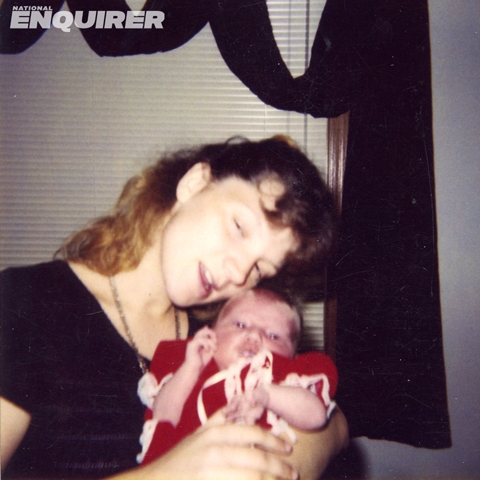
Fresh from the scandals of her controversial exit from television’s “The View” and the sudden demise of her second same-sex marriage, Rosie O’Donnell has been plunged into an adoption scandal, The National ENQUIRER can reveal.
The biological mother of Rosie’s 17-year-old adopted daughter, Chelsea, has unmasked herself to the world to sensationally claim she was drugged up by her then-husband on heroin and forced to give up their child!
“I believe Rosie O’Donnell knew that I was in no condition to sign away my parental rights to my daughter!” Deanna Micoley, 37, told The ENQUIRER in a blockbuster exclusive interview.
“She did the worst thing one woman can do to another woman – take her child!”
Deanna was unhappily married and just 20 years old when, in Aug. 1997, she gave birth to a baby girl who she named Kayla. Two months later, her now ex-husband – whose name is being withheld by The ENQUIRER – forced her to give up their child to an adoption agency, it’s alleged.
“I may not have been the best mother back then. I did drugs and I have a criminal record because of it,” Deanna admitted.
“But I surely didn’t deserve to have my baby stolen from me!”
Deanna said she never knew 53-year-old Rosie had adopted her daughter until last November when Kayla – now known as Chelsea – contacted her father.
The married stay-at-home mom of four, who lives in Wisconsin, told The ENQUIRER: “Rosie O’Donnell stole my baby, but I don’t want her money. I just want my daughter back!
“Chelsea told him that she was his granddaughter. He called me and broke the news. It was the moment I’d been waiting and praying for the last 17 years – I’d found my precious daughter!”
Since then, Deanna and Chelsea have communicated through Facebook and text messages, during which her daughter revealed to her birth mom that she despises bombastic Rosie!
“Chelsea has told me that she had issues with Rosie,” Deanna said.
“I believe Rosie has abandoned her. Since about the age of 12, Rosie’s basically shipped Chelsea off to different boarding schools.”
When Chelsea quizzed Deanna as to why she’d been placed for adoption, Deanna said: “I told her the truth – that her daddy wasn’t a good person and she was basically given up to an adoption agency.”
According to Deanna, Rosie has also tried to turn her own child against her – something she claimed is supported via a series of explosive text messages.
In one text missive, obtained by The ENQUIRER, Rosie wrote to Deanna: “One thing I want to share – Chelsea has often been overlooked in some ways because my fame makes me seem superhuman.”
Said Deanna: “Rosie wants to paint me as a horrible person and says adopting Chelsea saved her from a life of misery.
“Rosie even hired someone to dig up my criminal record and gave it to Chelsea.
“But bless her heart, Chelsea told me the past was the past, and she loves me!”
Rosie is an outspoken advocate of adoption, and adopted son Parker in 1995 as a single mom. She adopted Chelsea in Nov. 1997, and then, with partner Kelli Carpenter, adopted son Blake in Dec. 1999.
Kelli gave birth to their daughter, Vivienne, through artificial insemination in Nov. 2002. The couple wed in California in 2004, and split in 2007.
Rosie adopted her fifth child, 2-year-old daughter Dakota, in 2013 with her second wife, Michelle Rounds.
But the pair split after little more than two years of marriage, with the end coinciding with the opinionated star’s decision to quit “The View” – just four months after rejoining the cast.
ROSIE’s RESPONSE:
Rosie O’Donnell’s publicist attacked Deanna Micoley for speaking out publicly about her biological daughter, and insisted Rosie’s adoption of the 17-year-old was totally above board.
According to Cindi Berger, Rosie “legally adopted” Chelsea from the non-profit Children of the World in New Jersey.
“The agency never would have accepted the baby if the birth mother was under the influence,” Berger told The National ENQUIRER.
“There are notarized adoption papers signed by the birth mother and father that were accepted by both the adoption agency and the Court.”
Rosie is “unbearably proud” of Chelsea, Berger added, and “has encouraged and supported Chelsea’s desire to communicate with her birth mother. How disappointing that Chelsea’s birth mother would go public with this personal story without ever having met Rosie.”
Source: National Enquirer
Social Worker Sex with Teen Wards
March 27, 2015 permalink
In foster care the foster parents have custody while the social worker has the power. California social worker Manuel Sedillo took advantage of his power to have sexual relations with three teenaged girls under his control.
expand
collapse
Social worker pleads not guilty to sexual assaults
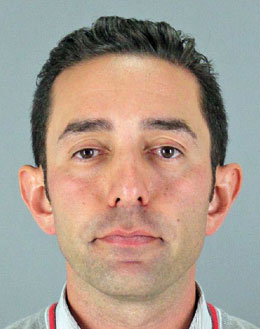 Manuel Sedillo
Manuel SedilloA former San Mateo County social worker pleaded not guilty Friday to 30 counts of having sexual relations with three underage girls who were under his supervision.
Manuel Sedillo, a 38-year-old Santa Clara man with a wife and child, was arraigned in San Mateo County Superior Court and scheduled to face a jury July 20, according to the District Attorney’s Office.
Sedillo was working for the county’s Human Services Agency when he allegedly assaulted three 16-year-old East Palo Alto girls who were on his caseload, according to the District Attorney’s Office.
The charges against him include unlawful sexual intercourse, oral copulation and sexual penetration with a minor.
Sedillo was assigned to the family of the first reported victim in 2011 and became very friendly with her before beginning a sexual relationship between June 21, 2014, and July 31, 2014. Sedillo reportedly had sexual relations with her at several motels, a San Mateo County beach and the Child Protective Services office in East Palo Alto, according to the District Attorney’s Office.
The second victim reported Sedillo, who was like a father to her, took her to an upscale San Jose hotel where they had sexual encounters, according to the District Attorney’s Office.
Since Sedillo’s arrest last October, a third victim came forward alleging he sexually assaulted her in his personal and county-provided cars, according to the District Attorney’s Office.
The third victim, now 21, was 16 and 17 years old at the time she was assaulted by Sedillo, said Chief Deputy District Attorney Karen Guidotti.
“Anybody that preys on young girls or young people are committing despicable acts and to have a person who is in a position of authority who is supposedly there to help these girls, and yet betrays them like this, it’s really unthinkable. It’s hard to imagine the kind of damage that is done to these young women when they can’t trust a person who’s supposed to be helping them,” Guidotti said.
Sedillo began working for the county’s Human Services Agency in 2006, and was placed on administrative leave in July after the first girl came forward. He ultimately resigned from the Children and Family Services Department just before he was arrested in October.
A pretrial conference has been scheduled for June 15 and Sedillo is currently out on $600,000 bail. A call to his attorney was not returned.
Source: San Mateo Daily Journal

London CAS Cutback
March 27, 2015 permalink
London CAS has complained about budget cuts, and the press has obliged with a sympathetic article. Of course, from the point of view of families, the theee million dollar budget cut is an improvement.
expand
collapse
Kids lose in cutbacks at Children’s Aid Society of London and Middlesex
Programs that help kids traumatized by sexual abuse and domestic violence, and that help families buy groceries, are being axed at the London area’s deficit-plagued child welfare agency as its high-priced former director remains on medical leave.
Eight programs that benefit kids and families are being cut, scaled back or thrust under review, fallout of government funding cuts to the Children’s Aid Society of London and Middlesex, whose bloated management and questionable spending came under blistering review in a provincial report obtained by The Free Press.
Now, as it tries to whip its books into shape, absorbing 2% annual funding cuts imposed by the province until it’s back in black, the agency that protects vulnerable children has to shed or reduce programs that include one to teach parenting skills and another to help older kids transition to adults.
Even home visits — parents seeing their kids in the agency’s care — haven’t escaped the blood-letting, with not enough staff to hold them in the home. Instead, some have been done in the organization’s lobby.
With its staff and services being slashed as the CAS is forced to get by on $3 million less, its union is crying foul and one critic calls the government’s move “shameful.”
“More than $2 million has been cut from our budget in two years. How can we operate like that? We cannot guarantee safety of children,” said Karen Cudmore, president of the Ontario Public Service Employees Union, Local 116, which represents agency workers.
MPP Monique Taylor, NDP critic at Queen’s Park for family and children’s services, said the government has gone too far from cutting cheques for the agency’s over-spending to forcing severe budget cuts.
“It is shameful when the government can spend money where it chooses, but vulnerable children take the cut,” she said. “It is impossible for these agencies to fix their budgets overnight.”
To balance its budget, bringing it down to $61.3 million from $64.3 million, the agency — besides slashing programs — has frozen executive pay and cut management and union staff by 39 positions.
Former director Jane Fitzgerald, once Ontario’s highest-paid child-welfare agency boss, remains on a paid medical leave of absence.
A scathing provincial financial review, obtained by The Free Press after a freedom-of-information request, found the CAS top-heavy and wasteful. Bottled up for months, the review revealed the agency spent hundreds of thousands of dollars on renovations to its leased office and consultants, ran far-above-average costs on managing cases, and had more executives who were paid more than $100,000 than did other child-welfare agencies.
While it was in the red, the agency spent $300,000 on renovations, $174,000 on consultants, $50,000 on taxis — including $3,535 for one client — and $19,600 to buy 23 iPad tablet computers.
While cuts to the CAS are broad and deep, eliminating counselling programs to children and parents affected by violence and abuse are the greatest concern, said Cudmore.
The agency says it’s trying to work with the community to pick up the pieces, but that’s raising eyebrows. The CAS will have trouble finding community partners, since they weren’t consulted and won’t pick up the workload without input, said Kate Wiggins of the Women’s Community House shelter for abused women.
“It is outrageous that they have dismantled the domestic violence team,” she said. “These decisions are being made by big agencies in a vacuum, without input from community partners. The children lose, victims lose.”
But the CAS is trying to work with community agencies, said its acting director, Regina Bell.
“We are trying to develop a community consortium around it, but it is not off the ground yet,” she said of help for victims of sexual abuse and domestic violence.
“It will take time. We have to look to the community for solutions.”
In its 25-page review of the CAS, the Ministry of Children and Youth Services made 37 recommendations to improve finances.
Counselling programs aren’t part of the agency’s core service.
Bell said the CAS is working with private counsellors, Western University and police to help sexual abuse and domestic violence victims. She said other youth agencies, such as Childreach and Merrymount, are being contacted to see if other needs can be met.
“I wish we had funds to sustain it, but we can be part of a solution through community services that do exist,” said Bell.
CAS BUDGET NUMBERS
2013-14 budget: $64.3 million
Projected 2016-17: $61.3 million
Bottom line: $3 million cut in three years
PROGRAMS CUT OR REDUCED
- Sexual abuse: Counselling for kids and adults
- Domestic violence: Counselling for child witnesses and adult victims.
- Child therapy: For kids who can’t get community counselling.
- Adulthood: Helping older kids prepare for independence, finding apartments and managing budgets, etc.
- Family visits: Not enough staff to hold parental visits in homes. Some funding restored by province.
- Family support: Helping parents with child care, parenting techniques, getting kids ready for school.
- Education: Working with schools to help help develop programs for children in agency’s care.
- Health clinic: Under review, a doctor and nurses offer direct service to children in care
- Vouchers: To help buy needy families food, diapers, baby formula, etc
Source: London Free Press
Mothers of Makayla Sault and JJ Speak
March 27, 2015 permalink
Last year Makayla Sault and a girl known only as JJ were permitted to skip chemo therapy for cancer. Makayla has since died. The mothers of both girls presented their views to oncologists and the press. According to mother Sonya Sault, Makayla's prospects were not good, even with chemo.
Sonya Sault said her daughter Makayla’s experience at McMaster Children’s Hospital was traumatizing. “Every time Makayla approached the hospital her body began shaking,” she said. “She never got over the fear she experienced when she heard her parents threatened with jail and she and her brothers threatened with apprehension.”
expand
collapse
Doctors at McMaster warned using CAS against indigenous families a “horrific” repeat of historical trauma
A hall full of Oncologists and national press gathered to hear the parents of Makayla Sault and the mother of J.J. speak at McMaster University.
Both families were invited to read prepared statements as part of a community panel addressing the prejudice they recently faced in the healthcare system and media – and why indigenous people continue to have traumatic experiences in the healthcare system.
Sonya Sault said her daughter Makayla’s experience at McMaster Children’s Hospital was traumatizing. “Every time Makayla approached the hospital her body began shaking,” she said. “She never got over the fear she experienced when she heard her parents threatened with jail and she and her brothers threatened with apprehension.”
J.J.’s mother read a written statement and clarified that she will be willing to share her story once the March 13th deadline for appeal to her case has passed.
“I have met with provincial government representatives who have been respectful and compassionate,” she said. “The issue is not whether traditional medicine will be respected but how it will be respected. And how and when the two systems can work together.”
Makayla’s mother Sonya Sault read an emotional written statement about their experiences at McMaster Children’s Hospital.
She also sought to correct inaccuracies reported about the child across national media.
Sault clarified that after Makayla’s diagnosis of Acute Lymphoblastic Leukemia with a positive Philadelphia Chromosome the child was given a 72% survival rate – if she made it through the five or more years of chemotherapy.
“Not 90%, not 95% – 72%,” she read. “We also learned from doctors at McMaster that chemotherapy is less effective and more punishing for indigenous children. The reasons for this are ‘not well understood’ we were told. In other words – [Makayla] had a 1 in 3 chance of dying from leukemia with the chemotherapy.”
They also bravely confronted the erroneous media reports and opinions their family has been subject to following the child’s case making world news headlines over the last year. She said, “The controversy, attention and inaccurate reporting have caused our family so much distress we have not been able to truly mourn Makayla.”
Sault addressed media criticisms of her choice to travel to the Hippocrates Health Institute, saying it was upsetting to see her private family vacation exploited by the members of the press.
Dr. Dawn Martin Hill, Associate Professor of Indigenous Studies at McMaster University, spoke about how prejudices about indigenous people latent in the foundations of the healthcare system and mainstream media create great psychological distress for indigenous people across Canada.
A newspaper article from a large Canadian newspaper was quoted which criticized the choice both families made to travel to the Hippocrates Health Institute in Florida. Martin-Hill addressed the truth of the matter in its proper context.
“Neither family went to Florida seeking alternative medicine,” she said. “They fled Canada: fleeing threats of apprehension, incarceration and hostile acts of aggression. In the US they found peace. Think about that. A safe place. That is all. Hope we cleared that up. They did not go there for any other reason than to get away from what was going on here.”
Martin-Hill said that in all of Canada’s reconciliation with First Nations people, the healthcare community has never been a part of those discussions. “The healthcare industry has not only never acknowledged there is a problem, they refuse to discuss any role they may have played in the unethical practices towards First Nations,” said Martin-Hill.
“Collaboration not coercion,” Martin-Hill said. “Using CAS or courts to apprehend First Nations children is loaded with horrific unjust actions Canadian institutions have exacted on First Nations people opening up deep wounds of historical trauma.”
Martin-Hill again invited the McMaster Children’s Hospital and Hamilton Health Sciences to work with the McMaster Indigenous Studies department to collaborate and ensure that staff are aware of the historical traumas enacted upon First Nations people by the healthcare system so staff are better able to treat indigenous patients effectively.
“I am aware there are many good doctors here at McMaster. We need your support. We need you to stand up and work with us. I know you are here,” said Martin-Hill. “We need integrative policies and practices so that J.J. does not have to be in a hostile environment.”
Source: Two Row Times
Useless Investigations
March 27, 2015 permalink
Christopher Booker explains why official investigations into child protection do not, and can not, find the real problems. Using a recent report by Michael Wilshaw as the example, the investigators all earn a living from the protection system. The victims, parents and children, are not consulted.
expand
collapse
These 'carers’ just don’t care...
Christopher Booker examines the abuse of children in care
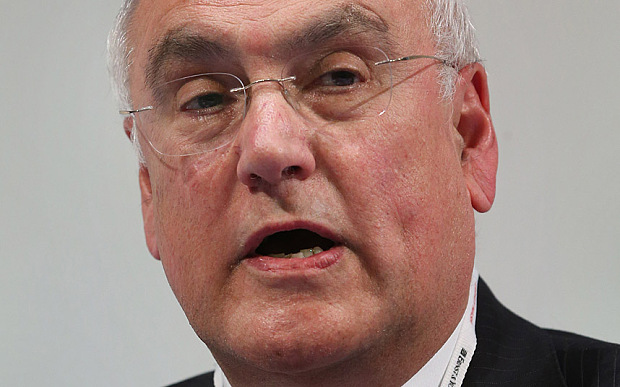 Sir Michael Wilshaw, Ofsted Chief InspectorPhoto: Peter Macdiarmid/Getty Images
Sir Michael Wilshaw, Ofsted Chief InspectorPhoto: Peter Macdiarmid/Getty ImagesStill they come, those official reports on the grotesque failings of our “child protection” system. Last week we had another on the failure of Greater Manchester police to heed all the warnings they were given about the abuse of children in “care” in Rochdale (for which no senior officers were asked to resign). From the coverage given to the more wide-ranging inquiry into the workings of our child care system by Sir Michael Wilshaw, Her Majesty's Chief Inspector of Children’s Services, it might have seemed that this was yet another critical report, as it highlighted Ofsted’s findings that more than three quarters of the local authority children’s services departments it inspected were either “inadequate” (its lowest rating) or “requiring improvement”.
But a clue as to why the report itself then seemed so strangely thin lay in those Sir Michael consulted for his report. These ranged from local authorities themselves to the adoption and fostering agencies which preside, very profitably, over the record numbers of children now being taken into “care”, at an annual cost of £3.7 billion. Every one of these bodies was part of the official system itself. Sir Michael doesn’t seem to have spoken to any of the system’s critics, let alone to any of those grieving parents or children suffering in “care” who feel that it has horribly betrayed them.
Unsurprisingly, when Ofsted’s director of social care was given a limp little interview by John Humphrys on the Today programme, her only message was that too many children “are not being taken into the care system when they need to be”. In fact, nothing is more disturbing about this system, as we saw in Rochdale and Rotherham, than the way, once children are taken into “care”, their cries for help when they are abused are ruthlessly ignored. Yet the slightest hint given by a teacher or doctor that a child might possibly have been “non-accidentally” injured by a parent can have social workers and police rushing round to remove the child into the very system where they may suffer genuine ill-treatment far worse than anything alleged against their parents. So this inhumane system rolls autistically on, determined to resist any real recognition of just how grievously it has gone off the rails.
Source: Telegraph (UK)
Social Worker Takes Boy from Complaining Mom, Moves in with Dad
March 27, 2015 permalink
The experience of Teresa Smith illustrates two abuses of child protection both commonly reported by families but rarely documented in the press. Smith was divorced and complained repeatedly to Ohio CPS about abuse of her son. The article does not say who she accused, but the ex-spouse is the common target. This is the pattern fixcas calls a divorce continuation. CPS took the standard action, they cut off the complaining parent, Smith, from the child entirely, placing him with the father. Then the social worker in the case got romantically involved with the father. Another abuse often reported parents, but rarely by the press, conflict of interest.
expand
collapse
Parent blasts actions by caseworker
A Findlay woman on Thursday told the Hancock County commissioners that the county Children’s Protective Services agency is guilty of “illegal and unethical behavior.”
Children’s Protective Services investigates reports of alleged child abuse and neglect in Hancock County.
Teresa Smith told the commissioners that in 2012, she became the focus of an agency investigation after she made repeated attempts to force the agency to investigate alleged abuse of her child.
In what she described as an act of retaliation, she said the agency temporarily removed the child from her home. Smith said the caseworker assigned to her case then began dating the biological father of her child.
Smith said within 90 days, the caseworker “rewrote the case plan, changing custody from myself to my son’s biological father, whom he had not known since birth.”
Smith said the caseworker no longer works for the county agency and is now living with the boy’s father and raising the boy.
“What happened to me was wrong, immoral and unethical,” Smith said. “I hope that by speaking to you today that you will recognize that changes need to be made at children’s services, because none of our children are safe until you do.”
Susan Pneuman, owner and executive director of The Center for Autism & Dyslexia, 7430 Timberstone Drive, said Smith’s story is “not the exception,” and accused the commissioners’ office of ignoring problems with the Children’s Protective Services agency.
“Mr. (Phillip) Riegle, you are very aware that I had contacted you just about a year ago about my concerns about a child repeatedly being cared for by convicted sex offenders,” Pneuman said. “You are also aware I was harassed by a caseworker for contacting you.”
Pneuman said she was “sickened” by Smith’s story.
“The caseworker’s behavior this mother describes is immoral and is embedded in the very culture of the Hancock County CPS (Children’s Protective Services),” she said.
Following Thursday’s meeting, Riegle said Diana Hoover, director of Hancock Job and Family Services, which oversees Children’s Protective Services, will be made aware of the complaint.
“We’ll obviously have a discussion with Diana about continuing to hear these types of complaints,” Riegle said.
The commissioners’ office appoints the director of Job and Family Services, and provides money for foster care.
Hoover was named director of Job and Family Services in October after the retirement of Sheldon Bycynski. She had worked as assistant director since October 2013, and previously served as administrator of Children’s Protective Services.
Hoover could not be reached for comment Thursday.
Pneuman is a member of a newly-formed public/private task force that wants to work with Hancock County Children’s Protective Services on child abuse and neglect cases. So far, the agency has declined the task force’s offer, saying that role is already filled by the Hancock County Family First Council.
Established in 1993, Ohio Family and Children First is charged with streamlining and coordinating government services for children and families.
Commissioner Brian Robertson, who was recently appointed to the Family First Council to represent the county, said Pneuman has been asked to join the Family First Council. However, Pneuman disputed that on Thursday.
“Many of the leaders in our community have taken the time to meet over several months to discuss their concerns and hopes for improvement,” Pneuman said. “I do not believe ignoring this issue will make it go away. Children are being harmed and the culpability lies with the commissioners. Please do not wait for a catastrophe to occur to take action.”
Source: The Courier (Findlay Ohio)
Getting Away With Fake Transcripts
March 26, 2015 permalink
Litigants in family court have long been plagued with altered transcripts, altered in such a way as to remove many grounds for appeal. Now in addition to typed transcripts, parties can get an audio recording. The policy is on the Ontario Court website at Release of Digital Court Recordings. But the courts protect themselves from disclosure of their mistakes (or intentional alterations). Anyone applying for a transcript has to fill out the Undertaking to the Court for Access to Digital Court Recordings, downloadable from the Ontario Courts website or our local copy (doc). For readers who cannot read doc files, the applicant must agree to:
- I have read and understand s.136 of the Courts of Justice Act, R.S.O. 1990, c.C.43, including that every person who contravenes this section is guilty of an offence and on conviction is liable to a fine of not more than $25,000 or to imprisonment for a term of not more than six months, or to both.
- I will not publish, broadcast, reproduce or otherwise disseminate the digital recording, including any annotation in the audio file, in any way.
- I will not copy, save, upload or download the digital recording.
- I will not authorize, assist or permit anyone to publish, broadcast, reproduce or otherwise disseminate the digital recording, including any annotation in the digital recording, in any way.
- I will not provide the digital recording, or copies of same, in any format to any third party.
- If a witness exclusion order has been made in the proceeding, I will not disclose the contents of the digital recording to any prospective witness who has not given evidence.
- I acknowledge that any notes, transcription or similar document that I produce using the digital recording is not a court transcript or a court record, and I will not purport that it is a court transcript or a court record.
- When the digital recording is not being used for the purpose permitted by the undertaking, I will keep the digital recording in a secure place where it cannot be accessed by other persons.
- I will destroy the digital recording and render it inoperable when the purpose for which the digital recording was provided to me has concluded.
When there are significant differences between the audio and the transcript, victims ought to be able to expose the chicanery by posting both. But the contract in the application makes them subject to the wrath of the law for doing so.
There is an occasional victim who has nothing to lose. If you are such a person who has received altered transcripts, please send both versions to fixcas. For your convenience here is a link to contact information
Short People
March 25, 2015 permalink
Angela Borths, who is short herself, has lost three children to Oregon CPS because they are too short. Nobody could make up this story. Musical accompanyment is by Randy Newman (mp3).
expand
collapse
Medical Kidnap? Mother Loses 3 Children Because “Daughter is Too Short”
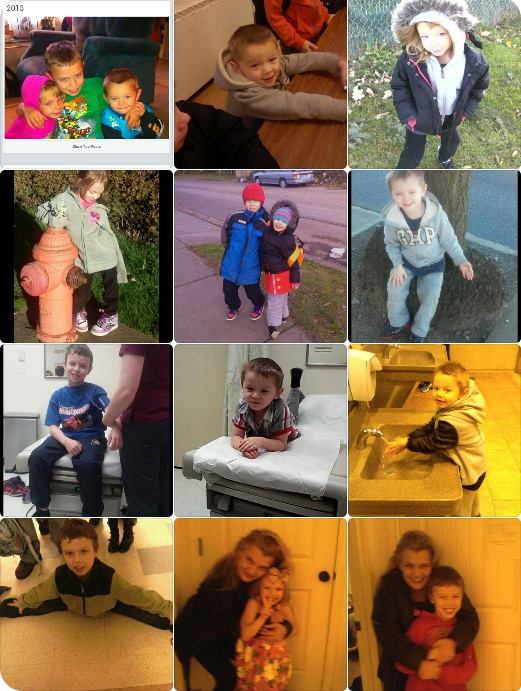 Borths children.
Borths children.It’s true – Angela Borths’ daughter is short. So is she – just under 5 feet tall. In fact, being short runs in the family. But that didn’t stop her pediatrician from allegedly reporting her to Child Protection Services (CPS.) The petite mother has now had her 3 youngest children taken by the state of Oregon on grounds of “medical neglect,” because her 6 year old daughter is short, and because she says she missed an appointment for her son when there was a 2 month lapse in their ObamaCare insurance.
The pediatrician allegedly calls Angela’s daughter’s short stature a “failure to thrive,” even though she is described by her mother as a happy, funny, creative, and really intelligent child in good health. She is anything but lethargic. Even though she is tiny, she is well-proportioned. According to an endocrinologist who has examined the child, her bone structure is “just right” for her size. The pediatrician’s report, however, appears to be the catalyst behind CPS getting involved in the Borths family this time.
Mother’s History as a Foster Child Makes Her a Target?
It isn’t the first time CPS has been involved with Angela Borths. Angela says she has never committed any crimes, has never done drugs, and doesn’t drink. But she does have one serious strike against her – she spent some of her own childhood in foster care. That, she says, makes her a target. She is certainly not the first person to report to Health Impact News that being in foster care as a child has put her in the crosshairs of CPS when raising her own children.
After she grew up and got out of the system, she determined to rise above her upbringing. Angela has a ready smile and bubbly laughter, born out of a tenacious dedication to overcome the obstacles that have come her way. She worked for several years as a surgical dental assistant, often working with very sick children. She later channeled her love for children into a career working with Scholastic book fairs. Her life is the classic American tale of an overcomer, refusing to let the events of the past destroy her present.
Blamed for Genetic Disease
However, she has remained under the shadow of Child Protective Services. Angela describes several events where CPS decided to get involved, even though there was never any evidence of wrongdoing on her part. When her first baby suddenly became very sick, she took him to the Emergency Room. He was later diagnosed with cystic fibrosis, a serious genetic disease, but that was not until after CPS stepped in and accused her of medical neglect. Even though cystic fibrosis is something that a parent cannot cause or stop, the charge of medical neglect was never purged from the records. She lost custody of her first child to his father, who then moved out of state.
Lead Paint in Grandma’s Old House
Years later, in 2012, Angela’s family was living with her mother in an older home. No one realized that lead paint had been used on the walls. When the children tested positive for lead in their system, the parents were accused of child abuse. Their lawyers allegedly told them “that all we had to do was sign a paper agreeing to allow CPS to offer us services (so it wasn’t an admission of guilt , so we were told).” They signed the papers, not realizing that this would give CPS grounds to keep the allegations of abuse in their system. After a short time, the case was closed.
Seizures, Missed School, and Sinus Medication Mishap
Near Christmas of 2013, Angela’s son, now 9, scared everyone in the household when he began having seizures. CPS again became involved. He was later diagnosed with a mild type of epilepsy which is typically outgrown by adulthood, known as benign rolandic seizures. The condition sometimes caused her son to be exhausted. It took some detective work to try to figure out what was going on, and he missed a good deal of school between trips to the pediatrician, neurologist, and the various tests, such as MRIs. It took a month for doctors to find a diagnosis.
Although the neurologist excused the time away from school, his pediatrician did not, insisting that he be in school and notifying CPS. During this time, Angela reports that she submitted to a drug test, knowing that she had nothing to hide. She had sinus issues going on at the time, and her own doctor had recommended sudafed and benadryl, not realizing that this combination could result in a false positive for methamphetamines.
Angela was horrified, and the children were taken from her, under charges of drug use and educational neglect. The pediatrician first brought up allegations of medical neglect at this time over her daughter’s short stature. It was not until after the appeal and 14 clean drug tests later, that she won back custody of her children. The drug charge was reversed in the appeal, but the short stature allegation remained substantiated in the CPS records.
Daughter Still Short, Triggering CPS Involvement
The children visited their pediatrician recently for a check-up, and Angela’s little girl remains little. She is in great health, but her doctor is concerned about her short stature, reporting it to CPS. According to Brenda Long, Angela’s mom:
Angela’s 18 year old son’s medical records read “short stature.” No one in the family knows any reason for their being short, but they know that it runs in the family. Blood tests have failed to show why they are short. Her daughter reportedly cried during a recent visit because she is taking it personally that she is short. Angela now finds herself facing accusations of medical neglect, that somehow she has done something to cause her child to be short.
Lapse in ObamaCare Insurance
When the ObamaCare website went live, the media was full of reports about the difficulties that people were having in signing up for their health insurance. Angela’s experience was no different. Over the Christmas holidays, she tried repeatedly to renew her insurance with the Oregon Health Plan. On several occasions, she was on hold for hours. On others, it was busy. It was not until February that she was able to get through the system and get renewed. During the time that her coverage had lapsed, she missed a neurologist appointment for her son. She did not, however, miss getting his seizure medication refilled. Instead, she paid out of pocket for his medication.
This lapse in coverage is allegedly included in the charges of medical neglect.
Judge “Rubber Stamps” Removal Order for All 3 Children
Angela’s former “drug problem,” which was allegedly based on a false positive, and found to be unsubstantiated in her previous appeal, is back in the petition to remove her children, according to Angela. She says her attorney has described the current petition as a “cut-and-paste” job of mostly previous allegations, accusations which were found to be unsubstantiated. However, the judge allegedly “rubber stamped” the charges, resulting in the removal of Angela’s youngest 3 children, ages 5, 6, and 9, from her home on March 3, 2015. The 18 year old is now an adult and thus is not subject to removal by CPS.
The social worker made the accusation that the children have too many absences from school. However, the records show that the majority of these are tardies, for which Angela is not responsible. She walks her children to school in the morning, where they eat the school breakfast. Because the kids are already in the school’s care, their mother has no control over when they arrive in the classroom after breakfast.
Angela says that she has records and documentation to prove, like before, that any and all allegations against her are false. Angela says she was stunned when the court took her children, because she says that there is no evidence of harm or risk of harm. But that didn’t stop her children from being taken from their home and their mother who loves them. Again, she is living every mom’s worst nightmare of having her children taken away.
Source: Medical Kidnap
DHS Director Jailed for Child Abuse
March 22, 2015 permalink
The director of Eaton County Michigan Department of Human Services (DHS) spent most of Friday in jail. Kenton Schulze has been charged with domestic violence. The incident was an attack on a teenaged boy who used to live with Schulze. A former foster child is a good guess.
expand
collapse
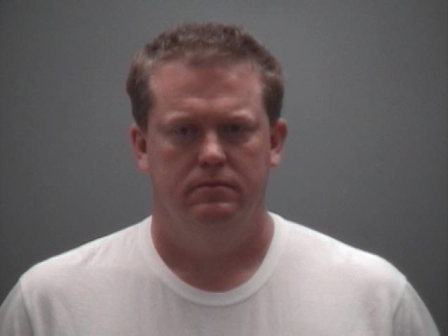
Eaton Co DHS Director Faces Domestic Violence Charge
The Director of Eaton County's Human Services Department spent most of Friday behind bars. Kenton Schulze, 45, is facing a domestic violence charge.
Schulze is charged with a misdemeanor for an assault or an assault and battery on a minor. At his arraignment in Eaton County District Court Schulze pleaded not guilty.
The Eaton County Sheriff's office says the incident happened Thursday night, while Schulze was at the home of a teenage boy who use to live with him. Since it's part of an ongoing case police aren't saying what led up to the assault.
Schulze could face 93 days in jail and/or a $500 fine.
Department of Human Services Spokesman Bob Wheaton told News 10 "DHS is aware of the situation and we're gathering information and facts. We take allegations like this seriously and we hold our leadership to very high standards."
Wheaton also says the department is reviewing what this means for Schulze's employment status, but stresses it's taking this very seriously.
Ingham County prosecutors filed the charge since there was a conflict of interest with Eaton County prosecutors because of Schulze's position.
Schulze is due back in court for his pre-trail on April 1st.
We're continuing to track this developing story.
Source: WSYM-TV Lansing

Shaken Science
March 21, 2015 permalink
The Washington Post has a long series on Shaken Baby Syndrome. Hundreds of cases have collapsed while thousands of convictions still stand. In spite of the change in scientific opinion, prosecutors continue to open new cases. Unfortunately, the web technology makes the article hard to read.
Addendum: Jackie Judd of PBS did a report on the same topic, YouTube and local copy (mp4) and transcript. The principal case is the death of Tristan, son of Andrew and Marielle Shortell in Maryland. The most revealing comment is at the end.
We asked MedStar Georgetown University Hospital and Maryland’s Child Protective Services to comment on this story. Both declined to appear.
After doing something wrong, the first step in healing is admitting the mistake. Social workers hold their clients to this standard. But social service agencies deny their mistakes even after their failures are revealed.
Keeping Secrets from the Police
March 20, 2015 permalink
Which is more important, protecting confidentiality or find a missing child? In New York, it is confidentiality. When Kenneth White was missing police could not look at his child protection file to help find the child. A legislator wants that changed.
expand
collapse
Lawmakers To Consider New Bill Being Pushed For Future Missing Children's Cases
An upstate sheriff and two New York legislators are announcing legislation that would force Child Protective Services to quickly turn over records when a child is missing.
Albany County Sheriff Craig Apple, Republican Senator George Amedore and Democratic Assemblymember Pat Fahy are backing a bill to expedite access to CPS records for missing children.
The impetus is one of the Capital Region’s worst crimes in recent memory. In December, 5-year-old Kenneth White was reported missing by his then-19-year-old cousin, Tiffany VanAlstyne, who was watching him at the time. She initially told police White had been kidnapped by masked intruders, who had burst through the door of the family's trailer at 994 Thacher Park Road in East Berne.
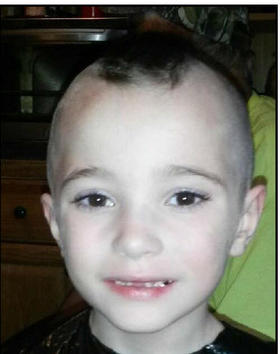 Kenneth WhiteCredit http://www.missingkids.com/poster/AMBER/11683/8304
Kenneth WhiteCredit http://www.missingkids.com/poster/AMBER/11683/8304When the Albany County Sheriff’s Office contacted CPS to request access to Kenneth’s records, they were denied. Tragically, White was found dead later that night and his cousin, who had originally reported him missing, was charged with his murder.
The incident struck a nerve with Sheriff Apple, apparent when he addressed the media day after the boy was found dead. "Certain cases stick with you your entire career, and this is one of those cases."
After a review of the case, it was determined that the records should have been turned over when requested. Apple has been pushing for changes to CPS laws. Assemblywoman Fahy: "When children are missing, minutes matter. And as we found during the tragedy of the Kenneth White murder, law enforcement was hindered in their investigation because of some confusion with current law regarding access to child protective records."
Senator Amedore says everything possible must be done to help law enforcement officials like Apple do their job. "...while at the same time being mindful of privacy issues surrounding CPS records. This legislation clarifies an existing statute and removes the questions of when its appropriate to release records to law enforcement during a criminal investigation."
Fahy adds that the new law would have a fail-safe mechanism. "...that would allow for a third-party administrative review should local government turn down that access to records. That third party administrative review would be by OCFS, the office of children and family services."
OCFS declined to comment on pending legislation. Amedore hopes the new bill can help save children in the future. "Unfortunately, this legislation would not have changed the outcome of this horrible tragedy with Kenneth White. But, it fixes serious flaws and ensures that law enforcement officials have access to the information they need during cases involving missing children, when every second counts."
Both the Senate and Assembly were expected to consider the measure Monday.
Source: WAMC Albany
Stacking Child Death Numbers in Alberta
March 20, 2015 permalink
In Alberta high-ranking child welfare officials subjectively classify child deaths before deciding which get investigated. It is the same method used in Texas to dramatically reduce the reported number of deaths in foster care.
expand
collapse
Leaked report calls for reviews of all child deaths in care
 Human Services Minister Heather Klimchuk: “I accept the principles within the recommendations, and now we’re going to need the time to consider the legislative changes.”Photograph by: Ed Kaiser , Edmonton Journal
Human Services Minister Heather Klimchuk: “I accept the principles within the recommendations, and now we’re going to need the time to consider the legislative changes.”Photograph by: Ed Kaiser , Edmonton JournalEDMONTON - High-ranking child welfare officials arbitrarily decide whether to investigate the deaths of children in care, without reasoned guidelines or oversight of any kind, according to an internal report obtained by the Journal.
The report says “all child deaths should be reviewed,” but the current process allows the director of children’s services to rule out in-depth internal investigations based solely on the limited information available immediately after a child dies.
“We are concerned the process gives the statutory director too much discretion,” implementation oversight committee (IOC) chair Tim Richter wrote in the report, dated Feb. 4. “There does not appear to be evidence-based criteria to support the director in deciding which cases warrant detailed investigation, and which warrant a scaled-down review.”
Richter said Sunday the committee “felt strongly” that the ministry should establish objective, evidence-based criteria to guide internal child death investigations. For example, it may not be necessary to conduct an internal investigation when a child dies from a fatal chromosomal disorder, but any death from a preventable illness may require review.
The eight independent committee members also recommended the province expand internal investigations to include the child’s contact with other Alberta ministries, and reiterated its call for a multi-disciplinary child death review committee overseen by Alberta’s medical examiner.
Fatal Care: Read the Journal's' award winning series
Finally, the committee recommended increased independence for the arm’s-length Council for Quality Assurance (CQA), a group of external experts who work internally with the department to improve Alberta’s child intervention system.
“They should be the governors of the (internal investigation) process,” Richter said. “If, for example, the CQA didn’t feel an internal review probed deep enough, they could send it back.
“This would help build the internal culture of inquiry that is so important.”
In November, Human Services Minister Heather Klimchuk asked the committee to make recommendations concerning the over-representation of aboriginal children in provincial care. In 2013, aboriginal children accounted for 69 per cent of the children in care in Alberta.
In part, the committee recommended the province create special programs to target urban aboriginal families, indicating the goal should be to reduce poverty, provide affordable housing and addiction treatment, address domestic violence, increase employment and boost educational achievement.
“There is solid research to suggest that culturally appropriate services ... will ... reduce the numbers of children in care,” the report says.
Klimchuk noted the committee “validated a lot of the good work we are doing,” highlighting in particular the eight-per cent reduction in the number of aboriginal children in care over two years ending 2013.
“I accept the principles within the recommendations, and now we’re going to need the time to consider the legislative changes,” Klimchuk said.
Asked to elaborate, she listed the numerous agencies currently involved in Alberta’s system to review child deaths. “When I look at the complex system we have in place, what do we do ... to make it more straightforward, in terms of getting the bottom (of these deaths), and learning from these terrible tragedies?”
Concerning the discretion of the director in the investigation process, she said: “I would never second-guess their efforts and integrity,” and added that her goal is to “make sure the system is robust and does what it needs to do.
“My commitment as minister is to ... ensure we continue to have the most transparent system in the country,” she said. “We’ve come a long way here in Alberta. It’s not a perfect system, but ... we’re going to get there.
“It means having these brave discussions, and that’s something I’m very much prepared to do.”
The IOC was established in 2014 after the Edmonton Journal-Calgary Herald award-winning Fatal Care investigation revealed hundreds more children had died in the province’s care than it had publicly admitted.
Source: Edmonton Journal
Foster Homes Closed
March 20, 2015 permalink
The CBC has found that two foster homes in the Moncton area have been closed for 'Abuse/Neglect of Client' during 2013-2014. When CAS takes children from their parents, they frequently give horrifying details such as drug abuse or a filthy home. But when their own foster homes are at fault, CAS withholds all details. They even keep the provincial child advocate in the dark.
expand
collapse
CBC Investigates
Children abused/neglected in 2 Moncton-area foster homes
2 foster care homes in Moncton region shut down for 'Abuse/Neglect of Client' between 2013-2014
Foster children in the Moncton area have been abused or neglected at the hands of those tasked by the provincial government to care for them, CBC News has learned.
Two foster homes were shut down in the last two years for “Abuse/Neglect of Client," according to the Department of Social Development.
The department is refusing to say anything more about the cases, including how many children were affected, the nature of the offences or whether police were called in for a criminal investigation.
Norm Bossé, the province's child and youth advocate, learned of the closures through CBC News.
“We can't allow mistreatment in foster homes. We simply can't allow it," he said.
“It's not acceptable to me as the child and youth advocate and this office, or I think anybody else, to say ‘well, we'll place you in a place that's better than where you were, but not completely safe.’” said Bossé.
“That shouldn't happen today.”
The provincial department told CBC News that the Child and Family Services Act prohibits the department from saying anything about the cases.
“The province takes the safety and security of children extremely seriously. It is the foremost concern of the department. In all cases where we get reports of abuse or neglect we will deal with those appropriately and take whatever actions are absolutely necessary to protect those children from future harm and neglect," said Bill Innes, the director of child and youth services.
Innes said the department will call in police on a case-by-case basis. He said in the case of a home being closed for abuse or neglect, "it would depend on the individual circumstances of the situation."
Innes added that the provincial government implemented a new, comprehensive screening program in April 2014.
He said that of the average 460 to 500 homes operating at any time, he thinks "the vast majority are loving, caring homes."
Embarrassed and ashamed
Zoe Bourgeois, who is a former client of the province’s foster-care system, said she was not surprised that abuse or neglect had occurred.
The 22-year-old woman, who is currently studying social work as a second degree, said it’s unacceptable that the province has not revealed how this came to happen.
“It comes probably down to one main thing: they’re embarrassed and they’re ashamed of what they did to the child. They placed this child in a just as terrible home as they removed the child from. And so the fact that it didn’t work out and that these terrible things happened in a foster home, reflects on Social Development,” said Bourgeois.
“Of course they’re not going to take that into consideration and express this to the media because they don’t want people thinking they’re removing children and placing them in more damaging homes,” she said.
Bossé said he will be seeking answers.
“The public, as far as I'm concerned, is entitled to know whether or not our foster care homes in the province are safe. And for the most part, to my knowledge, 99 per cent of them are safe. And these folks are doing a tremendous job,” he said.
“We definitely will be asking questions of the department on these, absolutely.”
Auditor General Kim MacPherson released a report on foster care in the province in 2013.
Her audit found that the department had not done criminal background checks on all foster parents and that in some cases, files were missing records to show homes had met all standards for approval.
MacPherson made 11 recommendations overall. A follow-up report on how many recommendations have been implemented is expected in December.
CBC News has requested an interview with Social Development Minister Cathy Rogers. Her office has not responded.
Source: CBC
Indoctrinating YMCA Staff
March 20, 2015 permalink
Staff at an Ontario YMCA have to keep up with current doctrines of child protecton. One volunteer reports to Lenore Skenazy.
expand
collapse
Dear Free-Range Kids: I’ve been attending our local YMCA for longer than I can remember (beginning with parent-and-child swimming lessons, I’m told), and volunteering there off and on since I was twelve. So I’ve been involved there longer than the people who are currently in charge, and most of the people who work there have known me for years.
In 2013, they introduced a mandatory Child Protection course for ALL staff and volunteers over the age of sixteen, even those who don’t actually work with children. Fine, a bit much, but it’s a family facility, and the Child Protection course only takes about an hour (the first incarnation was in person, but after that, it was online).
Then, with the introduction of the Child Protection course, they also insisted that we get Police Record and Vulnerable Sector Checks done every six months, when the standard rule is that these are good for a year.
In addition to that, they instituted a rule whereby everyone over 16 has to show I.D. to enter the YMCA. Okay, that’s also a bit over the top, but they don’t really enforce it with people they know.
But this year, they upped the ante again, Here are the new requirements:
- Take an online Child Protection Course (about 60 minutes to take)
- Take an online AODA (Accessibility for Ontarians with Disabilities Act) course (about 30 minutes)
- Take an online course about Bill 168, which is about workplace harassment (about 30 minutes)
- Take an online WHMIS [Workplace Hazardous Materials Information Systems] course (about 60 minutes)
- Provide the contact information of three references who’ve known us for at least a year, aren’t family members, are over 18 years of age, and can speak directly to our ability to work with children.
- Update our Police Record and Vulnerable Sector checks if we’re nearing the six-month mark since last time. The Y will write you a letter authorizing the police to do it for free, but it’s still a hassle.
- Attend an in-person volunteer orientation.
Now, maybe some of this makes sense for some people, but the materials course certainly doesn’t apply to everyone at the YMCA. WHMIS is mostly for factory workers, or people who work around dangerous chemicals. So, it’s not really relevant to anyone other than maintenance staff, and possibly lifeguards, who have to periodically test the pH of the pool and add more chlorine.
The Child Protection course I can understand, because even people at the YMCA who don’t specifically work with children, are going to run into them. I don’t even mind taking the AODA course, because one of the things I’ve done over the years at the YMCA, and plan to do again, is volunteer in an adaptive fitness class for people with disabilities.
However, I don’t see any reason for everyone to take everything, except that it’s easier to set a blanket rule, and send a mass message, than to think about what’s really necessary for whom. As for the letters, I don’t know three people who’d fit all the criteria to act as references, and the only one I’ve found so far is another YMCA employee, which the YMCA didn’t specifically forbid……yet.
As for the volunteer orientation, I can’t imagine what it would entail that hasn’t already been covered in the myriad of online training courses. And the best part? I got the e-mail about all of this late on a Sunday afternoon, and we were told that we had to finish everything by the following Thursday. It’s a little over a week later, and I’ve just managed to finish the first four things.
The most ironic thing about all of this is the fact that the YMCA purports to be all about “Building healthy communities.” It’s impossible to do that when trust and goodwill have given way to bureaucracy.
– Y Volunteer
Source: Free Range Kids

Fetus Stolen
March 19, 2015 permalink
An expectant mother in Longmont Colorado answered a Craigslist ad for baby clothes. When she arrived she was attacked by a woman who cut out her fetus. The baby died but the mother is expected to survive. No names have been released.
expand
collapse
Longmont police: Woman stabbed, removed baby from victim's womb
A 26-year-old Longmont woman who was seven months pregnant showed up at a home Wednesday to buy baby clothes she'd seen in a Craigslist post.
What police say happened then is horrific: The 34-year-old woman who lives at the home, in the 1600 block of Green Place in Longmont, stabbed the pregnant woman and "removed" her baby.
The baby did not survive.
Police Cmdr. Jeff Satur said police responded to the home on a stabbing call at about 2:45 p.m.
Satur said officers arrived on the scene and could hear a woman calling for help inside the home. They entered and found the victim, who had been beaten and stabbed in the stomach with a knife.
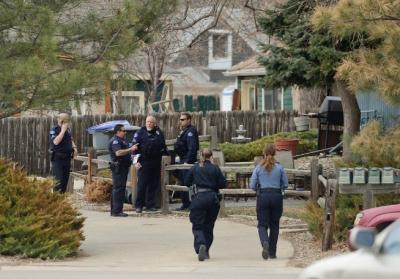 Longmont Police on the scene of a stabbing on Green Place on Wednesday.Matthew Jonas/ Staff photographer
Longmont Police on the scene of a stabbing on Green Place on Wednesday.Matthew Jonas/ Staff photographerThe woman who was attacked was taken to Longmont United Hospital, where she underwent surgery and is expected to recover, he said.
Police located the suspect at the hospital after she apparently arrived with the baby and said she had suffered a miscarriage, Satur said.
He said the victim and suspect did not know each other. The pregnant woman was at the home to buy baby clothes through a Craigslist ad, officials said.
The suspect may be mentally ill, officials said. Names have not been released in the case.
"This is a tragic case for a mother right now," Satur said. "She came by this house. She was attacked, and her baby was removed from her."
The alleged assailant has two children, Satur said. Her husband apparently drove her and the baby to the hospital and then returned to the scene later. He was escorted to the hospital but has not been arrested and is not a suspect, Satur said.
The suspect was arrested at 7:45 p.m. at Longmont United Hospital on suspicion of attempted first-degree murder, first-degree assault and child abuse knowingly and recklessly resulting in death.
Boulder County District Attorney Stan Garnett said his office will consider what charges are appropriate.
"The issues involving an unborn child are complicated under Colorado law," Garnett said. "In most circumstances, if a child was not actually born alive, then homicide charges are not possible. With a case like this, most of the time charges would not need to be filed until sometime next week."
Source: Longmont Times-Call
Addendum: Dynel Lane cut the baby from the belly of Michelle Wilkins. Lane had previously lost her own child to drowning. In most Cesarean kidnappings the mother does not survive. Attacker Lane had some technical knowledge because she was a Colorado certified nurse's aide. In later news Wilkins was released from the hospital.
expand
collapse
Longmont 911 tape shows woman pleading for help after baby cut from womb
In a pain-filled voice frequently drifting into mumbled incoherence, a woman just weeks from giving birth tells a 911 operator that she is "bleeding out" in the basement of a Longmont home after responding to a Craigslist ad.
"She cut me," Michelle Wilkins tells the operator between moans and heavy breathing. "I'm pregnant."
The 6½-minute call is the anguished account of a woman who responded to an ad for baby clothes late Wednesday morning, only to be attacked by a woman who stabbed her in the belly and removed the 7-month-old fetus from her womb, according to police.
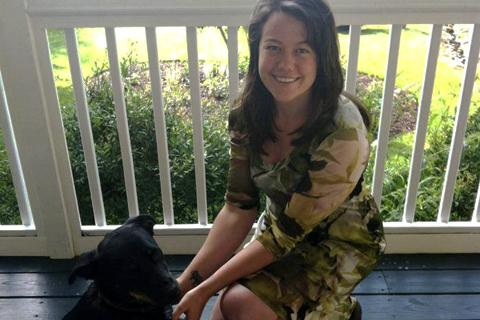 Michelle WilkinsCourtesy Michelle Wilkins' family
Michelle WilkinsCourtesy Michelle Wilkins' familyThe baby, who the Boulder County coroner's office said was female and in her 34th week, did not survive.
According to an arrest affidavit released Thursday, a doctor at Longmont United Hospital told police, "the person who did the incision would have to have researched the subject of cesarean births in books or online to achieve the level of accuracy."
Police have arrested Dynel Catrece Lane, 34, in connection with the stabbing. They say Lane, who was a Colorado certified nurse's aide from 2010 to 2012, attacked Wilkins, 26, at Lane's modest blue apartment in the 1600 block of Green Place.
Police have not yet said what happened from the time Wilkins arrived at Lane's home at 11:51 a.m. to the time Wilkins placed the 911 call at 2:41 p.m. — nearly three hours later.
"Don't go to sleep," dispatcher Beth Kemper repeatedly pleads with Wilkins while assuring her help is on the way.
Four minutes into the 911 call, Wilkins repeats "Help, help me." She told Kemper the stabbing happened when she was "trying to leave." After hearing the doorbell ring, Wilkins perks up at the end of the call as police arrive, telling Kemper, "Yeah, they're here. They're here."
The Wilkins family said in a statement Thursday evening: "Michelle is in critical but stable condition and resting comfortably."
The family thanked Longmont police and the staff at Longmont United Hospital, adding: "We are thankful for the outpouring of love and support from the local community and others who have expressed their condolences. We know you are grieving too, and we truly appreciate the support."
Officials said Wilkins and Lane did not know each other.
Unsafe for release
Lane made her first court appearance in the case on Thursday at the Boulder County jail, where a judge ordered her held on $2 million bail after a prosecutor said "there are no conditions that could make this defendant safe" for release.
 A photo of Longmont stabbing suspect Dynel Lane posted to her Facebook page in April 2014.Photo via Facebook
A photo of Longmont stabbing suspect Dynel Lane posted to her Facebook page in April 2014.Photo via FacebookLane was not in the courtroom; she was in a side room away from the gallery. A deputy held a door open just enough so she could hear the proceedings through a crack. Boulder County assistant district attorney Ryan Brackley said in court that "this was an extremely violent act, a premeditated act."
Lane did not speak during the hearing and left the courtroom clad in an orange jail jumpsuit and shackled, her head bowed as she shuffled away.
She is being held on suspicion of attempted first-degree murder, first-degree assault and child abuse knowingly and recklessly resulting in death. The Boulder County district attorney's office says it plans to file formal charges Wednesday.
According to the police report, Lane showed her two teenage daughters an ultrasound in December and told them she was having a baby boy.
The report says Lane's husband, David Ridley, came home at 2:15 p.m. Wednesday to take his wife to a prenatal checkup and was met at the stairs by Lane, who was covered in blood.
She told her husband that she had a miscarriage and that the baby was in the bathtub upstairs. Ridley said he "rubbed the baby slightly then rolled it over to hear and see it take a gasping breath."
He then drove his wife and the baby to the hospital. He left the hospital to return home to get his stepdaughters, and it was then that he encountered police.
Police located Lane at Longmont United Hospital, where she told staff members she had a miscarriage. A Longmont police detective reported seeing no signs of Lane having given birth and she refused to submit to an examination.
She then admitted to the detective that "she cut (Wilkins') abdomen open" to remove the baby. Lane was arrested at the hospital at 7:46 p.m.
Arrest charges only
Boulder County District Attorney Stan Garnett said Thursday before the hearing that the charges Lane is being held on "are arrest charges only," making it clear that a determination of the counts she faces has yet to be completed.
One of the primary questions his office will have to grapple with, Garnett said, is whether the baby lived independently outside Wilkins' womb. He said it's unclear how long the fetus would have to live outside the womb to be considered a child.
"It's not a defined time," Garnett said at a news conference.
Garnett says if Lane is not charged with murder in the baby's death, she could face a charge related to the unwanted termination of a pregnancy.
The baby is scheduled to undergo an autopsy Friday, Garnett said. Lane's public defender asked in court Thursday that an expert witness for the defense be present at the autopsy.
"In this particular case, the cause of death is going to be essential," the public defender said.
Lane, who has a Facebook page under the name Dynel C. Ridley, last posted a message to her page March 12. She is pictured with a man in several photos in her timeline. On Sept. 30, 2014, a friend posted a comment under one of those photos, congratulating Lane for being pregnant.
"You guys are a cute couple and I am 100% you are going to have just an equally cute baby," the friend wrote.
Chelsea McKnight, of Denver, said she worked with Lane at Seniors' Resource Center in Lakewood in 2012 caring for Alzheimers and dementia patients. She was shocked to hear the news.
"Knowing Dynel, I can't fathom her doing this," McKnight said. "For her, it must have been a total mental break — or maybe I never knew her."
She said Lane appeared pregnant late last year and even told her she had had a baby boy. But she said Lane never invited her to see the baby and told her she wasn't going to post pictures of the child on Facebook.
"I thought it was odd," McKnight said. "I thought she would go crazy with photos of him."
Lane lists herself on Facebook as an assistant manager at Once Upon a Child, which is a consignment store for used baby clothes. The manager at the Longmont store said Lane had never worked for her — under the name Lane or Ridley. Calls to Once Upon a Child stores in Arvada and Fort Collins yielded the same answer.
Garnett said his office is looking into the suspect's mental health in determining what charges to file.
"We're looking very thoroughly through Ms. Lane's history," he said.
Son drowned in 2002
Nearly 13 years ago, Lane lost a 19-month-old son when he drowned in a backyard fish pond, according to a 2002 story published by The Pueblo Chieftain.
The July 3 story stated that Lane, who then went by her married name Dynel Cruz, performed CPR on her son after finding him unconscious in the decorative pond.
Assistant Pueblo County Sheriff Chip DeLuca told the newspaper that the boy and his sisters "were eating and playing a game while their mother was occupied in another part of the house" when the boy went missing.
DeLuca told the Chieftain that "at first glance, this tragedy looks completely accidental."
Quiet cul de sac
The chaos Wednesday has rattled the typically quiet cul de sac in Longmont, which is lined by modest rentals and dotted with trees. On Thursday afternoon, a stream of cars made its way down the street to catch a glimpse of a home that is now making headlines across the country.
Police asked anyone who has been in contact with Lane to call 303-651-8501.
Source: Denver Post
Prosecutors 35 Years Late
March 18, 2015 permalink
Police have arrested Philip Wood and William Robert Metcalfe for molesting three boys in a group home in Parham Ontario. But the victims had to wait 35 years to see the perpetrator brought to justice. They are not the only victims of child abuse to wait decades for the wheels of justice: [1] [2].
expand
collapse
Second man arrested in alleged sexual assaults in group home for kids
Toronto police have arrested a 63-year-old Toronto man in connection with alleged sexual assaults they say happened over 30 years ago.
 Philip Wood faces charges related to the alleged assaults of children in a group home.TORONTO POLICE PHOTO
Philip Wood faces charges related to the alleged assaults of children in a group home.TORONTO POLICE PHOTOToronto police have arrested a 63-year-old Toronto man in connection with alleged sexual assaults they say happened over 30 years ago.
The incidents occurred between 1977 and 1983 at the Sagamore Farm group home in Parham, Ont., police said in a news release.
Three boys between the ages of 10 and 12 who were staying at the group home were sexually assaulted by a man employed at the farm.
The suspect was “working in a position of trust and authority,” police said.
As a result of an investigation, Philip Wood was arrested on Thursday. He was charged with four counts of gross indecency and four counts of indecent assault on a male.
This is the second man associated with Sagamore Farm to be accused of sexual assault.
William Robert Metcalfe, 71, was arrested and charged with three counts of gross indecency and three counts of indecent assault in July.
Metcalfe was a counsellor at the group home.
Both men are scheduled to appear in court in September.
Police believe there may be more victims and are asking anyone with information to call 416-808-7474.
Source: Toronto Star
Social Worker Impostor in Hospital
March 18, 2015 permalink
There have been many instances of fake social workers trying to enter homes to kidnap babies, but in Oregon Celeste Kathleen Patton tried to impersonate a social worker in a hospital.
expand
collapse
Woman allegedly tried to kidnap baby from Medford hospital
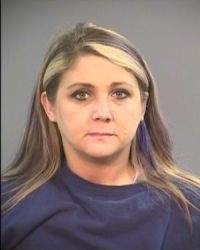
Medford police have arrested a Jackson County woman who they say falsely represented herself as a child welfare worker in an attempt to kidnap a child last week.
Celeste Kathleen Patton, 39, of Central Point, was in the Jackson County Jail Monday on charges of second-degree attempted kidnapping and criminal impersonation, jail records show. Her bail has been set at $25,000.
A woman who officers later identified as Patton went to Providence Medford Medical Center's Birthplace Wednesday and claimed to be a Department of Human Services employee. She tried to gain access to the birth center to take a child, even mentioning a specific name, authorities said.
"We don't even know if that was a child that was actually there," Medford police Detective Sgt. Brent Mak said.
Providence staff did not allow Patton into the birth center and called security, but she had fled by the time guards arrived. A release on the Medford police website says the hospital reported the incident to the agency.
At 7 p.m. Sunday, police responded to a report of disorderly conduct at a Medford Jack in the Box, 2002 Highway 99. The call was about an "uncooperative" woman who was in possible mental distress, Mak said. She was taken to Asante Rogue Regional Medical Center, where she was later identified as the attempted kidnapping suspect from Wednesday and arrested.
Patton was previously arrested in February 2013 on suspicion of driving while intoxicated after her vehicle crashed into a light pole on McAndrews Road.
Source: Medford Tribune Daily
Oxford Child Abuse Wholesale
March 18, 2015 permalink
A recent British report reveals that hundreds of children were abused in Oxford. Most of the victims were in state care at the time. Christopher Booker reports.
expand
collapse
Hidden side of the child-abuse horror
Too many children in care are suffering physical and emotional abuse, and the authorities are turning a blind eye, says Christopher Booker
 'Despite countless attempts to alert social workers and the police to what was happening, no action was taken until 2011'Photo: ALAMY
'Despite countless attempts to alert social workers and the police to what was happening, no action was taken until 2011'Photo: ALAMYLast week’s report on the wholesale abuse of children in Oxford yet again exposed the terrifying contradiction at the heart of our “child protection” system. Although the report focused only on the ordeals of six children, these were taken to be representative of nearly 370 others who, between 2004 and 2012, had been subjected to rape and abuse by Asian men. Two points emerged, as they did from the rather more forthright reports on what happened to those 1,400 similarly abused children in Rotherham.
One was that five of those six Oxford children, and presumably therefore hundreds more, were in state “care”. The other was that, despite countless attempts to alert social workers and the police to what was happening, no action was taken until 2011, when seven of the much larger number of men involved were finally arrested. Nothing is more chilling about all these reports than the evidence of how these children’s repeated appeals for help were not just ignored but treated with contempt.
If this is one side of our unspeakably corrupted “child protection” system, the other, as I have been reporting here for years, is the ever-greater number of children whom those same social workers and police are only too ready to remove from their families for often wholly spurious reasons. Furthermore, as the number of children removed has risen to more than 28,000 a year in England and Wales alone, there is growing evidence that far too many of these children endure much more serious physical and emotional abuse in “care” than anything alleged to justify taking them from their families in the first place.
Yet to this, just as in Oxford, Rotherham, Rochdale and elsewhere, the social workers, police and the courts seem only too ready to turn a blind eye. At least in those instances, something of these horror stories has at long last been coming to light. But still almost entirely hidden from view, thanks to the wall of secrecy the system has erected to protect itself, is the other half of what has become unquestionably one of the most horrifying scandals unfolding in our country today.
Source: Telegraph (UK)
How CAS Wastes Money
March 18, 2015 permalink
According to a recent report by the Ministry of Children and Youth Services, the Children’s Aid Society of London and Middlesex is squandering (taxpayer's) money. The report lists nine areas of wasteful spending, none of them areas that improved the lives of children. The ministry has not released the report, the London Free Press got it through freedom of information.
expand
collapse
Child welfare agency found to have wasted money on office renovations, consultants and bloated management
 The Children’s Aid Society of London and Middlesex leases an office in this building at 685 Richmond St. in London.DEREK RUTTAN, The London Free Press
The Children’s Aid Society of London and Middlesex leases an office in this building at 685 Richmond St. in London.DEREK RUTTAN, The London Free PressA review of spending at the London and Middlesex Children’s Aid Society, kept under wraps for months, revealed nearly two dozen executives made more than $100,000 and the agency shelled out thousands of dollars for taxis and iPads.
London’s child welfare agency squandered money on costly office renovations and highly paid, bloated management ranks, a just-released report by the Ministry of Children and Youth Services states.
The ministry put the Children’s Aid Society of London and Middlesex under review in late 2013 because the agency that cares for vulnerable children was running a deficit.
In a 25-page report kept under wraps for months, the ministry slams the CAS for budget deficits, having too many executives, paying them too much, its medical clinic and questionable expenses in its 2013-14 budget.
Highlights of the report, obtained by The Free Press after the paper filed a freedom-of-information request:
- The CAS spent $300,000 to renovate a leased office at 685 Richmond St.
- The agency shelled out $51,000 in parking fees.
- 22 executives were paid more than $100,000. The number at comparable agencies was 15.
- The agency spent $50,000 in taxis, including $3,535 for one client during two months.
- The bill for technology was nearly $85,600.
Included in the tab were 23 iPads ($19,600), $26,000 for remote access to desktops and $40,000 in other costs.
“It appears the CAS could have taken steps to reduce or eliminate its deficit in 2013-14, had necessary measures been implemented in a timely manner,” the report said.
The CAS moved into leased space at 685 Richmond St. from an office on Dundas St., acting director Regina Bell said.
“They moved walls, installed electric blinds, there was all kinds of money wasted there,” said Karen Cudmore, president of Local 116 of the Ontario Public Service Employees Union that represent CAS workers.
The CAS has scaled back the Richmond St. office, Bell said. Employees there will move back to the agency’s Oxford St. headquarters in about a year and the Richmond office will close, she said.
The agency has trimmed staff and is cutting some programs and services, freeing up space at its headquarters. Details of the cuts to programs and services will be announced later this month.
Tracey MacCharles, the minister of Children and Youth Services, said in a statement her ministry made 37 recommendations to help the Children’s Aid Society of London and Middlesex whip its budget into shape.
“We expect that all CASes function effectively and efficiently, and that includes balancing their budgets,” she said in a statement about the ministry report.
The ministry is encouraged that the agency has acted on 25 of the recommendations and is following the handling of its finances closely, MacCharles said.
“We are optimistic that with the hard work and dedication of the new leadership and new executive, that the London-Middlesex CAS will return to balance. Until that happens, we will continue to provide support.”
As acting director, Bell is steering the agency as it tries to balance the books while meeting its obligations under the law to protect children.
Former director Jane Fitzgerald — at one time Ontario’s highest-paid child-welfare agency boss — is on a paid medical leave of absence.
Bell maintains that the CAS has made progress since the ministry’s report was completed in February 2014.
“I think the board and us have made a real effort to reduce costs. We get accountability, we want to be seen in a positive light,” she said. “Our staff are highly professional and proud of the work they do.”
In the report, the ministry forecast the CAS would have an accumulated deficit of $11.6 million by 2017. The estimate has been cut to $500,000, Bell said.
She cited other areas of progress:
- The executive ranks will be cut to four from eight full-time equivalent, addressing a key concern in the report.
- Other expenses, such as high taxi and volunteer driving costs, have been reduced and more cost controls are in place in those areas.
“We have reduced taxi cab use, we have tightened drivers’ expenses and decreased mileage significantly,” Bell said.
The report flagged the agency’s average cost of $12,000 for every open case. The average for other agencies is $9,000, adding $3 million to the CAS budget.
Many workers at the London and Middlesex CAS have a master’s degree in social work and therefore are paid more, Bell said.
“It’s a key variable. We have more (highly educated) staff than others. It increases the cost.”
Though the CAS has implemented nearly three-quarters of the ministry’s budget recommendations, the two sides remain divided over the agency’s medical clinic.
The agency spends about $300,000 a year for the clinic staffed by a pediatrician and nurses. The ministry doesn’t provide funding for the clinic and recommends the agency use community resources.
A committee is studying outsourcing the clinic’s work, said Michelle Bacon, project manager at CAS.
“Its primary purpose is to meet the medical needs of kids in care. It is highly valued by staff and care providers. It cannot be replicated in the community.”
Staff also oppose shutting the clinic, Cudmore said.
“I will fight to the death for our medical clinic, but the ministry is all over us to get rid of it,” she said.
“We have serious medical and mental health issues and we have well-qualified docs here.”
SHRINKING RESOURCES
- London Middlesex Children’s Aid Society 2013-14 budget: $64.3 million (The Ministry of Children and Youth Services gave $3.9 million to pay off debt, $3.3 million for 2013 deficit)
- Projected 2016-17: $61.3 million
- Projected 2019-20: $55.5 million
- Staff: 366, hourly and salaried
- Children in care: 740, aged birth to 21.
RED FLAGS
Highlights of a provincial review of the 2013-14 budget of the London and Middlesex Children’s Aid Society:
- $300,000 was spent on renovations to a leased office at 685 Richmond St. Parking fees for the office were $51,000.
- $174,500 was spent on consultants.
- The average cost of an open case was $12,000, $3,000 higher than the provincial average.
- 22 executives made more than $100,000; the average at comparable agencies was 15.
- The agency had more executives, office administration and clerical staff compared with other agencies.
- The bill for the agency’s medical clinic was $300,000. The agency doesn’t get funding for the clinic.
- $50,000 was spent on taxis, including $3,535 during two months for one client.
- Six volunteer drivers claimed more than $3,600 a month.
- The agency shelled out $19,600 for 23 iPads, $26,000 for remote access to desktops, and $40,000 in other tech spending.
Source: London Free Press
Plausible Deniability
March 12, 2015 permalink
When CPS investigated a family in Houston Texas the result was what they call a Parental Child Safety Plan. The news does not report what induced the family into the plan, but experience says these arrangements are rarely voluntary. Four-year-old Codrick Mantrell McCall Jr played with a gun in his new foster home and killed himself. After the disaster, CPS denied responsibility, claiming the foster placement was the voluntary act of the father.
Agencies that engage in covert operations use the term plausible deniability. It means the ability to credibly deny involvement when things go wrong. Two other cases of child protectors using the pattern have come to light. Foster mom Bertha Gonzales severely injured a girl in California and Katelynn Sampson died in a Toronto foster home. In both cases child protectors claimed to be uninvolved in the placement.
expand
collapse
Balloon release held for 4-year-old fatally shot while playing with gun
HOUSTON -
Students and staff members held a balloon release Thursday in memory of a 4-year-old boy who fatally shot himself after gaining access to a loaded handgun.
Authorities said on Sunday, Codrick Mantrell McCall Jr. found a gun underneath a bed in the room where he was sleeping and accidentally shot himself. Codrick was not in the care of his parents at the time of the accident.
His father, Codrick McCall Sr., said his son was being cared for by a temporary guardian in what amounts to a temporary foster home.
Channel 2 Investigates confirmed that before Sunday morning's accidental shooting, Child Protective Services had been investigating the young boy's parents and had put the 4-year-old on what's called a Parental Child Safety Plan.
However, CPS officials said it was the parents' decision to put Codrick in that particular home with that caregiver.
Administrators at the daycare Codrick attended decided to hold the balloon release to help bring closure to his teachers and classmates. They said although some children are too young to understand, it will be a way to remember the boy who will no longer be at the school.
It is a crime to leave a loaded, unlocked firearm in an area where a young child can get hold of it.
"It's a matter of life and death," said gun expert Cameron Liss, a gun sales associate at The Arms Room, a gun store and gun range.
He said you can buy simple gun-locking devices for as little as $10 and up if you don't have a lock for your handgun, many police departments will provide one for free.
Lock boxes are particularly simple to use and can be opened in three seconds with a simple twist of a key.
As for who's to blame for this tragedy and who made that deadly weapon so easily accessible to a young boy, that will be up to a grand jury to decide.
Source: KPRC Houston

Guardian / Foster Rift
March 12, 2015 permalink
Desi Elwell, age 12, needs heart surgery to ensure his survival. He has been living with his aunt Mandi Lumley-Sage in Tennessee for six years, but she cannot give permission because she is not his legal guardian. Guardianship rests with the Yakama Nation in the state of Washington. When Lumley-Sage approached the tribal court they not only denied her request but reverted custody of Desi back to his former (abusive) foster home.
This problem is intrinsic to foster care. Day-to-day care lodges in a foster parent without authority while authority rests with a social services system that at best sees the child monthly and at worst may be absent for years. Occasionally the rift can be life threatening. At least for Desi the problems have been worked out and in later news he has been scheduled for surgery. Two articles are enclosed.
expand
collapse
Boy’s family says Yakama tribal court stands in way of heart surgery
 Desi Elwell, 12, holds up a certificate proclaiming his promotion at the end of the school year in 2013. Desi is scheduled to have heart surgery next Friday, but is caught up in complicated custody battle within the Yakama Nation's tribal court and child welfare system.Photo courtesy of Kevin Sage
Desi Elwell, 12, holds up a certificate proclaiming his promotion at the end of the school year in 2013. Desi is scheduled to have heart surgery next Friday, but is caught up in complicated custody battle within the Yakama Nation's tribal court and child welfare system.Photo courtesy of Kevin SageNext Friday, 12-year-old Desi Elwell is scheduled for heart surgery — surgery his doctors say is essential to avoid risk of heart failure.
Desi, a former foster child from Yakima now living in Nashville, Tenn., with his two older brothers and their aunt, Mandi Lumley-Sage, has Tetralogy of Fallot, a four-part congenital heart defect. The condition makes his heart work overtime to pump properly oxygenated blood throughout his body, and he needs surgery to expand a narrowed artery.
While Nashville doctors agreed to schedule the surgery, according to Lumley-Sage, the hospital will not allow them to perform it without permission from tribal court because she is not the legal guardian.
Though she is the legal guardian of Desi’s brothers (her nephews), and though she has cared for Desi since a tribal welfare program placed him with her in 2009, and though she is an enrolled member of the Yakama Nation herself, Lumley-Sage has not been able to obtain legal guardianship of the boy.
What’s more, upon first placing Desi with Lumley-Sage, the welfare program specified that any medical surgical services for him “must be arranged” by the tribe’s child welfare program. Hospital consent forms routinely require the signature of the legal guardian in such cases.
Jurisdiction over his placement rests with the tribal court, and when she reached out in mid-February to get approval for the pending surgery, she says the court not only denied her request, but reverted custody of Desi back to his former foster home, where social workers documented malnutrition and abuse, according to a 2012 case summary by a tribal social worker obtained by the Yakima Herald-Republic. That home was not on the reservation nor were the foster parents tribal members.
“He’s developmentally disabled, and needs counseling to work through the excessive abuse he suffered in that home,” Lumley-Sage said, citing a recent evaluation by a social worker in Nashville, where she moved for a job in 2012, bringing the boys with her.
“(The court) told me I will not ever have standing in court again. I never had a hearing; never had notice.”
She has created a social media campaign, #iheartdesi, to bring attention to their story, and has gained news coverage in Tennessee and elsewhere. Photos and video show Desi and his siblings smiling and laughing as they caper around with Lumley-Sage and her husband.
Desi’s story comes less than a month after Yakima police found twin girls severely malnourished and abused in the home of their biological mother, where the tribal court had placed them in 2013 after seven years in a foster home.
The two cases highlight the complicated web of overlapping jurisdiction over tribal foster children, where well-intentioned policies aimed at keeping Indian children in tribal communities do not guarantee that decisions are made in kids’ best interest.
Records from Desi’s tribal court case and time in foster care are confidential, as are most child custody matters in state and tribal court. Attempts to contact the tribal court about the Lumley-Sage case were unsuccessful.
Sources familiar with the tribal court process in child welfare cases said the judge usually makes decisions based on the recommendation of case workers.
Why the court refuses to give Lumley-Sage a hearing on the surgery is unclear.
‘An exceptional caregiver’
Jurisdiction over custody of tribal children was established by the Indian Child Welfare Act, passed in 1978 to protect Indian children from being forcibly removed and placed with non-Indian families, where their heritage is often lost. The act prioritizes placement of children with relatives or another tribal family before nontribal foster homes. But courts are also supposed to consider proximity to home and extended family in placement decisions.
The Yakama Nation’s child welfare program is known as Nak Nu We Sha, and its social workers manage foster care for Indian children living on the reservation or coordinate with the state on case management off-reservation. Custody decisions, however, are made in tribal or state court, depending on family circumstances.
Lumley-Sage was granted full custody of her two older nephews in a kinship placement soon after they were born. They are now 14 and 15. Her brother, who is their father, struggles with addiction, she said, but loves the boys very much and wants her to be their guardian. Desi has a different birth father, not related to Lumley-Sage. The three boys’ birth mother is now deceased.
The case summary written by a licensed Nak Nu We Sha social worker in April 2012 calls Lumley-Sage “an exceptional caregiver,” and describes the condition Desi was in when he was first removed from his foster home in Yakima in 2009.
“When placed (with Lumley-Sage) at 6.5 years old, Desmond had never been to school, was not toilet trained and was diagnosed with malnutrition and had suffered abuse,” wrote licensed social worker Marlene Simla.
Simla, who specialized in placement, wrote that she had been familiar with the case since 1999, when Lumley-Sage received temporary custody of the older nephew.
Desmond, she added, was developmentally disabled and had been diagnosed with Fetal Alcohol Syndrome.
The case summary also notes that three of Desi’s siblings — not in Lumley-Sage’s care — had died. Lumley-Sage says that’s why the boys’ birth mother supported her guardianship.
“She felt the only way her kids would survive was in my care,” Lumley-Sage said.
Tribal court orders show she has sole custody of the two older boys. She does not have legal guardianship of Desi, though the same 2012 case summary indicates a social worker “facilitated a court order to enable Desmond to have proper care and relocate to the Nashville area” with Lumley-Sage.
Simla wrote that as of 2012, “We are pleased to say that Desmond is now toilet trained, he reads at grade level and was able to graduate from a special needs classroom to a normal classroom ...”
Her letter describes the lengths Lumley-Sage went to in caring for Desi’s next older brother, who was labeled a “medically fragile” baby and required constant care to monitor his feeding and breathing, and was hospitalized extensively during his first nine months of life.
Desi, too, is labeled medically fragile. He’s already had multiple surgeries to replace all four valves in his heart. Lumley-Sage says that if he can receive the pending surgery to expand a pulmonary artery while he’s healthy, and it goes well, he will be eligible for another surgery in a couple of years that would allow him to lead a more normal life.
But “normal” with Tetralogy of Fallot will never really be normal, says local cardiologist Dr. Dave Krueger, who practices at the Yakima Heart Center.
“It’s a serious heart condition,” involving missed connections between the two sides of the heart, he said. With proper care, people can live for up to 25 years post-corrective surgery, but the benefits are limited.
“I’ve never seen a Tetralogy of Fallot older than 40,” said Krueger, who has not treated the child.
Murky finances
Lumley-Sage is not formally a foster parent, so she does not receive money from the state to care for Desi and his brothers. Desi’s medical bills are covered by Social Security.
But his prior foster parents presumably were paid by the state Department of Social and Health Services to care for Desi and other foster children, though they would have been licensed by Nak Nu We Sha if they were caring for tribal children. The rates set by the state per child range from $400 to $1,300 per month, depending on the child’s age and disability.
Though she doesn’t have documentation, Lumley-Sage says Desi was in the top tier of payouts, as he is considered medically fragile, terminally ill and developmentally disabled. The larger payments are given in recognition of the extra challenges inherent in caring for special needs kids, not for their medical care, which is covered by the government. Foster parents are also eligible for money to cover child care costs and small payments for clothing, school fees and other financial needs.
State funding can go directly to foster parents to care for children, or paid to Nak Nu We Sha to administer programs. It’s not known in this case how Desi’s foster home was paid. Calls to Nak Nu We Sha director Ray Olney were referred to the Tribal Council media committee and chairman JoDe Goudy, who has not responded to multiple calls.
Nak Nu We Sha may have a financial incentive to keep children in the court system, because as long as the child has a pending case there is state funding for his or her care, several sources close to the highly confidential process told the Herald-Republic. But children placed with relatives, like Lumley-Sage’s guardianship of Desi’s brothers, trigger no such funding. It may be that keeping Desi in legal limbo keeps him eligible for state funding, although it has not reached him in recent years, Lumley-Sage said.
News stories this year and in the past have revealed nightmarish situations in which licensed foster care providers accept kids purely for financial reasons, such as the Spokane woman convicted in 2008 for criminal mistreatment that resulted in a young boy’s death by dehydration. Prosecutors alleged that she took in foster kids to pay her mortgage and kept them malnourished and sick so they would receive larger support checks.
Nak Nu We Sha has been questioned before about how it manages its finances. In 2012, two former employees of the tribe’s social services department claimed that they were fired after reporting corruption, specifically that one-time payments intended for foster families with financial need were instead going to program employees and relatives.
One of those employees, Robert Ramirez, former deputy director of the tribe’s social services, is still concerned by what he saw.
“Some of the foster home placements need to be looked into for the proper care of the vulnerable children that are being placed,” he said.
He said he was also concerned that some foster families were receiving foster care stipends despite not having any children in the home, though he was unable to get concrete proof.
Management in Nak Nu We Sha needs to have greater knowledge of individual cases and their history so they can make informed placement decisions, he said.
What next?
Lumley-Sage won’t describe all the abuse Desi allegedly suffered in his previous home; he was apparently kept in his bedroom by a baby-gate across the door, and when he was allowed out, was taped under a laundry basket on the floor. She just wants to follow through with the social worker’s recommendation of intensive therapy to help him sort through his past.
She says the tribal court did not give a deadline for returning Desi, and she’s not sure what lengths the tribe will go to get him back, as he is now living out of state, or what law enforcement agencies may become involved. She is currently meeting with attorneys to advocate for her in gaining guardianship of Desi and moving forward with medical care for him.
Lumley-Sage knows that speaking openly about a foster care case may further stress relationships between her and tribal leaders, but she is hoping that public accountability in this situation will motivate the court to grant approval for Desi’s surgery.
“I’m not doing this to hurt tribal people and tribal children,” she said. “I’m doing this to help tribal people and tribal children,” she said.
Source: Yakima Herald-Republic
Permission granted: Yakama boy will receive needed heart surgery
After a tumultuous few days, word came Thursday evening that Desi Elwell, the 12-year-old Yakama boy whose complicated custody battle threatened a critical heart surgery, will be getting the procedure next week after all.
“This is thanks to the community coming together — the community fought and saved a life,” Mandi Lumley-Sage said by phone from Tennessee, where she moved in 2012 with Desi and his two older brothers, who are her paternal nephews. The family has seen an outpouring of support on social media this week, followed by a story Thursday in the Yakima Herald-Republic and television reports in Tennessee and elsewhere.
The Yakama Nation tribal court granted Lumley-Sage ex parte guardianship of Desi on Thursday, giving her the ability to legally consent to Desi’s heart surgery, which is scheduled for March 13.
Ex parte guardianship is temporary, meaning she is only his guardian for 30 days. A hearing is scheduled for March 24 to determine what happens next.
Doctors in Nashville had scheduled the surgery, but they required a signature from a legal guardian in order to perform the procedure.
Documents from the Yakama Nation tribal court show Lumley-Sage’s petition for guardianship of Desi, dated Nov. 12, 2014, was signed March 5, 2015, by Yakama Judge Lorintha Umtuch.
The document indicates that Nak Nu We Sha, the tribal child welfare program that oversees child placements, shall supervise the guardianship “as needed.”
“I’m so thankful for the outcome for Desi,” Lumley-Sage said. She’s grateful for the court’s decision, which judges told her was made on an emergency basis because of Desi’s imminent need for surgery.
The heart surgery, the latest of several for Desi, who was born with the congenital heart defect Tetralogy of Fallot, is needed to widen a narrowed artery to allow his heart to pump properly oxygenated blood throughout his body. Without it, he would be at risk of heart failure.
“I do agree with (the court) on this, that when you have a child that has a life-threatening situation, you have to step in in an emergency,” Lumley-Sage said.
However, she said, “I’m still heartbroken for the rest of the children who have not had a voice” in custody battles such as this.
Source: Yakima Herald Republic
Protecting Chase's Foreskin
March 12, 2015 permalink
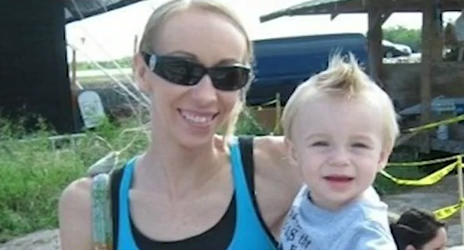
Source: The Blaze
A Florida court has ordered the arrest of Heather Hironimus after she fled to a women's shelter to protect her son from circumcision. The boy, Chase, is four years old and is terrified of the procedure.
expand
collapse
Judge orders West Boynton mom's arrest in circumcision case
A judge issued an arrest warrant for a woman who refused to show up in court with her son, 4, Tuesday so the father can have the son circumcised. The father wants the procedure done, but the mother does not.
Despite the threat of being jailed Tuesday, a West Boynton mother hid with her 4-year-old son in a domestic violence shelter, the latest twist in a widely reported court fight to stop the boy's planned circumcision.
But Palm Beach County Circuit Judge Jeffrey Dana Gillen still signed a warrant for Heather Hironimus' arrest, refusing requests from her lawyers to first consider a mental health exam of the boy and appointing an independent guardian to speak on the child's behalf in court.
"The child is scared to death of the procedure and doesn't want it," said attorney Thomas Hunker. "There have been no safeguards put in place to protect the child's psychological and emotional condition with regards to this surgery."
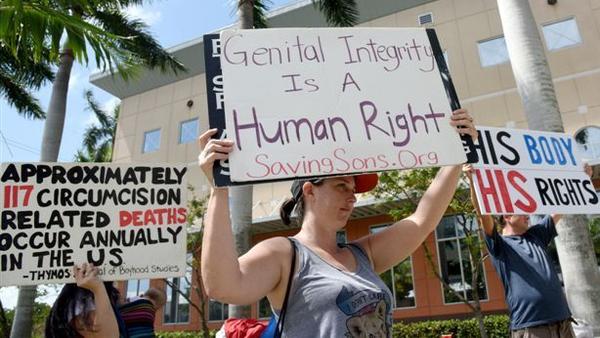 Supporters of Heather Hironimus including Colleen Fogarty, gather outside of the South County Courthouse in Delray Beach where Hironimus was to face off in court with the father of her child, Dennis Nebus, of Boca Raton. Hironimus has been fighting Nebus' efforts to have their son circumcised.Mark Randall, Sun Sentinel
Supporters of Heather Hironimus including Colleen Fogarty, gather outside of the South County Courthouse in Delray Beach where Hironimus was to face off in court with the father of her child, Dennis Nebus, of Boca Raton. Hironimus has been fighting Nebus' efforts to have their son circumcised.Mark Randall, Sun SentinelAttorneys for the child's father, Dennis Nebus of Boca Raton, requested the crisis shelter's name and location during a brief hearing Tuesday, so the mother could be served with a court order for Nebus to pick up his son. But Gillen said he would not order the disclosure of the shelter's name.
The mother and son "sought refuge" at the shelter on Feb. 23, when it was her regular time to have custody of the boy, Hunker said. Nebus then was attempting to make arrangements for a Broward doctor to remove the child's foreskin.
The warrant authorizes law enforcement to take Hironimus into custody, on the grounds that she failed to appear before the court Tuesday as ordered. Such warrants typically require apprehended individuals to be brought before a judge within 24 hours.
"She doesn't believe she should be incarcerated for protecting her child," Hunker said.
On Friday, Gillen declared the mom in contempt of court for violating an order enforcing a 2012 parenting plan, which makes the dad responsible for arranging the circumcision. The mom and dad did not marry either before or after the boy's birth on Oct. 31, 2010.
After Nebus testified Friday that he can't find his son, the judge ordered the mom to appear in his courtroom with the child by 2 p.m. Tuesday.
"I was hoping the mother was going to be here," Nebus' attorney May L. Cain said after learning Hironimus remained at the shelter.
"I was, too, obviously," Gillen replied.
The judge last week called it "reprehensible" for the mother to spirit away the boy.
"I will allow her to avoid incarceration or get out of jail if she signs the consent to the procedure," Gillen said Friday.
The judge found the mom had willfully violated the plan she signed when the boy was 1. The judge also said Hironimus had committed a "direct, contemptuous violation" of court orders by continuing to team with circumcision opposition groups — called "intactivists" — that have "plastered" the child's photos and name "all over the Internet."
After a state appellate court in December held up Gillen's earlier ruling enforcing the parenting plan, the judge instructed Hironimus and Nebus to "protect the child from any exploitation."
Gillen has ordered the media not to release the name or photo of the child, and the Sun Sentinel has filed a motion seeking to vacate the order. A hearing on the matter is scheduled before Gillen on Wednesday.
More than a dozen protestors stood outside the county courthouse in Delray Beach on Tuesday. Some carried signs reading, "His body his rights" and "circumcision is a sex crime."
"It's outrageous that this could actually be happening," said Jennifer Cote of Pembroke Pines, a mother of a 2-month-old son and a 4-year-old girl. "We think this is a choice [Hironimus' son] should make for himself."
Kristen Shockley, of Boynton Beach, one of Hironimus' longtime friends, said it's important to consider the boy is well "past the infancy stage." Shockley said her 9-month old and 4-year-old sons were not circumcised since there was no medical reason for it, nor any cosmetic or religious purpose.
Neither Nebus nor Hironimus is Jewish, but the dad testified last year he thinks circumcision is "just the normal thing to do" and he decided late in 2013 to press for it after noticing his son was urinating on his leg. The father says the boy has a condition called phimosis, which prevents retraction of the foreskin, but the mother has said there is no such diagnosis.
The American Academy of Pediatrics says the benefits of newborn male circumcision are lower risks of urinary tract infections; getting penile cancer; and acquiring HIV, the virus that causes AIDS.
Judge Gillen mentioned these benefits in court last week, and called the procedure "very, very safe."
Still, the most recent federal statistics indicate circumcision has been waning in popularity across the country.
For Jewish families concerned about following the ancient tradition of circumcisions, a group called Doctors Opposing Circumcision advocates an alternative ceremony called a Brit Shalom, "which does not cut the genitals or risk physical or psychological harm to the child."
In an emergency motion filed last week, Hunker wrote the boy "is aware of what is happening and is terrified by the procedure. He is also angry that the procedure is being forced upon him."
The attorney said the boy needs to be examined a by mental health expert so the court can "consider the child's emotions and feelings on the matter."
"This is not a situation where [the child] is a newborn; he is old enough to remember the procedure and what his body looked like before," Hunker wrote. "Removal of part of the most private part of his body could emotionally scar [the child] for the rest of his life."
Nebus has accused the mother of putting fear into the boy.
"My son has mentioned things to me that he's scared to have his penis cut off," he testified.
Source: Sun Sentinel
Real Child Name for Real Parents
March 12, 2015 permalink
In an item that has nothing to do with Children's Aid, babysitter Greg Dalley is on trial for causing the death of baby Noah Keizer. The story is here to contrast. In the rare cases where deaths in CAS care are in the news, the names are almost always suppressed. Although about a hundred children a year die under Ontario CAS watch, in the last two years only one name, ten-year-old Tyrese Sutherland, has been in the news.
expand
collapse
CLAIRMONT: Texts show accused killer Dalley was tired of babysitting Noah Keizer
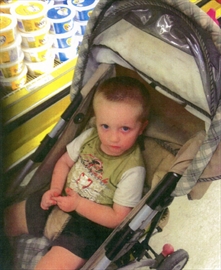 NOAH KEIZER
NOAH KEIZER
An evidence photo of Noah Keizer captured on Greg Dalley's cellphone on July 13, 2012.Hamilton Police Service photoIn the photo, Noah looks like he has been crying.
His eyes are red-rimmed. He is unsmiling. He looks unhappy. Tired.
But otherwise, healthy.
He is buckled into his stroller, wearing navy shorts and a khaki T-shirt.
He is looking up at the camera. Behind him are rows of margarine containers.
This photo of 26-month-old Noah Keizer was taken at 8:36 p.m. on July 13, 2012, at the No Frills store on Main Street East.
It was taken by Noah's babysitter, Greg Dalley.
Less than three hours later, Noah would be without vital signs. He would stop breathing and have no pulse. His mouth would be filled with blood.
And after that, Dalley, who was 25 then, would be charged with second degree murder.
The last photo of Noah, taken from Dalley's cellphone, was entered into evidence Monday as the murder trial entered its second week.
The jury has heard Noah died of blunt force trauma to his head. A pathologist is expected to testify that the injury was not self-inflicted.
On the witness stand all day was Lasaundra Grey. She lived a floor below Nicole Agnew and her son Noah at their King Street East apartment building.
Grey testified about visiting Dalley upstairs as he babysat Noah and waited for Agnew to come home from the bar she worked at. Grey sat outside on the balcony while Dalley made a bed for Noah on the living room floor using blankets.
They made plans to go to Hess Village later that night, after Dalley was done babysitting.
At one point, Grey went inside to get a Coke from the fridge and peeked in on Noah.
"I realized when he turned over there was something wrong. I noticed his face was a bit swollen."
She got Dalley, and he picked Noah up.
"I realized he was bloody and his face was really swollen," she said. "It was his nose leaking toward his ears and he had a big bump on his forehead ... I took him from Greg and placed him in my arms and tried to wash it off his face — the blood."
They cleaned the child up, iced his forehead and Grey's partner, Ashlyn Kashuba, who had arrived, called Agnew and put her on speaker phone.
"We told her that Noah got hurt," Grey testified.
Grey said she asked Dalley what happened and "he basically told us that he might have rammed himself into the wall because it's a thing he does or a thing that kids do."
Noah was crying and calling for his "Mama."
Grey reassured Agnew that her son was fine and reassured Noah that his mommy would be home soon.
Dalley put the child back to bed. Grey and Kashuba went to their apartment to get ready to go to Hess Village. They stayed in contact with Dalley by text.
Dalley appeared to be growing frustrated waiting for Agnew. The jury has heard she was asked to work late that night but even when her shift ended, she stayed at the bar and drank.
"I swear if she keeps neglecting him, I'm going to call CAD on her," Dalley texts, then corrects himself by texting "CAS" — Children's Aid Society.
Also: "She needs to hurry the f--- up ... and get here."
At 11:30 p.m. there is a knock at Grey and Kashuba's door.
It's Dalley, carrying Noah.
"Tell me if Noah's breathing. I don't know if he's breathing," Dalley shouts when they open the door.
Court hears the 911 call made by Grey.
"He's not breathing at all," she tells the call taker. "He's two years old ... For some reason, I think he bumped his head. He's been bleeding out of his mouth."
She is instructed to "put your mouth right over his nose and his mouth," to resuscitate him.
"He's bleeding out of his mouth and spitting up blood," says Grey.
She starts chest compressions and Dalley's voice comes on the line. He is polite, relatively calm.
"A police officer just arrived here," he says.
The line goes dead.
Susan Clairmont’s commentary appears regularly in The Spectator. sclairmont@thespec.com
Source: Hamilton Spectator
Dead or Alive
March 12, 2015 permalink
Social workers check on children on their watch at least once a month to ensure their well-being. It is a vital control to protect against fosters collecting reimbursements for neglected children. In Alberta a child under social services supervision died, but the death did not become known for two months.
expand
collapse
'Deeply, deeply disturbing': Baby's death went unreported for two months
EDMONTON - The death of a six-month-old baby girl went unreported for nearly two months even though child welfare authorities were purportedly overseeing her care.
The baby girl was known to be at risk and was supposed to be receiving intervention services when she died on Jan. 4, but the Ministry of Human Services did not learn of her death until March 2.
Her death was publicly reported two days later, along with four additional child welfare fatalities in February, bringing the annual total to 26 and setting a record for the highest number of deaths recorded since the province started keeping track in 2008.
NDP Leader Rachel Notley said the situation is “deeply, deeply disturbing” and called on the government to launch a full inquiry into the girl’s death.
“Clearly, if it took two months for someone to notice the child had died, she wasn’t getting the kind of support she needed,” Notley said.
“Here was a family that was identified as one that required assistance and support to maintain a safe home, and it’s obvious that at least two months went by without them receiving anything.”
Notley said front-line workers are “stretched well beyond capacity” and criticized the government for cutting funding for child death investigators even as the number of child welfare fatalities hits record highs.
“We’ve got 26 kids dying under the watch of this government and this premier’s reaction is to cut funding to the Children’s Advocate,” she said, referring to the Prentice government’s decision last month to uphold a $275,000 cut to the budget of Alberta’s Child and Youth Advocate, which is responsible for independently investigating the deaths of children in care.
“Where are their priorities?” Notley asked.
Human Services Minister Heather Klimchuk said she remains committed to publicly reporting every child welfare death in a timely manner, and the delay in this case was “not acceptable.”
She said it is not yet clear whether the delay was the result of a paperwork error, or whether the front-line caseworker didn’t call or visit the family until two months after the baby’s death.
“For me as minister, it concerns me greatly that this has happened,” she said. “I can’t comment on whether the caseworker knew about (the death).”
She said the girl’s death “appears to be medically related,” a term used by child welfare officials to refer to anything from untreatable terminal illnesses to preventable deaths like that of toddler Kiara Boysis Nepoose, who died in 2009 from untreated pneumonia. The medical examiner has not completed an autopsy in the death of the six-month-old, Klimchuk said, but no criminal investigation is underway.
“I’ve asked for the internal review to take place within the department, No. 1. The next steps would be the Child and Youth Advocate, and of course the Council for Quality Assurance.”
She did not commit to making the internal review public and dismissed concerns about the impact of cuts to the advocate’s office.
“I’m totally sure that the advocate has money to dedicate to investigate children who pass away in care, from his $12-million budget,” Klimchuk said.
It is not yet known whether a fatality inquiry will be held.
The other four children who died while receiving ministry services in February include a seven-month-old boy (Feb. 16), a 13-year-old girl (Feb. 24), a 22-month-old boy (Feb. 26) and a 17-month-old boy (Feb. 27).
The government releases no additional information about their deaths.
Source: Edmonton Journal
Cutting Up a Social Worker
March 12, 2015 permalink
Threats against social workers have spread to Northern Ireland. Gerald Anthony Declan Dobbin has been sentenced for threatening to kill his daughter’s social worker by cutting her up and sending her bits to her family. Part of his punishment is a ban from going within 25 meters of the social worker. Lots of parents would love to have that order.
expand
collapse
Jailed for threat to kill social worker
A man who threatened to cut up a social worker and send the body parts to her family has been jailed for six months.
Gerald Anthony Declan Dobbin, of Richmond Avenue, pleaded guilty to making a threat to kill on December 26, last year.
Derry Magistrates Court heard the 45-year-old made three 999 calls and told the call handler he was going to kill his daughter’s social worker by cutting her up and sending her bits to her family.
He also told the call handler he had not taken his medication and had consumed ten litres of cider.
During police interview, Dobbin said he had no memory of the calls but claimed he never intended to carry out the threats.
He said he had ‘nothing but respect’ for the social worker.
It was revealed to the court the social worker returned to work for a brief period after she was informed of the threats.
However, she is now off on ‘stress related sick leave’.
District Judge Barney McElholm said this incident ‘has ramifications not only for the victim and her family but all the other children that the victim was working with’.
He added: ‘It may have held up cases in the family proceedings court and even if there are no court related matters with a particular child I’m well aware how children can come to rely on and trust their social worker’.
Defence counsel Eoghan Devlin said ‘strangely enough this will actually have an impact on this man’s child’.
He added that the ‘seriousness of this was never lost on the defendant’.
Mr Devlin told the court there was ‘no reason for this’ and it was ‘something totally out of the blue’.
He said Dobbin has a number of difficulties and had consumed a quantity of alcohol on this day, however that ‘doesn’t take away from the effect this has had on the injured party’.
Passing sentence, Judge McElholm said: ‘There are many elements to the fine art of sentencing - retribution, deterrent and rehabilitation.
“Whether or not it is always popular with the public or their elected representatives, rehabilitation is quite frequently the most important element for society.
“If successful, that individual will not commit further offences’.
However, the judge added: ‘One always has to consider whether or not one is sending out the wrong message to others in the community.
“If they think the courts go softly on a particular crime, it may encourage others to commit that crime’.
Referring to Dobbin, he said he was ‘not at all convinced’ the 45-year-old has ‘sufficient motivation’ for a community based sentence.
The judge said there would have to be a deterrent sentence in this case as ‘social workers are extraordinarily vulnerable in that they are often dealing with irrational and angry people and are frequently on their own with out any form of protection’.
He added : “Society has to realise the court and community will not tolerate any attack or threat of attack on social workers.”
Dobbin was jailed for six months and ordered to pay an offender levy of £25.
A restraining order was also imposed which bans the 45-year-old from harassing, threatening or intimidating the injured party.
He is also banned from going within 25 metres of the social worker.
Source: Derry Journal
We Don't Respect No Jury
March 11, 2015 permalink
A Michigan jury found father Joshua Quincy Burns guilty of child abuse, and he is facing jail time. The same jury found wife and mother Brenda Burns not guilty of abusing their daughter Naomi. Notwithstanding the jury, Brenda and Naomi were forced to become fugitives when CPS continued to demand supervision. The Burns family has its own website, tornfamily.com. Two articles are enclosed.
expand
collapse
CPS: Mom hid child, refuses to cooperate
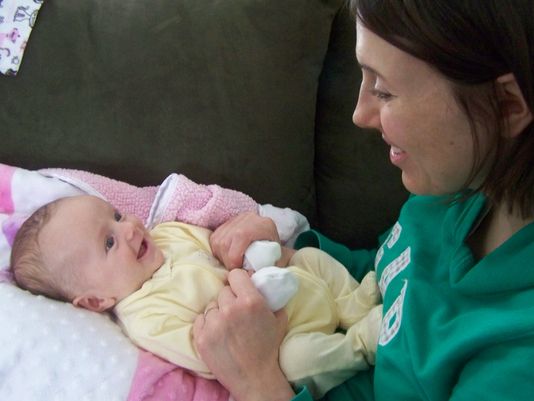 Photo: Burns family
Photo: Burns familyA Livingston County mother whose husband is facing prison for abusing their daughter is accused of hiding the 1-year-old from Child Protective Services.
Juvenile Court Referee Sandra Aspinall ordered Brenda Burns or her husband, Joshua Quincy Burns, to provide the location of their 1-year-old daughter, Naomi, by 5 p.m. Friday. Whether they complied is not known. The couple did not appear at the hearing.
The action came after authorities filed a petition in court seeking to add Brenda Burns to an ongoing case against her husband, who faces an April hearing that could terminate his parental rights to the couple's daughter, because she moved Wednesday and refused to tell authorities where her child is living and refused to allow CPS to check on her daughter.
The court took jurisdiction over Naomi as it relates to her father after a jury in family court found him responsible for abusing the then-11-week-old infant. Joshua Burns also faces a March 19 sentencing hearing in Livingston County Circuit Court after a separate jury convicted him of felony child abuse. He faces up to 10 years in prison.
The state initially sought to terminate Brenda Burns' parental rights as well, but a jury found her not responsible for the alleged abuse to Naomi. As a result, custody of Naomi was returned to her mother's care although court jurisdiction remains in place against Joshua Burns.
Prosecutor William Vailliencourt said Brenda Burns has to allow CPS to visit Naomi to ensure her safety and well-being, which is critical considering Brenda Burns steadfastly supports the man convicted of abusing her daughter.
Joshua Burns maintains that he did not harm his daughter. He testified at his criminal trial that he grabbed Naomi's face to stop her fall when she slipped from his grasp after he ended a phone call from his wife in March 2014. Brenda Burns was not home at the time of the incident.
The prosecution says that following that incident, Naomi suffered seizures, hypothermia, hypotension, bradycardia, apnea and retinal hemorrhages, which led to multiple visits to the emergency room.
However, multiple doctors who testified for the defense reviewed Naomi's medical records and concluded her medical issues were the result of birth trauma and not child abuse.
Joshua Burns said in a telephone interview with the Livingston Daily that following the verdict in the criminal trial Brighton officers and CPS workers "stormed my home under the assumption I'd violated the protective order" that prohibits him from living with Naomi.
"They came in with their hands on their weapons," he said. "I never violated the no contact order."
Court documents confirm that CPS and four Brighton officers visited the Burns' Brighton home the day of the verdict and found Naomi with her paternal grandparents. Brenda Burns was spending the night with her husband elsewhere, court documents noted.
Court documents confirm the officers were on scene because they found Joshua Burns has two outstanding warrants from El Paso County, Colorado.
A clerk at El Paso County court said Friday that records show one warrant for Joshua Burns dating back to February 1998 for failure to appear on a harassment charge.
Source: Livingston Daily Press & Argus
Father convicted of child abuse shares story on web
A Brighton father facing prison for child abuse is sharing his story on the Internet in the hopes of exposing what he calls the "evil regime in Livingston County."
Supporters, who started the website — tornfamily.com — for Joshua Quincy Burns also are seeking donations to the Josh Burns Benevolence Fund, which is administered by "two people who were not part of the Burns family" and is used to fund legal expenses.
Prosecutor William Vailliencourt's response to the website is that Burns is "entitled to say and post whatever he likes, but I think there are a lot of factual inaccuracies" on the website. He did not get specific due to the still-pending criminal case in Livingston County Circuit Court.
"I did not harm my daughter," Burns said in a telephone interview Tuesday. "I love my family. …
"People have to look at the evidence and decide for themselves. There's hundreds of people who decided to; they know my character … and they know there's no way this happened," said Burns, who was convicted following a jury trial for child abuse for harming his then 11-week-old daughter.
The phone call was disconnected and Burns stated in a subsequent email: "I am not interested in doing an interview with you."
Burns acknowledged in the phone interview that the incident — he grabbed his daughter Naomi's face to stop her fall when she slipped from his grasp after he ended a phone call from his wife in March 2014 — did happen as he testified at his criminal trial in Circuit Court in Howell.
However, Burns said "it was an accident" and not child abuse as the prosecution claims. He maintains the evidence supports his stance.
"I admitted my daughter slipped off my knee," Burns said in the phone interview. "If you want to call an accident abuse in this country, then we all better watch out. I've apologized to my wife on countless occasions. ... I now stand convicted of a felony for an accident with my daughter."
The evidence as the Burns family and their supporters see it has been posted online at tornfamily.com. Burns said in email that the "website was created by a group of supporters." He was not more specific.
One supporter listed on the site, Del Belcher, a pastor spearheading the Josh Burns Legal Defense Fund, said he's known the Burns family for about six years, and he was "taken aback and shocked" when he heard about the allegations.
"Someone might argue it would be easier for us to let it go and say he's guilty and that's that," Belcher said. "Why pick the hard road? There's no merit to choose the harder road in this except my conscience and all the evidence I saw. … My opinion is the prosecution did not prove the civil (case) or guilt at the criminal trial. I have to be honest with that."
In the family court trial, a jury found that Burns' wife was not responsible for their daughter's injuries, but Burns was responsible. As a result, the prosecution is moving forward with terminating his parental rights, and he is waiting for a disposition hearing in April.
In a separate criminal trial, a 12-member jury deliberated for more than 10 hours before returning a guilty verdict against Burns for harming his daughter, Naomi, now 1. He faces up to 10 years in prison when he is sentenced March 19.
Burns and his supporters blame his family's situation on the Livingston County prosecutor's office. He said authorities asked him to take a polygraph test and he readily agreed, but they never followed up with the request. He took a polygraph in his attorney's office and passed.
He claims the prosecution "used Naomi as a pawn" by offering to return the infant, who was in the custody of Child Protective Services at the time, to his wife's custody if she would divorce him. The couple did not divorce.
Vailliencourt said his office does ask the custodial parent — in this case Burns' wife — what action, if any, she will take to protect a child in an abuse case and that can include whether the custodial parent will seek a divorce. If so, the prosecution would have withdrawn a petition against the wife for neglect.
"The concern is whether the parent is taking action to protect the child," the prosecutor said. "If they are not taking action to protect the child, then we have no choice but to go forward."
Burns also blames Dr. Bethany Mohr, director of the child-protection team at the University of Michigan Medical Center's C.S. Mott Children's Hospital, who testified that she believes the injuries on Naomi constituted child abuse.
Mohr testified that Burns' daughter had retinal hemorrhaging in both eyes, which she believed is an indicator of child abuse, as well as bruising.
However, multiple doctors who testified for the defense reviewed Naomi's medical records and concluded her medical issues were the result of birth trauma and not child abuse.
"We have six expert doctors saying it's not child abuse," Burns said in the Tuesday phone interview. "No one suspected child abuse until Dr. Mohr got involved in (Naomi's) life."
On the website, it is explained that Naomi was born in January 2014 "through a traumatic birth that started with four hours of pushing, followed by several failed attempts at vacuum extraction" and an emergency cesarean section. The website says that traumatic birth left her with "unforeseen health issues that would later cause serious problems."
On the website tornfamily.com, it is alleged the prosecution's case was "based on the old 'junk science' of shaken baby syndrome, which is being disproven by current medical research."
Burns, who notes he passed a polygraph test, said "head trauma is the new buzzword for shaken baby syndrome."
Vailliencourt said the case was not "a shaken baby case."
"This was a case of physical abuse, head trauma, and the child almost died," he said. "The experts have said the true effects on the child won't be known until she's grown. It's premature to say she's healthy and won't suffer any lasting effects from abuse."
However, the website says just that: "Naomi is back, safe and sound in her mother's arms. She is happy, healthy and meeting all her developmental milestones."
Source: Livingston Daily Press & Argus
Foster Parents Need Guns
March 11, 2015 permalink
Brian and Valerie Wilson know just what it takes to be good foster parents: carrying a loaded weapon. They are trying to get Nevada to change its laws so their concealed weapons permits will not disqualify them as foster parents.
expand
collapse
Vegas couple want right to carry guns while fostering kids
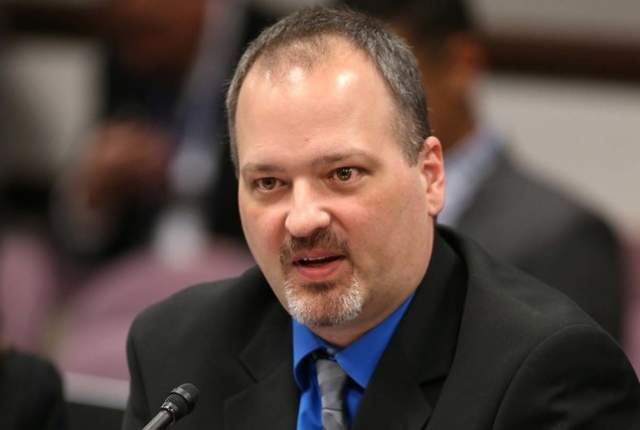 Brian Wilson urges lawmakers to support a proposal to allow foster parents to have concealed weapon permits and weapons during an Assembly Judiciary Committee hearing at the Legislative Building in Carson City on Wednesday, March 4, 2015.Cathleen Allison/Las Vegas Review-Journal
Brian Wilson urges lawmakers to support a proposal to allow foster parents to have concealed weapon permits and weapons during an Assembly Judiciary Committee hearing at the Legislative Building in Carson City on Wednesday, March 4, 2015.Cathleen Allison/Las Vegas Review-JournalCARSON CITY — Brian and Valerie Wilson asked the Assembly Judiciary Committee on Wednesday to approve a bill that would allow them to carry their loaded weapons and serve as foster parents.
In testimony to the committee in support of Assembly Bill 167, the couple said their attempts to get a variance from a state regulation prohibiting the carrying of loaded weapons with foster children was denied.
“I am really heartbroken that the Department of Child and Family Services gave us this denial letter,” Valerie Wilson said. “I really want a family.”
Wilson said the Las Vegas couple always planned to become foster parents and adopt but have been denied permission to do so because of the regulation, which he wants to change with the bill. Current rules require guns and ammunition to be stored separately in secure containers in homes with foster children.
The bill would allow Nevadans with concealed-weapons permits, and law enforcement officers, to carry loaded weapons on their person in a home or car and still be eligible to be foster parents. If not carried on their person, the weapons would be required to be kept in a secure safe, but they could remain loaded.
Assemblywoman Michele Fiore, R-Las Vegas, who sponsored the bill, said the bill has bipartisan support. State Sen. Kelvin Atkinson, D-Las Vegas, who has a conceal-carry permit, is looking at becoming a foster parent, she said.
“I don’t know if some of my peers have toured Child Haven or have been in Child Haven, but we have children in need of great foster care, and we have had people that are law-abiding citizens that have gotten their background checks, that have their CCWs, literally denied to foster a child because they have a concealed-weapons permit,” Fiore said.
Assemblywoman Olivia Diaz, D-North Las Vegas, said foster children are often traumatized. She asked if having them exposed to weapons would be appropriate.
Jill Marano, deputy administrator of the state Division of Child and Family Services, said the agency’s goal is to work with foster parents, but there is a concern about the ability of a child to gain access to a loaded weapon. She opposed the bill in its current form.
Marano said a computer search turned up 16 incidents over the past four months in which children were involved in the accidental discharge of a loaded weapon.
Michael Knight, assistant director of Clark County Family Services, also spoke in opposition, citing the facts presented by Marano.
The committee took no immediate action on the bill.
Source: Las Vegas Review-Journal
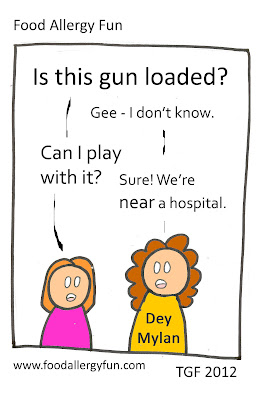
Alberta Disowns Its Child
March 11, 2015 permalink
When the province of Alberta released a fatality report on sixteen-year-old Edwin Fenton Cattleman, they omitted one fact: he was a provincial ward.
expand
collapse
Fatality report doesn’t mention Alberta teen was ward of the province
 Interim Liberal leader David Swann.
Interim Liberal leader David Swann.EDMONTON - A fatality inquiry report into the death of an aboriginal teen makes no mention of the fact that he was a runaway ward of the province, and provides no recommendations to prevent similar deaths in future.
Edwin Fenton Cattleman was 16 when he got drunk and high at a house party in Maskwacis, then fell down a set of stairs attached to an outside deck and died from severe head trauma.
Provincial court Judge Gordon Yake said RCMP initially believed the death was suspicious and conducted an investigation, but they concluded Cattleman died by accident.
“In light of the circumstances of the death of the deceased, I have no recommendations,” Yake wrote.
The report was issued nearly four years after Cattleman’s death on May 24, 2011.
An internal government report obtained by the Journal shows Cattleman had been in and out of care since he was one year old, and had 35 legal statuses and 20 different placements since birth.
He had been subject to a permanent guardianship order for 10 years, which means the province had been acting as his parent for most of his life.
Akamkisipatinaw Ohpikihawasowin Child and Family Services had placed him with his grandmother, but he ran away from home about a week before he died.
Interim Liberal leader David Swann said the judge’s failure to acknowledge the province’s direct involvement in the child’s life and the systemic failures that led to his death is “unacceptable,” and reveals serious flaws in the province’s child death investigation system.
“I would call that incompetent,” Swann said. “This is not a legitimate review process.
“The whole fatality review inquiry process needs to be examined, and at the very least we need to understand what value they add, and what expertise is really needed to do an examination of causes and solutions.”
Swann also said four years is too long to wait for a fatality inquiry report, calling the delay “another black mark.”
The judge’s report also makes no mention of the circumstances under which Cattleman was discovered. The internal report does.
“Once RCMP responded, they located a lone male with severe head injury,” the internal report says. “There was no one else in the home.”
He died alone.
Source: Edmonton Journal
Private Foster Care
March 11, 2015 permalink
An investigative report in Mother Jones examines the failings of privatized foster care, featuring the deaths of Alexandria Hill and Kianna Rudesill. Hill was under the care of the largest private US foster agency, Mentor Network. An agency's quest for profit conflicts with provision of good care for the children.
Fixcas has observed similar money-grubbing behavior in not-for-profit agencies. For example, Peel CAS was caught keeping cases open to ensure a steady supply of funds. But Mother Jones is probably correct in reporting that for-profit care is even worse.
The closing note has been repeated many times by fixcas: jailing a foster parent for the death of a child does nothing to correct the system, though it may divert public attention from the real problem areas.
expand
collapse
The Brief Life and Private Death of Alexandria Hill
When the government took her from her family, it outsourced her safety to a for-profit corporation. Nine months later she was dead.
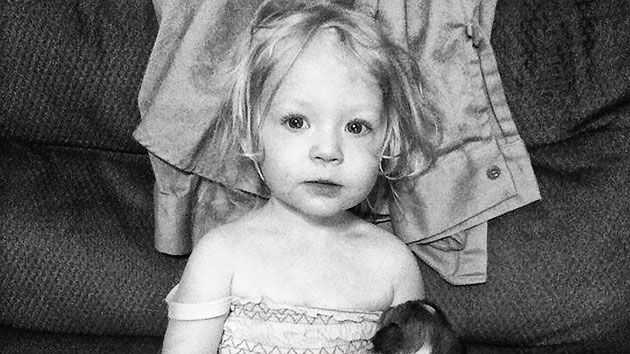 Donna Winkler
Donna WinklerThe sun was beating down on Rockdale, Texas, when Donna Winkler arrived at her sister's ranch-style, clapboard house on the afternoon of July 29, 2013. Winkler was concerned about Sherill. At the age of 54, she had lost her job as a school bus driver after falling and injuring her wrist. Her husband, Clemon Small, a former crack addict, only worked a few days a week as a karaoke DJ. Recently, the Smalls had moved from nearby Austin to Rockdale, population 5,400, to cut costs.
Winkler knew her sister helped support herself by fostering children for Texas Mentor, a private agency that finds homes for children who have been removed from their parents' custody. She had taken in an infant and a two-year-old girl named Alexandria Hill. Texas Mentor paid the Smalls $44.30 a day to care for both kids. The company earned $34.74 daily on top of that to monitor the Smalls. Winkler thought Sherill was in it for the money.
That July day, Winkler walked into the living room to find Alexandria standing, facing the wall, in a dark room everyone called the man cave. With blond hair and blue eyes, Alexandria stood 32 inches tall and weighed just 30 pounds. She liked kitties and the color purple. Alexandria turned around and smiled at Winkler.
"Hi, Alex," Winkler said.
"No, you turn around," Sherill Small barked at the girl.
A squat woman with stringy brown hair and a prominent mole on her cheek, Small seemed on edge. She told Winkler that Alexandria had been getting in trouble all day. Among her offenses: waking up before Small and taking some food and water from the kitchen.
Winkler stayed at Small's house for two hours that afternoon. Two-year-old Alexandria stood in timeout in that dark room the whole time, she said.
At about a quarter to seven that evening, Clemon Small woke from a nap and left for a meeting at a nearby restaurant, leaving Sherill alone with Alexandria and the infant. About 15 minutes later, Sherill dialed his number, then 911.
First at the scene was Ward Roddam, the chief of the Rockdale Volunteer Fire Department, who was so surprised to find no one in the front yard waving him down that he called dispatch to make sure he had the right address. Inside, he encountered what he would describe as one of the strangest scenes in his 25-year career: Alexandria's limp body lay on the floor while Clemon sat on the couch and Sherill talked to 911. Roddam found mucus on Alexandria's mouth, suggesting that CPR, which foster parents are trained to administer, had never been attempted.
On the witness stand 15 months later, Roddam was asked if the Smalls seemed panicked. "'Panic' does not describe it at all," he said. They seemed "very calm."
What happened in Rockdale that night would be the subject of a weeklong trial in the fall of 2014, focusing on the care of Alexandria. But it also opened a window into the vast and opaque world of private foster care agencies—for-profit companies and nonprofit organizations that are increasingly taking on the role of monitoring the nation's most vulnerable children. The agency involved in Small's case was the Lone Star branch of the Mentor Network, a $1.2 billion company headquartered in Boston that specializes in finding caretakers, or "mentors," for a range of populations, from adults with brain injuries to foster children. With 4,000 children in its care in 14 states, Mentor is one of the largest players in the business of private foster care, a fragmented industry of mostly local and regional providers that collect hundreds of millions in tax dollars annually while receiving little scrutiny from government authorities.
Squeezed by high caseloads and tight budgets, state and local child welfare agencies are increasingly leaving the task of recruiting, screening, training, and monitoring foster parents to these private agencies. In many places, this arrangement has created a troubling reality in which the government can seize your children, but then outsource the duty of keeping them safe—and duck responsibility when something goes wrong.
Nationally, no one tracks how many children are in private foster homes, or how these homes perform compared to those vetted directly by the government. As part of an 18-month investigation, I asked every state whether it at least knew how many children in its foster system had been placed in privately screened homes. Very few could tell me. For the eight states that did, the total came to at least 72,000 children in 2011. Not one of the states had a statistically valid dataset comparing costs, or rates of abuse or neglect, in privately versus publicly vetted homes.
"It's troubling," says Christina Riehl, senior staff attorney for the Children's Advocacy Institute at the University of San Diego School of Law. "There are so many places where the government puts money to fix a problem without adequately checking to see if the money is actually fixing the problem." Good data would make the system more accountable, Riehl says, but "data is a low priority because it's difficult. How do you measure child safety?"
Mentor and other private foster care agencies say they are committed to children's well-being, and that nothing can prevent the occasional tragic incident. But in my investigation, I found evidence of widespread problems in the industry—failed monitoring, missed warning signs, and, in some cases, horrific abuse. In Los Angeles, a two-year-old girl was beaten to death by her foster mother, who was cleared by a private agency despite a criminal record and seven prior child abuse and neglect complaints filed against her. In Albuquerque, New Mexico, prosecutors alleged that foster parents screened by a private agency beat their foster son so badly that he suffered brain damage and went blind. (A grand jury refused to return an indictment in the case.)
In Chattanooga, Tennessee, a foster father vetted by a private agency induced his 16-year-old foster daughter to have sex with him and a neighbor. In Riverview, Florida, a 10-year-old girl with autism drowned in a pond behind a foster home. The private agency that inspected the home had previously identified the pond as a safety hazard but had not required a fence. In Duluth, Minnesota, a private agency failed to discover that a foster mother's adult son had moved back into her home. The son, who had a criminal record for burglary that would have disqualified him from being around foster children, went on to sexually abuse a 10-year-old foster girl. In Texas, at least nine children living in private agency homes died of abuse or neglect between 2011 and 2013.
Roland Zullo, a researcher at the University of Michigan who has studied foster care privatization, believes tragedies like these may be linked to the financial incentives of the industry, which he says are not aligned with child welfare. "This is just the kind of service where the market approach doesn't work," he says.
The bottom line for private foster care agencies—whether large, for-profit corporations or small, local nonprofits—is tied to the number of foster parents on their roster, and thus their ability to place children quickly. Given that every foster parent represents potential revenue, Zullo says, an agency may be more likely to overlook sketchy personal histories or potential safety hazards. There's little incentive, he adds, to seek out reasons to reject a family, to investigate problems after children are placed, or to do anything else that could result in a child leaving the agency's program. And as tough as the margins are for nonprofit agencies, the perverse incentives are exacerbated at for-profit agencies that need to make money for owners or shareholders.
"What happens," Zullo says, "is the lives of these children become commodities."
Alexandria's grandmother, Diann Hill, has graying hair and a world-weary way about her. Over plates of fried catfish and okra at a diner in Lexington, Texas, she told me how her granddaughter ended up in foster care.
It was November 2012, three months after Alexandria and her parents—Diann's son, Joshua Hill, and his girlfriend, Mary Sweeney—moved from Florida to Austin to be closer to Joshua's family. Mary and Joshua, both in their early 20s, had problems. Mary suffered from grand mal seizures that prevented her from being alone with Alexandria. Joshua, who according to state records had served time behind bars as a juvenile, struggled with anger issues. They argued over their daughter. They smoked pot. Child protection got involved after receiving a couple of calls about Mary and Joshua, including a report that Joshua nearly dropped Alexandria down a flight of stairs (an incident Joshua denies). "Mary and Josh weren't perfect," Diann said. "They popped dirty for marijuana. No other drugs. Just marijuana. It's not like they were getting Alex high, smoking in front of her. They waited until she went to bed; she was safe in the crib. They didn't leave her alone in the house. She was never sick a day in her life. They fought. What couple doesn't fight?"
In early November, Joshua told child protection he was going to move, with Alexandria, into his parents' home near Lexington, a plan the agency approved. But he didn't follow through; he and Mary remained in Austin while Alexandria lived with his parents. The state didn't like this arrangement, in part because Joshua's dad had been convicted in the 1990s for having sex with Diann's then-16-year-old daughter from a previous relationship. (Diann says she called the police on him and divorced him while he was serving time, but later remarried him.)
In late November 2012, a state investigator signed an affidavit requesting foster care for Alexandria, citing "serious safety concerns" about Mary and Joshua's "limited parenting skills." Alexandria was placed with a foster family. But Joshua complained about the girl's care in January 2013, according to Diann, and she was transferred to Sherill and Clemon Small.
By this time, there had already been warning signs about Sherill's capability as a foster parent. She'd reported to the company that she was stressed out by fostering children, something that might have set off alarms for someone familiar with her background.
She had told her Mentor screener that she had been a foster child herself, entering the system at age two, when her mother could no longer provide for her and six siblings, and that her experiences had been "good and bad." Once, a foster parent made her sit outside in the dark on a cold Missouri night for punishment.
Mentor's assessment also revealed that Sherill didn't raise one of her three daughters, Jennie Langley. Instead, the assessment said that Jennie was raised by her paternal grandmother and that Sherill had a "despondent" relationship with her daughter. The Mentor screener explained this by noting that Jennie was a defiant child who as an adult didn't approve of Sherill marrying a black man. The assessment says that Mentor officials spoke with Sherill's other daughters but gives no indication that Jennie or her grandparents were ever contacted. (Mentor later said it tried to contact Jennie, but was unsuccessful.)
I tracked down Jennie Langley in rural southeastern Texas. Leroy Langley, her grandfather, answered the phone. Leroy said that he and his wife had formally adopted Jennie when she was about seven. In fact, he said, they once had custody of all three of Sherill's daughters because Sherill was "wild, a street woman." One of Sherill's sisters and a daughter confirmed the story to me, saying that the daughters lived with the Langleys for several years in the mid-1980s.
It took me just a few phone calls to get this information. There's no indication that Mentor went to the same effort.
Americans have been horrified by the foster care system for as long as there's been foster care—about a century and a half. In the 1850s, the abolitionist Charles Loring Brace founded the Children's Aid Society of New York, which began removing poor and neglected children from the city and shipping them, by train, to new homes in rural communities. Before long, critics of the "orphan trains" were accusing the society of recklessly placing little thieves and liars into good, upstanding homes. Child protection in general remained in the hands of private charitable organizations for decades, although state legislatures sometimes allocated them money. But in the late 1800s and early 1900s, states began to take the lead, and by the middle of the 20th century, foster care had become entirely a government function.
Today, some 250,000 American children enter this struggling system each year, and child welfare agencies are in perpetual need of more foster parents to handle the influx. Against this backdrop, the private sector's promise of more-efficient services at a lower cost has been hard to resist. A couple of states (Kansas and Florida) are entirely dependent on private foster care agencies. Texas, where 90 percent of foster children are housed in private agency homes, is seeking to privatize the rest of the system—even as child advocates warn that quality of care is slipping. "Texas has chronically underfunded the child protection system," said Ashley Harris, a former CPS caseworker who now works for the advocacy group Texans Care for Children. "I don't think we can expand privatization until some of these basic issues are addressed."

Private foster care agencies generally eschew media scrutiny, but I found one in Sacramento, California, that was willing to give me an inside view. Positive Option Family Services, a small nonprofit with just 15 employees, is based on the east side of town in a strip mall with stained carpets and scuffed walls. I was somewhat surprised that the agency's CEO, Jody Kovill, let me hang around the office, because Positive Option has a checkered record: Since 2008, two children in its care have died, one of appendicitis and the other in a mysterious house fire. The agency oversees only about 70 children, yet state investigators have found more than 190 deficiencies in its operations since 2009, including several failures to screen the criminal records of adults with access to foster children. In May 2013, the state threatened legal action if the agency didn't clean up its act (though no charges were brought).
Positive Option staffers frequently grumbled about their treatment at the hands of county regulators. But other than that I found them to be affable, earnest people who seemed genuinely concerned about the welfare of foster children. Every month, Positive Option hosts a two-hour continuing education class for foster parents in a room with crayon-streaked tables and secondhand chairs. I attended several over a period of months, and each time I was struck by the reunionlike atmosphere, where foster parents hugged their hellos and agency social workers were on a friendly, first-name basis with everyone.
Kovill, the cofounder, is an energetic 82-year-old with a white beard who continues to manage the organization on a day-to-day basis. Kovill feels a special kinship with the foster children he serves: He says he was abandoned by his father when he was about seven and given to a shoemaker as a laborer. "Foster care is a good system," Kovill said. "I wish it had been there when I was a kid." (Kovill told me he changed his name long ago to break from the family that abandoned him. He wouldn't tell me what his old name was.)
Kovill told me the margins are tight in private foster care, especially if child welfare is your top priority. He said he once had to sell land he owned in Arizona to keep Positive Option, which has annual revenues of about $1.2 million, afloat. Some of his employees report taking 10 percent pay cuts several years ago for the same reason, cuts that remain in effect today. "I'm still a businessman, and I still try to stay in the black as best I can," Kovill told me one day in the cramped office he shares with his wife, Luan, who works at the agency for free. "But if it meant a car seat for a baby, if it meant diapers for a baby, if it meant safety for a child, the bottom line is gone."
Kovill took responsibility for Positive Option's problems, saying they came about in part because he was distracted by the agency's financial struggles during the recession. "I just trusted everybody to do what I do—I work hard," Kovill said, referring to some former employees he eventually fired. "I figured they did too. Well, you can't do that."
The state of California pays private foster care agencies like Positive Option a monthly fee for each child in one of their homes. That fee ran from $1,714 to $1,977 (depending on age) per child per month in fiscal year 2013. Under state regulations, roughly half of that money is required to go directly to foster parents, but agencies can elect to give more; Positive Option, for example, rewards outstanding foster parents with more money. Whatever is left over after paying the foster parents goes to the agencies—up to $968 per child per month. In 2013, California paid a total of $308 million to private foster care agencies.
Joshua Hill says he knew Alexandria wasn't going to make it the moment he laid eyes on her in the hospital. She was hooked up to a ventilator, tubes snaking from every part of her body, a brace on her neck. "There's no way she was going to wake up from that," he said. "Her eyes were swollen. There was no chance."
It was Halloween when we met at a park in Lexington, Texas, near where his parents live. As we talked, children roamed the small town's main streets, trick-or-treating in the late afternoon light. Joshua wore an olive Army T-shirt over camo pants, a backward cap concealing his long hair, his long, wispy goatee bobbing up and down as he spoke. He and Alexandria's mother had signed a settlement with Mentor, the terms of which he was not allowed to disclose. But the 25-year-old, who made ends meet delivering pizzas for Domino's when Alexandria was in foster care, pulled up in a late-model Scion tC with a throaty engine and told me he owns property just outside of town.
Joshua said he got the call at around 9:30 p.m., which would have been about two and a half hours after Small dialed 911. "They just said it was something with Alex," he said. "She had an accident. That's all they would say." Joshua was broke, and the hospital was an hour away, but a friend gave him $40 for gas. "I bought a pack of cigarettes and hauled ass," he said.
Joshua showed little emotion when we talked, until he described seeing his daughter in the hospital. Then his voice dropped and his eyes grew wet. "I asked the doctor flat out: 'Is there any chance at all that she could wake up even a little bit?' He said no. There was too much damage inside of her."
Alexandria was kept on life support until July 31 so her mother's family could drive in from Florida to say goodbye. After the plug was pulled, a doctor allowed Alexandria's mother to hold her for 15 minutes before declaring her dead. A subsequent autopsy found the little girl had bruising on her right cheek, left ear, left knee, right ankle, chin, back, and buttocks; multiple blunt-force injuries to her head; subdural hemorrhaging; and two tears in her liver. A third of her blood was found pooled in her abdomen.
Sherill Small was indicted for capital murder—but it was far from a clear-cut case. Small was the only person who really knew what happened, and she claimed it was just a terrible accident.
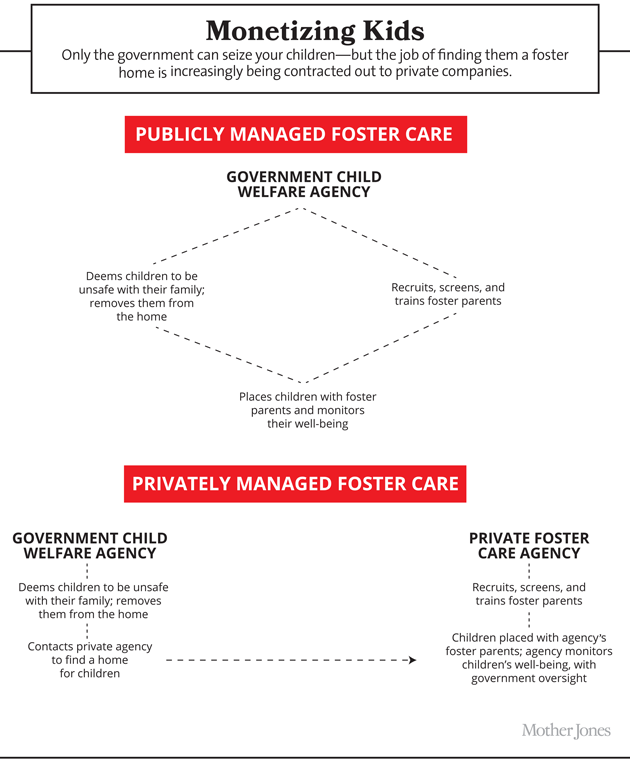
Foster care caseworkers are expected to intimately know the parents to whom they entrust vulnerable children. A good caseworker will know the stressors in a foster parent's life and will carefully monitor the home to ensure the parent doesn't become overburdened. The job requires vigilance and experience, because a missed warning sign can lead to tragedy. "The radar, in my opinion, always needs to be up," says Sheila Van Vleck, a longtime caseworker who has worked for both private foster care agencies and the government in California. "The stakes are very high."
When screening foster parents, the obvious danger is missing a criminal conviction or a child abuse charge. But there are many other issues that can interfere with a foster parent's ability to care for children. In 2006, a two-year-old girl in Victorville, California, drowned in the bathtub when her privately vetted foster mother temporarily forgot about her, according to a lawsuit against the private agency. The lawsuit claimed the foster mother suffered from impaired memory and walked very slowly, using a cane. In another case, in 2008, a private agency in rural California placed a nine-year-old boy with the same family as a 17-year-old foster boy with a history of aggressive actions, inappropriate sexual behavior, and hallucinations. In a lawsuit, the younger boy later claimed that the older boy crept into his bedroom and sexually assaulted him.
Private agencies have also been sanctioned in some cases for failing to educate foster parents on relevant laws or even basic parenting skills. In December 2010, a six-month-old boy was found dead in a crib littered with stuffed animals, clothes, an adult pillow, and an unsecured blanket, according to lawsuits against Los Angeles County and the private agency that vetted the child's foster mother. The county investigator concluded that the young foster mother didn't understand safe sleep practices.
Heather Lamie was caring for five young children when her inexperienced caseworker at The Baby Fold, a regional nonprofit foster agency in Illinois, recommended that she take another foster kid. It was December 2010, and the mother of Lamie's three foster children had just given birth to a fourth. Twenty-seven years old, Lamie also had two children of her own, ages eight and five. Her husband, Joshua, worked overnight shifts an hour away from their home in rural Illinois. Joshua's schedule effectively made Heather the sole caretaker for the six kids, all eight or younger.
The Lamies' oldest foster child was four-year-old Kianna Rudesill, a mischievous kid with long black hair who liked SpongeBob and having her nails painted. Kianna and her siblings had been removed from their biological mother, Tawnee Jones; the children's father, James Rudesill, had tried to obtain custody but says the authorities refused because he had served time for a marijuana offense.
Shortly after receiving her fourth foster child, Heather Lamie started asking The Baby Fold for help. She requested time off from caring for the children and assistance driving them to their many mandated appointments. The Baby Fold maintains it gave Lamie all that she asked for. But state investigators later found that the agency denied her requests, and that it didn't recognize the growing stress on Lamie.
Lamie also complained that Kianna was having behavioral problems. She told social workers that the little girl was violent with her siblings and routinely injured herself. A therapist observed bruises on Kianna's face and ear, but she accepted Lamie's story, even though state investigators now say those injuries are consistent with abuse.
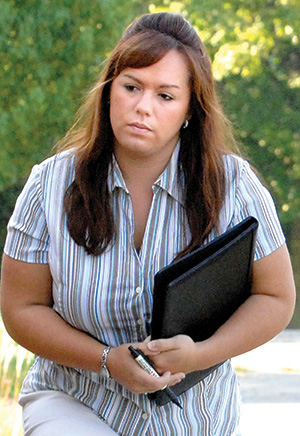 Prosecutors said Heather Lamie snapped under "overwhelming" pressure and killed one of her four foster children.David Proeber/The Pantagraph
Prosecutors said Heather Lamie snapped under "overwhelming" pressure and killed one of her four foster children.David Proeber/The PantagraphOn May 3, 2011, Lamie called 911, reporting that Kianna had had a seizure. At the hospital, she was found to have severe head injuries, bleeding in the brain, and dozens of bruises in various stages of healing all over her body.
More than three years later, Lamie was found guilty of first-degree murder. The prosecutor argued that Lamie snapped under the "overwhelming" pressure of caring for so many young children.
Investigators with the Illinois Department of Children and Family Services found that The Baby Fold provided inadequate monitoring and recommended that the supervisor overseeing the case be disciplined. But the agency refused, saying it was an isolated incident.
Mitchell Frazen, The Baby Fold's lawyer, told me the agency was duped by a manipulative foster parent. He notes that the state had originally vetted the Lamies and placed the first three foster children with them before handing management of the case over to The Baby Fold. Frazen says his agency bears no blame for Kianna's death, even though The Baby Fold was responsible for monitoring the home. "It's not going to come as a blinding revelation that [the state] is trying to cover its own ass," he said.
Sixteen days after Alexandria Hill was taken off life support, in August 2013, the Mentor Network held an earnings call. Nothing was said about Alexandria's death, but Bruce Nardella, Mentor's president, did tell analysts that the company's foster care business was doing well. "During the last year we have focused intensely on recruiting more Mentor foster parents who can provide caring, nurturing environments for children," Nardella said, and that had led to increased revenue. Mentor generated $1.2 billion in net revenue in fiscal year 2013, with $218 million coming from its "at risk youth" services, which include foster care.
Around that time, a woman I'll call Amanda quit Pennsylvania Mentor in disgust. She had previously worked in a women's prison, where "I saw a lot," she told me. "Nothing could have prepared me for Pennsylvania Mentor."
Amanda (who didn't want her identity revealed for fear of being blackballed from the social-services industry) said she was hired to supervise other Mentor social workers. Early on she observed her new charges conduct foster parent training. The social workers, she told me, were overworked and hadn't had time to prepare; they read slides from an overhead projector and used decade-old material as foster parents dozed off. (Mentor says it has started rolling out a new training program that is interactive and engaging.)
Amanda said Mentor expected a lot of its social workers—too much, in her opinion. Everyone was working 50 to 60 hours a week, she says. Every night, Amanda said, she'd go home to feed her kids, then get on the computer and work until midnight, only to be back at the office by seven the next morning. "It was such a negative environment because you're under so much pressure," she said.
But what bothered Amanda most was Mentor's focus on the bottom line. One child, she says, set his foster parents' bedroom on fire. Amanda's bosses wanted to keep the child in the home. She said she had to fight to get him transferred to an institution where he could be watched more closely. Another time, Amanda said she wanted to get rid of a foster father who wouldn't follow the agency's directions with a mentally ill child. She wanted to hold him accountable, but she said her bosses told her: "We need to keep every foster parent we can." (After this story appeared in print, Buzzfeed's Aram Roston has also detailed a range of abuses in Mentor foster homes, including a case in which the company continued placing children with a foster family where a child had reported being sexually abused.)
The only time Amanda remembers Mentor reprimanding anyone was when a foster mother took a child to a doctor's appointment while drunk—and even then, she said, there was a "huge debate" within the company before the mother was dismissed.
After just a few months on the job, Amanda decided she couldn't take it anymore. "That's not where my values lie," she told me.
I found Amanda and several other former Mentor employees on LinkedIn, and a couple of others through court records. Many told similar stories. A woman who worked for Mentor Maryland told me the company repeatedly let foster parents slide if their homes weren't up to regulations. Several former Mentor employees said supervisors offered $100 bonuses for every new foster parent they could sign up. (Mentor denies this.) "Executives only care about the money and it is all they talk about," a current Mentor employee wrote in an anonymous April 2014 review of the company on the website Glassdoor.com. In all, 173 current and former employees had posted reviews of Mentor on Glassdoor as of mid-January. Only 29 percent would recommend the company to a friend. (The average recommendation rate on Glassdoor is 58 percent.)
Dwight Robson, a senior executive at the Mentor Network, told me that of course the company is concerned with profits—and that's exactly what keeps it focused on children's well-being. "If you don't do your job, your bottom line is going to be in a lot of trouble," he said. "And if you do do your job, you're going to grow and you're going to have a healthy bottom line."
But Rachel Wingo, who used to work in Mentor's office in Hendersonville, North Carolina, says it seemed to her that children were lost in Mentor's push for profits. "The success of the program is defined by how many heads are in bed at midnight," the 34-year-old told me. If children were bouncing around from home to home, Mentor supervisors didn't seem to care, she said, as long as they continued moving from one Mentor home to another. (Mentor says foster children in North Carolina who left its care in fiscal year 2014 changed homes an average of 1.5 times during their time in its program, with an average stay of 7.8 months.)
Wingo, who quit Mentor in the spring of 2013 to work in a bicycle shop, chose her words carefully when we spoke. Mentor has powerful attorneys, she said, and when you leave the company, "you sign things"—nondisclosure agreements. Speaking out, she said, could hinder her future ability to find work in the field. But Wingo said she has no interest in working in private foster care ever again. "The bottom line is a dollar, not a child's well-being," she said.
Shameela Keshavjee, who once worked for Mentor in Garland, Texas, and is now in private practice as a licensed marriage and family therapist, also told me she and her colleagues were under constant pressure to keep up the number of heads in beds. "'We need more kids. We need more placements. We need, we need, we need,'" she said, describing the attitude of her supervisors. "It was all about churning out more numbers."
Keshavjee recalled a time when Mentor approved a foster mother she and the other case managers didn't trust. The woman's only income came from caring for special-needs foster children; she didn't have a phone and was difficult to reach. "It was borderline unsafe," Keshavjee said, but Mentor ignored the concerns. (Keshavjee says she's heard Mentor has since closed the foster home.) "The management was so clearly concerned about keeping the business going they would open homes that the clinical coordinators didn't believe should be opened," she said.
Keshavjee said no one at the company ever directly talked about money, but the message was clear nonetheless. "At the end of the day, it felt very profit-driven," she said.
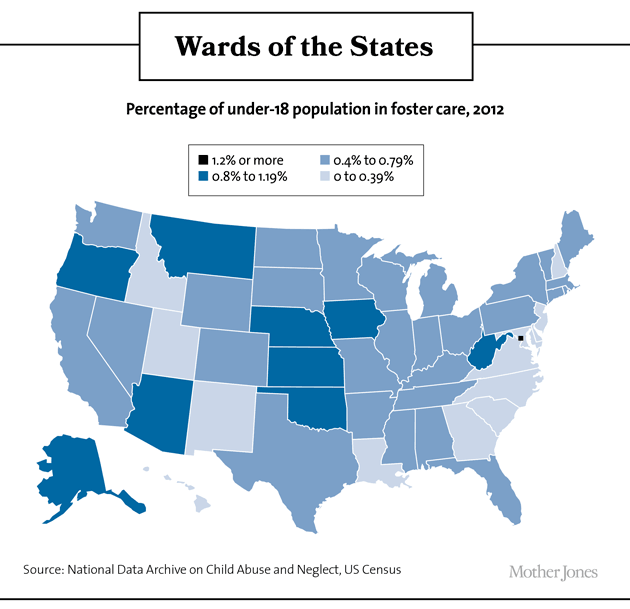
Approachable Foster Family Agency, a small nonprofit in Merced, California, was a solid business proposition for Franklyn and Cynthia Vincent, the couple who established the agency in 2004. Cynthia's counseling business contracted with the agency while Approachable also paid both her and Franklyn six-figure salaries. By 2009, the Vincents and Cynthia's business combined were making half a million dollars from Approachable, more than 10 percent of the nonprofit's annual revenue.
But in the spring of 2010, Approachable faced a challenge: One of its foster mothers was demanding that the agency find a new home for three difficult children. The Dixon siblings—D.J., age eight; Dexter, four; and Shalea, one—had come from a volatile family that struggled with drug and mental-health issues. Both D.J. and Dexter had developmental disabilities; Shalea had respiratory problems. Approachable stood to lose as much as $2,600 in monthly revenue if it couldn't find them a new home.
The Vincents turned to Wendy Ford, a 42-year-old mother of eight who was already fostering an additional child through Approachable. The agency had inspected her four-bedroom house in Merced, but Ford told me the review was perfunctory. Several potential safety issues were left unaddressed, including the backyard swimming pool, which did not have a cover, and the fencing around the pool, which had no locks.
Ford says her foster parent certification only permitted her to house three foster children. But, she figured, if Approachable wanted her to take four, it must be okay. On March 31, 2010, the three Dixon kids moved into her home. Dexter made an immediate impression on her. "He had quite a personality," she told me. "He was just full of life."
Five days later, Ford's sister, who was also staying at the home, found Dexter floating facedown in the pool. He'd wandered out of sight for just a few minutes and apparently ridden a plastic toy right into the water.
First responders found Ford performing CPR on Dexter, both of them covered in his pink vomit. Miraculously, the child survived cardiac arrest and multiple organ failure. But he suffered such severe brain damage that he's not expected to be able to hold an entry-level job as an adult. Now nine years old, Dexter is a shell of his former self. "He has the frown lines of a 50-year-old," says his mother, Shalea Dixon, who regained custody of her children.
One afternoon last spring I watched Dexter and his little sister play outside in their cul-de-sac. While the little girl zipped about on a scooter, giggling and shouting, Dexter rode his bicycle in slow, careful circles, his face drawn and sad.
Ford, who was charged with felony child abuse for letting the boy wander away, ended up pleading no contest to misdemeanor child endangerment and got three years' probation. Approachable paid $825,000, without admitting liability, to help settle a civil suit brought on Dexter's behalf by a court-appointed attorney. (The money is now in a fund set up for his care.) Franklyn Vincent, Approachable's CEO, declined to comment.
The state, meanwhile, fined Approachable all of $500—not for the near-drowning or the cursory home inspection, but for failing to criminally screen Ford's sister. Subsequent inspections by the state of California found six Approachable homes that were over capacity and at least three with fencing or pool problems.
Michael Weston, a spokesman for the California Department of Social Services, bristled when I asked why the state didn't penalize Approachable more. "Can we shut down agencies? Of course we can. But it's not necessarily always in the best interest of everyone involved." Why not? "There's not a huge group of people trying to be foster parents right now, and that's a challenge—finding enough homes."
Dwight Robson, the chief public strategy and marketing officer at Mentor, comes from the public sector—before joining the company in 2003, he held several positions in Massachusetts state government and worked on Democratic campaigns, including John Kerry's Senate reelection bid. He told me that Mentor is a "mission-driven organization," its goal to help individuals—foster children and adults with disabilities or severe brain injuries—live in residential settings. He stressed that providing quality services to clients was the company's No. 1 priority, and he noted that in fiscal year 2014 alone, it closed 869 foster homes over concerns about their "fitness" to care for children.
Robson dismissed the complaints of the former employees I spoke with, saying that Mentor employs about 22,000 people nationwide, many of whom have had long tenures with the company. Incidents like the death of Alexandria Hill, he said, are tragic but "extremely rare."
William Grimm, a senior attorney at the California-based National Center for Youth Law in Oakland, agreed that it's virtually impossible to prevent the occasional incident. "I don't think you could have a perfect system," he said. "Unfortunately, there's going to be a few people that squeak through."
Robson told me that Mentor implemented new policies in response to Alexandria's death, and that Texas Mentor voluntarily stopped taking new foster children until the case could be reviewed by authorities. Robson said Mentor staff "misjudged the character and commitment" of Sherill Small; the company has also admitted to missing that Small had an outstanding warrant for passing a bad check and failing to background-check her daughters, who frequented the home and had criminal recÂords of their own. "Clearly, we didn't do our job," Robson said. "That's a fact, and one that we're not going to run from."
I attended Small's trial last fall, in the high-ceilinged old courthouse in Cameron, Texas. The proceedings were repeatedly interrupted by the piercing sounds of a train whistle from tracks less than a block away. The three male attorneys wore cowboy boots; the one female, pink high heels. Small slumped before a box of tissues, occasionally pushing up her glasses to dab her eyes.
For the jury, Milam County District Attorney Bill Torrey displayed a blown-up photograph of Alexandria, taken just days before the incident. In it, the little girl wears a canary yellow tank top, her pale skin ghostly in contrast to the brown puppy she's clutching. Alexandria looks into the camera without smiling. "We are here because on July 29, 2013, Sherill Small murdered Alexandria—I'll call her Alex—Hill," he intoned.
Over the next week, the jury would learn that Small changed her story about what happened several times, first claiming that the child simply fell, then saying that she was running backward and fell, finally saying that she let go while swinging Alexandria by the arms. Jurors then watched an interrogation video where Small said she had been lying the whole time, that the real story was that she had been swinging the child over her head and accidentally dropped her on the floor. Several medical experts testified that Alexandria's injuries were inconsistent with that story or any of the other ones, but were indicative of abuse. A police officer and an emergency room doctor also reported that Small didn't inquire about the girl after she was rushed to the hospital. Witnesses repeatedly said they didn't see Small cry.
But the most damning testimony for Small—and Mentor—came directly from Small's family. Small's sisters testified that Small didn't seem to like Alexandria. Police photos showed that Alexandria's room was devoid of toys or decorations, while a room used by Small's teenage granddaughter was decked out with pictures, a zebra-striped blanket, and a Pikachu doll.
The jury also heard that Small hit one of her own daughters when the girl was just two years old, giving her a black eye and a knot on the head when she fell. Meanwhile, Small's granddaughter admitted that Sherill and Clemon concealed from Mentor that a family friend, who had not been screened, sometimes stayed in the house. Clemon testified that he didn't know Mentor's guidelines on timeouts—no more than one minute for every year of age. Under Mentor's own rules, Alexandria shouldn't have been in timeout longer than two minutes. Taken together, the testimony suggested that Mentor didn't really know the Smalls or what was going on in their home—or, for that matter, what had happened to Sherill herself when she was in foster care.
A psychological assessment painted a grim picture of what Sherill described as a "very sad" childhood. It said she was frequently spanked or put into isolation for things she hadn't done. It got so bad that in her early teens, Sherill ran away from her foster home to live with a man who repeatedly raped her. Sherill told the psychologist that she preferred living with the man because she was "actually treated better and not beaten or left outside." Sherill reported feeling depressed most of her life and attempting to kill herself once. She also testified that she had a son whom she gave up for adoption "because I was real young, I didn't have a place to live, and I wasn't going to have him live on the street." Mentor's background screening never found out about him either.
In early November, the jury found Small guilty of capital murder, sentencing her to life without parole. The verdict was the biggest legal victory in the career of assistant district attorney John Redington, but he told me afterward that the win felt hollow. "We get vengeance on these people and it makes us feel better temporarily," he said. "But true justice would be making real change in the system so no kid is ever put through this kind of nightmare again."
Source: Mother Jones
Fun With Foster Boy
March 10, 2015 permalink
Pennsylvania foster mom Dana Fouse had sex almost daily with a teenaged boy in her care. The affair lasted nearly eleven months while the boy was in her home, and continued by cell phone after he was relocated.
expand
collapse
Former foster mother charged with sexual relationship with foster son
Police say Dana Fouse, 38, had sex with teen in her Hyde Park home
HYDE PARK, Pa. —A Westmoreland County woman is charged with having an ongoing sexual relationship with her former foster son.
Dana Fouse, 38, of Hyde Park, is charged by state police with statutory sexual assault, involuntary deviate sexual intercourse and other charges related to the alleged crimes. Investigators said they interviewed the teenage boy, who claimed the two had sex almost every day for nearly 11 months.
"The defendant told the victim that she was unable to become pregnant," state police wrote in an affidavit of probable cause. "She would also periodically tell the victim not to tell anyone of their sexual relationship and also told him not to drink alcohol so he wouldn't accidentally tell anyone of their relationship."
Police said Fouse's own children were sometimes present in the home, though in different parts of the home, when the sexual acts would occur.
Investigators said the relationship ended after the boy was moved into a new foster home, but that Fouse bought him a cellphone and mailed it to him so he could still communicate with her. It was after the new foster family found the phone that the boy confessed to the relationship, investigators wrote in the affidavit.
The Westmoreland County Children's Bureau is listed as the contact on the state website for those inquiring about foster parenting, but bureau director Shara Saveikis said the bureau only oversees children from Westmoreland County who are placed in the foster system.
Because of privacy rules involving foster children, Saveikis said she could not confirm or deny if the victim in this case was a foster child from Westmoreland County or another county. Saveikis did confirm Fause was not licensed by the bureau, so she would not have been managed by the bureau, rather by the agency from where she was licensed.
The state-run website on the foster program states all potential foster parents must pass extensive background checks. "To ensure the child's safety, the agency will conduct a criminal background check and child abuse clearance on everyone in your home, age 14 and over," according to the site, adoptpakids.org.
Fouse remains free on bond while she awaits a preliminary hearing in April.
Source: WTAE Pittsburgh

Motherisk Suspended
March 10, 2015 permalink
The controversial Motherisk program has been suspended by Toronto's Hospital for Sick Children. While new testing will not take place, there are so far no plans to undo false convictions or false child removals based on old Motherisk tests. Links to earlier articles: [1] [2] [3] [4].
expand
collapse
Sick Kids suspends Motherisk’s hair drug testing
The Hospital for Sick Children cites questions that arose in its own review of the Motherisk lab in suspending the program, pending the results of a provincial review.
The Hospital for Sick Children has suspended its controversial Motherisk drug and alcohol hair-testing program amid new questions about analyses carried out by the laboratory, which have been presented as evidence in an unknown number of child custody and criminal cases.
The decision, which comes in the wake of a Star investigation, has potentially wide-reaching implications — both for child welfare agencies that rely on the testing as proof of parental substance abuse and for cases that have hinged, in some part, on Motherisk’s results.
In a statement Thursday, Sick Kids said that “questions have arisen that require further analysis” amid an ongoing provincial review and an internal probe of the hair-testing program. As a result, it is halting “all non-research operations” at the Motherisk lab, pending the results of the independent review, announced last November.
“Today’s move seems to be an acknowledgement that the work done at Motherisk might have led to wrongful convictions and miscarriages of justice in some cases,” said Toronto defence lawyer Daniel Brodsky, who sits on the board of the Association in Defence of the Wrongly Convicted.
“It’s highly unfortunate that it took an internal audit to underscore how serious the forensic mess could be,” Brodsky said.
The hospital declined to provide further details about the questions that have arisen or the extent of operations that have been suspended.
Toronto lawyer James Lockyer, whose appeal court case cast doubt last year on the reliability of hair drug test results presented by Motherisk at a 2009 criminal trial — and prompted the Star investigation — described the hospital’s announcement as “a relief.”
“The work that they do should be done by a properly accredited forensic laboratory,” Lockyer said. “I never understood how Motherisk slipped through the cracks and became such an important part of our justice system, without those kinds of checks and balances that forensic accreditation requires.”
Motherisk is an accredited clinical lab — a designation that has less rigorous requirements than a forensic lab.
The Ministry of the Attorney General launched a review of five years’ worth of hair drug tests performed by the Motherisk program, between 2005 and 2010, after Star stories raised concerns about the reliability of hair test results, which have been routinely accepted without challenge in Ontario courts.
Health Minister Eric Hoskins said he has “full confidence” in the provincial review being carried out by retired justice Susan Lang.
“She will provide us with a report that answers the questions that need to be answered,” he said.
Last month, the Innocence Project at York University requested that the province expand the scope of the review to include more recent cases, citing the custody dispute involving a Toronto-area mother who received a false-positive hair drug test result from Motherisk last year.
According to Katharina Janczaruk, chair of the Family Lawyers’ Association, the erosion of trust in the Motherisk hair testing program has already had a profound effect.
“Cases are not being referred to them because no one has confidence in them,” Janczaruk said. “Sick Kids is doing officially what has already been done to them.”
Caroline Newton, spokeswoman for the Ontario Association of Children’s Aid Societies, said the organization has developed a list of alternative labs that perform hair drug and alcohol tests.
Newton stressed that hair tests are only one of many investigative approaches used by child-welfare agencies to determine what’s best for children. When it comes to ongoing cases that used Motherisk hair test results, she said, “each case will be looked at on its own merit.”
Hoskins said he still stands behind other work being done by Motherisk, such as counselling women and their doctors on substances that are safe to take while pregnant.
NDP Children and Youth Services critic Monique Taylor said the Sick Kids announcement “raises many questions about (hair) tests performed up to the present day … and families deserve to know just what is going on.”
“The government needs to tell Ontarians what they know about the tests that were done by Motherisk,” she said in a statement.
Questions have been swirling around Motherisk’s hair testing program since October, when a Court of Appeal overturned the cocaine convictions of Toronto mom Tamara Broomfield.
Broomfield was sentenced to seven years in jail after Motherisk director Gideon Koren testified at her 2009 trial that tests of her young son’s hair showed that he had regularly consumed large doses of cocaine for more than a year leading up to a 2005 overdose that left him brain-damaged.
The appeal court tossed out the cocaine convictions after an expert witness for the defence criticized the methods used by Motherisk to prepare the boy’s hair sample, the methodology used to analyze it and the validity of the results presented at trial.
Broomfield has abandoned her appeals of other child-abuse convictions related to the boy.
Source: Toronto Star
Social Worker Rapes Ward
March 10, 2015 permalink
Newmarket social worker James Malcolm is accused of sex with a girl who was one of his wards. Remember that a social worker has complete control over the life of his wards, and they are not in a position to say no to any advances.
expand
collapse
Newmarket social worker, 64, accused of sexual relationship with teenager
A 64-year-old Newmarket man is charged with several sexual offences stemming from an alleged relationship with a teenage girl.
York Regional Police began investigating March 8 after a man complained his daughter was involved in a sexual relationship with a case worker. Police arrested the case worker later that day.
The accused has been employed in social services for about 26 years and had contact with many teenagers in that time. Police believe he may have had inappropriate relationships with other teenagers.
James Malcolm is charged with five counts of sexual assault, five counts of sexual interference and five counts of invitation to sexual touching.
He was scheduled to appear before the Ontario Court of Justice in Newmarket March 9.
Source: Metroland / York Region
More Foster Care
March 7, 2015 permalink
In the last legislature Rod Jackson proposed a bill to extend the age of foster care. It died when the legislature was dissolved for a new election, one in which the voters turfed out Mr Jackson.
But rejection by the voters never stops children's aid. Jim McDonell, the MPP for Stormont-Dundas-South Glengarry, wants to achieve the same effect with a private members bill to extend the age at which children can enter foster care from sixteen to eighteen. The article based on his proposal shows only one side. He wants teenagers to have an alternative to life on the street. As usual for this kind of advocacy, the article contains a misrepresentation. The quoted cost of foster care, $1000 per month, is what foster parents are paid. The taxpayers pay CAS nearly triple that amount. The difference is the vigorish supporting the agency.
expand
collapse
MPP McDonell advocating for teens in need
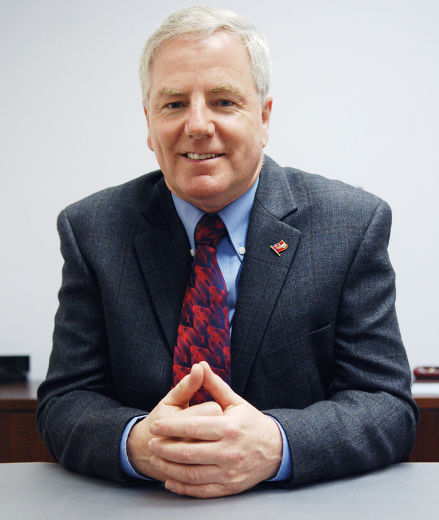 MPP Jim McDonell.File photo
MPP Jim McDonell.File photoLocal MPP Jim McDonell wants to find a better place for parent-less older teens than the "street" or "couch-surfing".
McDonell is introducing a private member's bill into the Ontario legislature Thursday in the hopes of securing safer surroundings.
The bill would resurrect a previously discarded attempt by former MPP Rod Jackson, a Progressive Conservative colleague who was defeated in the June 2014 election.
In 2013, then Liberal Child and Youth Services Minister Theresa Piruzza advocated for Jackson.
McDonell said the value of his new bill still remains valid.
"If a child comes into the (Children's Aid Society), the CAS cannot take them when they're 16 or 17 (years old)," McDonell said.
An 18-year-old is considered an adult, but even adults as old as 21 can receive CAS assistance if they had been client before the age of 16.
"We're talking kids in Grade 10-11-12 who are in need through no fault of their own, whether it's abuse or death of a (parent).
"They have no place for them, so they're looking for a place to sleep."
Worse yet, some teenagers get so desperate they turn to crime to support themselves or drop out of school to find a job.
McDonell said he has no local figure to estimate how many 16-17 year olds would benefit.
Jackson's bill had already been well received by the New Democrats and advocates with the Ontario Association of Children's Aid Societies, the Justice for Children organization that supplies legal aid for youth, as well as representatives from the Youth Leaving Care hearings of 2011.
NDP MPP Monique Taylor had said that approximately 8,300 youth had requested the provincial government not cut them off at age 18 during the Youth Leaving Care hearings.
Taylor also noted that other government legislation, such as Age of Majority, the Education Act and the Law Reform Act, consider teenagers to be children until the age of 18.
"It's time to bring the Ontario child welfare system in line with other laws," she said in the fall of 2013.
McDonell said there might be an extra cost to CAS budgets, but this would be far-outweighed by additional costs as a result of homelessness, incarceration and policing.
Meanwhile, the average CAS cost for care each month is $1,000.
Source: Cornwall Standard Freeholder
Unsubstantiated Neglect
March 7, 2015 permalink
The Meitiv case has gone viral on the internet and in the press. All of the reporting is favorable to the family. In a letter dated February 20, 2015 (pdf) the family has been found to have committed unsubstantiated neglect. Source for letter. On the pre-printed form the "ruled out" option was not checked. The parents will remain under watch for at least five years. A Washington Post article is enclosed.
expand
collapse
‘Unsubstantiated’ child neglect finding for free-range parents
The Maryland parents investigated for letting their young children walk home by themselves from a park were found responsible for “unsubstantiated” child neglect in a decision that has not fully resolved their clash with authorities over questions of parenting and children’s safety.
Danielle and Alexander Meitiv hoped the nationally debated case — which has lit up social media and brought a dozen television film crews to their Silver Spring home — would be dismissed after a two-month investigation by Montgomery County Child Protective Services.
But the finding of unsubstantiated child neglect means CPS will keep a file on the family for at least five years and leaves open the question of what would happen if the Meitiv children get reported again for walking without adult supervision.
The parents say they will continue to allow their son, Rafi, 10, and daughter Dvora, 6, to play or walk together, and won’t be swayed by the CPS finding.
“We don’t feel it was appropriate for an investigation to start, much less conclude that we are responsible for some form of child neglect,” said Danielle Meitiv, who said she and her husband plan to appeal and worry about being investigated again by CPS.
 click for larger imageThe Meitiv children outside the National Gallery of Art in Washington, D.C., in January 2015.Family photo
click for larger imageThe Meitiv children outside the National Gallery of Art in Washington, D.C., in January 2015.Family photo“What will happen next time?” she asked. “We don’t know if we will get caught in this Kafkaesque loop again.”
The case dates to Dec. 20, when police picked up the two Meitiv children walking in Silver Spring on a Saturday afternoon after someone reported them. The parents said that they gradually let the pair take walks on their own and that their children knew the area, which is along busy Georgia Avenue.
The Meitivs said they would not have allowed the one-mile outing from Woodside Park to their home if they did not feel their children were up to it. The siblings made it halfway before police stopped them.
The Meitivs’ decision letter, dated Feb. 20, said the CPS investigation had been completed and would be closed. It cited a finding of unsubstantiated child neglect and made note of an appeals process.
Montgomery County Child Protective Services officials referred calls Monday to state officials. Paula Tolson, spokeswoman for the Maryland Department of Human Resources, said the state cannot comment on specific cases because of confidentiality requirements.
Tolson said as a general practice, CPS officials in Maryland reach one of three possible findings after neglect investigations: ruled out, unsubstantiated or indicated.
An unsubstantiated finding is typically made when CPS has some information supporting a conclusion of child neglect, or when seemingly credible reports are at odds with each other, or when there is insufficient information for a more definitive conclusion, she said.
Tolson said a conference involving a CPS supervisor is the first step of the appeals process in cases of unsubstantiated neglect. It can often resolve some issues, she said.
Asked how authorities would respond if the children were reported again for walking unsupervised, she said CPS would become involved if a complaint was made about the safety of the children. In such cases, “if we get a call from law enforcement or from a citizen, we are required to investigate. Our goal is the safety of children, always.”
The Meitivs’ case has produced strong reactions about what constitutes responsible parenting, how safe children really are and whether the government overstepped its role.
The Meitivs, both scientists by training, embrace a “free-range” philosophy of parenting, believing that children learn self-reliance by being allowed to make choices, build independence and progressively experience the world on their own.
Though children have played unsupervised for generations, the so-called “free-range” movement goes back to 2008, when New York journalist Lenore Skenazy wrote a piece titled “Why I Let My 9-Year-Old Ride the Subway Alone.”
Skenazy, who developed a following for pushing back against what many see as a culture of helicopter parenting, said Monday that the Meitiv case follows others that raise similar issues but that it became the “walk heard round the world.”
“I think it has shifted the national narrative,” she said, suggesting that people have reacted with more concern about government intrusion and less focus on predator danger.
“The go-to narrative in the last 20 or 30 years for parents was, ‘Take your eyes off your kid for even a second and he’ll be snatched.’ What the Meitiv case did was pivot the story to: ‘Give your kid one second of freedom and the government will arrest you.’ ”
Russell Max Simon, co-founder of Empower Kids Maryland, created just after the Meitiv case became public in January, called the CPS decision “flat-out ridiculous” for holding parents responsible for an unsubstantiated claim.
“All of us were hoping sanity would prevail and they would drop it,” he said. “My feeling is that CPS should not have been involved in this in the first place.”
[Parents investigated for neglect after letting kids walk home alone]
The Meitivs received the CPS letter last week, they said, but consulted with a lawyer before speaking publicly.
Danielle Meitiv said when she first read the decision, she felt numb. As she reread it, she recalled turning to her husband and saying: “Oh my God, they really believe we did something wrong.”
“I was kind of horrified,” she said, adding: “You try as a parent to do what’s right. Parents try so hard. Even though I know they are wrong, it’s a painful judgment.”
She said that while the terminology of being “found responsible” for “unsubstantiated child neglect” is difficult to interpret, she and her husband do not feel they have been cleared in the case. She called the decision inconceivable and outrageous.
“There’s no question this is some kind of finding against us,” she said.
The Meitivs say they have let their children walk together to a park a block away, to a nearby 7-Eleven and to a library three-quarters of a mile from their house. Lately the children walk home from their school bus stop.
They say that when CPS started its investigation, on the day of their children’s walk from the park, Alexander Meitiv was asked to sign a form saying he would not leave the children unsupervised until CPS followed up. When he resisted, saying he wanted to talk to a lawyer, he was told that if he did not sign, the children would be removed, the Meitivs said.
CPS officials have said they are guided in part by a state law that says children younger than 8 must be left with a reliable person who is at least 13. The law addresses children locked or confined in a building, dwelling, motor vehicle or other enclosed space, but does not mention children outdoors on a walk.
Danielle Meitiv said that in spite of the decision, her children played at a nearby park by themselves Monday, when schools were closed for the snow day. They came home with a lost dog, and the family found its owner.
Source: Washington Post
Baby Seized
March 6, 2015 permalink
Mother Elizabeth Amyot had her baby Liam seized from her Leamington home yesterday in a case that will come to court on Monday.
expand
collapse
Elizabeth Amyot
CAS ripped my life apart last night. My 20 month old son was apprehended due to my house not being cleaned to their standards. I have severe generalized anxiety disorder and PTSD they ripped him from my arms while I was in a panic attack the police officer badly sprained my wrist I met with a lawyer today my house is now cleaned and I got my landlord to get me new smoke detectors court is on Monday and I'm a mess
They were called because apparently my neighbor heard Liam crying for two hours straight and my dogs who are both a service dog and an emotional support dog were vicious the neighbor doesn't like me because I won't share my internet with him calls me a bitch every time he sees me and gloated last night that he called on me
The worker also took my son out of my house in light cotton two piece PJs no socks no blanket no jacket no nothing did not give me a chance to calm down to tell her about his medications nothing
From a previous false call they had it in their files that no house visits were to take place unless my mom was here to prevent me having a panic attack
Source: Facebook, Stop the CAS ...
Foster Dad Dead
March 6, 2015 permalink
Joseph Charles Todd Dunn was a foster parent in Georgia when a child died in his care. Russell Charles Chapman was twenty months old at his death on October 3, 2010. A grand jury refused to indict Mr Dunn and he remained free. But detectives persisted and gathered new evidence. Last September Mr Dunn found out he was about to be indicted by another grand jury and fled to Canada. Canadian authorities kept him in jail, and a few days later he was dead. The full circumstances of his death have not been disclosed.
Perhaps Dunn got what he deserved. Exposing a convicted, or even accused, child killer to prison inmates is a death sentence. But the prosecution of Dunn fits another pattern. When a foster death is published, as Chapman's death was, social workers leave no stone unturned to accuse someone outside their own offices. The conviction of a foster parent draws attention away from the failures of the system that placed the child in the dangerous setting. What really happened in the Dunn case? We may never know, but an inquest into his death could answer some of the questions.
expand
collapse
Dead inmate was fleeing justice in U.S. 3
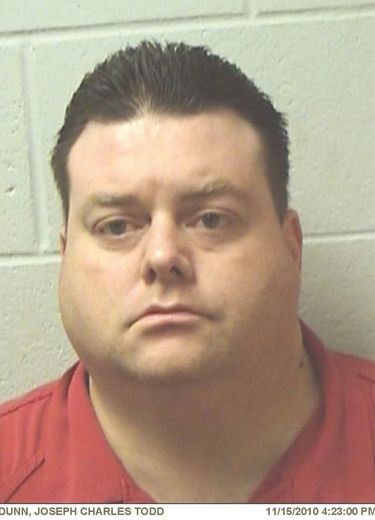 Joseph Charles Todd Dunn died while in custody of the CBSA. He was being held at Niagara Detention Centre in Thorold.Photo courtesy of Henry County Sheriffs Office.
Joseph Charles Todd Dunn died while in custody of the CBSA. He was being held at Niagara Detention Centre in Thorold.Photo courtesy of Henry County Sheriffs Office.The regional coroner is still working out the details of an inquiry into the death of a Georgia man at the Niagara Detention Centre.
Joseph Charles Todd Dunn, 43, was indicted in September on charges of child cruelty in connection with the death of his 20-month-old foster son in Locust Grove, Ga., south of Atlanta. He fled, crossed the border in Niagara and filed a refugee claim.
He was in taken into custody by the Canadian Border Service’s Agency and sent to the detention centre.
“From my perspective, we are planning to go ahead with this inquest,” Dr. Jack Stanborough, the regional coroner said.
Dunn spent five days at the Greater Niagara General Hospital on life support. He died without regaining consciousness. At the time, police said Dunn’s death was “not suspected to be the result of foul play.”
Both the CBSA and the police referred questions about Dunn’s cause of death to the coroner. Stanborough said the cause of death would be one of the questions examined at an inquest.
Dunn was originally arrested in November 2010 in Georgia and accused of shaking one of his foster children, Russell Chapman. Russell was admitted to hospital after “sustaining trauma to the brain,” the Henry County Police Department in Georgia said. The toddler’s death was ruled a homicide by the medical examiner.
Dunn was charged with both felony murder and first-degree cruelty to a child by the Crimes Against Children Unit of the Henry County police. However, after a hearing in 2010, a grand jury ruled there wasn’t enough evidence for an indictment.
“The first time, he wasn’t indicted by the grand jury, and he was released,” said Lieut. Joey Smith of the Henry County Police Department. “They (detectives) kept pursuing the investigation to gather more evidence.
“They were able to re-present it to a grand jury in the fall of 2014 and (Dunn) was indicted.”
The indictment meant a majority of grand jury members found there was enough evidence to justify a prosecution.
“He received word, some way, that he was about to be indicted and decided to flee,” Smith said.
Detectives from the Henry County Police Department and the U.S. Marshall’s office began a search for Dunn and discovered that he was attempting to leave the United States and enter Canada, Smith said.
Dunn drove to a Niagara border crossing and claimed asylum.
He was “ordered detained on the grounds he was inadmissible to Canada for reasons of serious criminality,” the CBSA said in an email. “Due to his serious criminality, the subject (Dunn) was housed at a provincial jail.”
Dunn appeared in front of the Immigration and Refugee Board for a detention review Sept. 22. He was ordered to remain behind bars because he posed a flight risk. He ended up in hospital later that day because of what Niagara police at the time said as a “serious injury sustained by an inmate.”
Det. Sgt. Paul Koscinski said the Niagara Regional Police have finished their investigation into Dunn’s death and the case is in the hands of the coroner.
Stanborough said he still has some details to work through.
“I have to ensure he was in custody at the time of his death, and I need that in writing,” Stanborough said. “There are some cases where officials recognize someone is going to die and release him from custody. It is an operative procedure that has done in the past to simplify things.
“I know it is a technicality, but it would make a difference if it is called as a mandatory inquest or given consideration as a discretionary inquest.
“If he was in custody — and I have little reason to suspect otherwise — the Coroner’s Act says a non-natural death in custody gets an inquest.”
Source: St Catharines Standard
Boy Seized for Religion
March 3, 2015 permalink
Danish authorities have forced a teenaged boy into a juvenile home over fears that his Muslim father would indoctrinate him in radical Islam. A few years of mistreatment in institutional care is unlikely to decrease the boy's esteem for his father. Next: climate deniers and heterosexuals.
expand
collapse
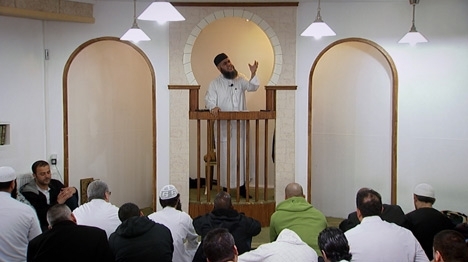 Authorities removed the boy from his home shortly after he began attending Grimhøj Mosque in Aarhus.Photo: Danmarks Radio
Authorities removed the boy from his home shortly after he began attending Grimhøj Mosque in Aarhus.Photo: Danmarks RadioRadicalization fear puts Danish boy into custody
Authorities have forced a 15-year-old Muslim boy into a juvenile home in an unusual move aimed at preventing him being radicalized by his father, a report said on Sunday.
Child care authorities in Aarhus feared that a 15-year-old Muslim boy's father might persuade him to travel to Syria to fight with Islamic extremists and placed him into care in September, Jyllands-Posten reported.
The paper said the local authorities forced the boy into a juvenile home after it emerged that he had begun to attend Grimhøj Mosque, notorious for refusing to denounce the terror group Isis and long suspected of radicalizing area youth.
"You cannot force a lone child into care due to a suspicion of radicalisation," the father's lawyer Tage Goettsche told Berlingske.
Researchers told local media the move was heavy-handed and that a juvenile home might radicalize the boy further through interaction with young criminals.
"You'd typically try to find a foster home," social scientist Hanne Hartoft at Aalborg University told news agency Ritzau.
By late last year Aarhus -- a city of only 324,000 residents -- sent as many as 30 people to fight in Syria. East Jutland Police have previously said that at least two dozen of the some 110 individuals who have left Denmark to fight in Syria have come from Grimhøj Mosque.
Measured per capita, Denmark is the second largest European source after Belgium of jihadist fighters going to the Middle East.
Just last week, German officials said they would charge Grimhøj Mosque imam Abu Bilal Ismail with incitement of hatred for anti-Semitic remarks he made in Berlin last summer.
The mosque was also the subject of a documentary from broadcaster DR last month, in which mosque leaders said that they want to see an Islamic caliphate established, that they don’t believe in democracy and that a Danish convert who carried out a suicide bomb attack in Iraq is a hero.
Following that documentary, the mosque requested police assistance after receiving a number of threats.
Two week after that, Grimhøj Mosque received rare praise from police and Aarhus authorities, who said that the mosque’s leaders have helped to slow the stream of Danish Muslims who travel to Syria as foreign fighters.
Source: The Local (Denmark)
London Rally
March 2, 2015 permalink
A Rally took place in London Ontario today. Two reports are enclosed. There is also a video, YouTube and local copy (mp4).
expand
collapse
London Ontario Canada March 02 2015 CA$ hires rapists
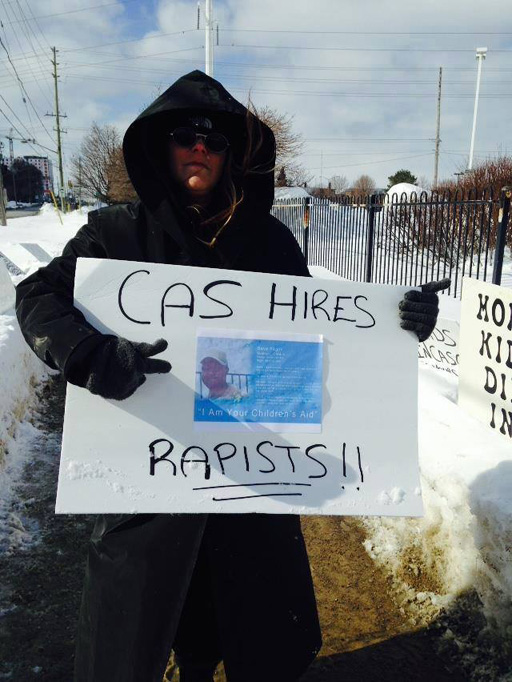
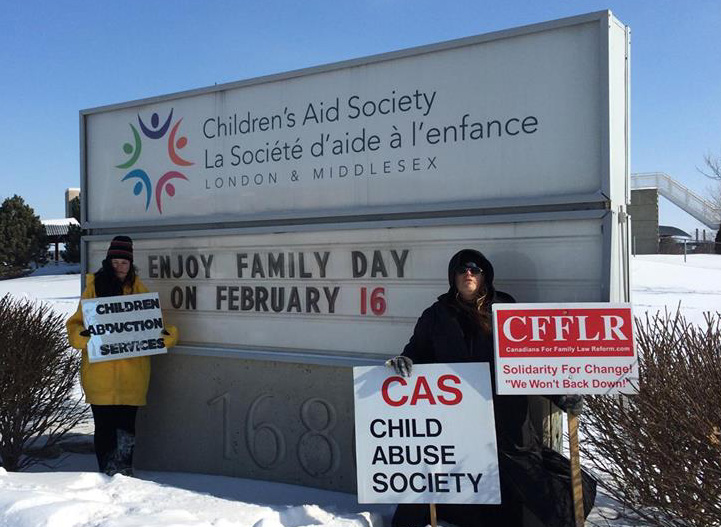
There was a rally today in London Ontario Canada March 02 2015, The Chidren's Aid Societies of Ontario are hiring rapists as employees, The Children's Aid Societies of Ontario are harassing abusing and murder children. The residents of Ontario for the last generations were a sleep of the evil within our mits, it is time for accountability and the abuse to stop by the hands of these societies.
If you are neutral in situations of injustices, you have chosen the side of the oppressor.
Source: Brainsyntax
Jen Mcmurray
Today was another successful day while we all exercised our rights to be heard! Even though it was only five of us there at the anti CAS Rally in London the point is that we have made our voices heard! We are not afraid to tell the truth about the injustices done to families & children by CAS! Last year the government bailed out CAS with millions of dollars having them commit to one thing & that was that they returned 80% of the children in care to their families. Has London CAS kept that commitment? No they have not! London CAS still has all those children in care while they beg the government for more money yet again! Well no more London CAS it's time that you do right by our families & return our children! I spoke with a long time volunteer driver for CAS this morning who fully supported what we were doing & knew my case personally even she agreed my children should have been returned long ago as well we spoke with another couple that was leaving the CAS office these people were foster parents who had quit working for CAS recently stating that they were sick of what CAS does to families & agreed that what we were out there doing was the right thing to do! Thanks for the support everyone maybe next time all the other advocates that said they would be there will show up!
Source: Facebook, Jen Mcmurray

